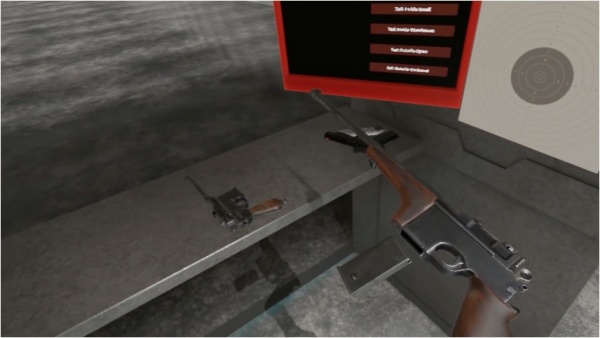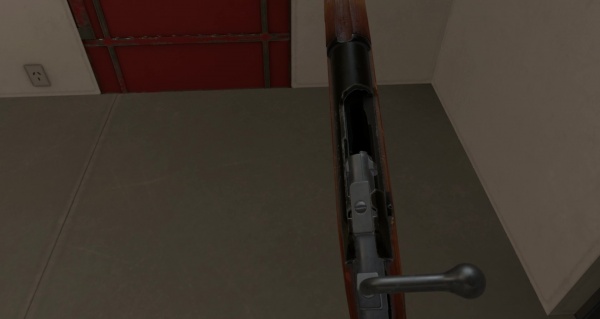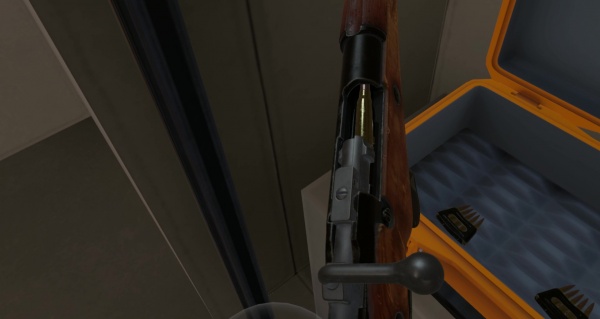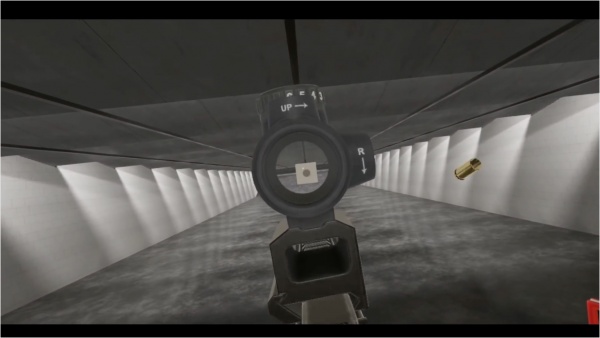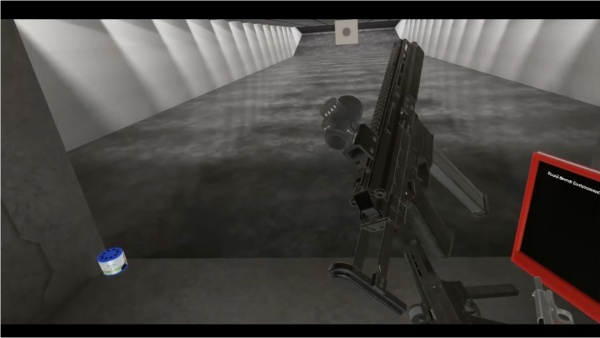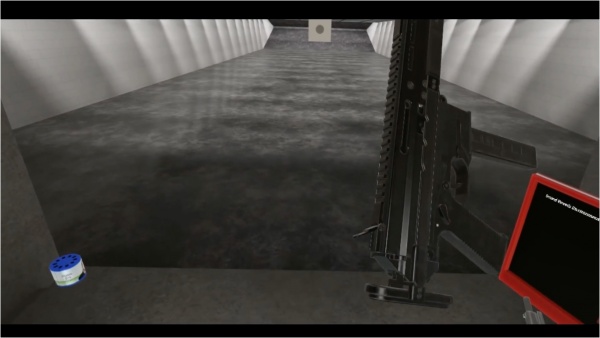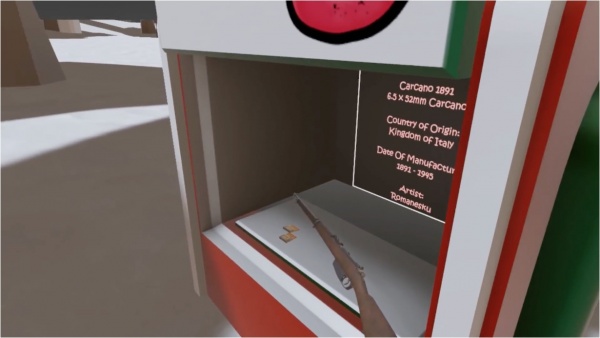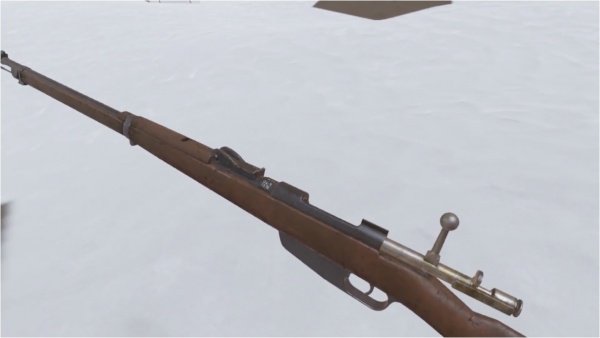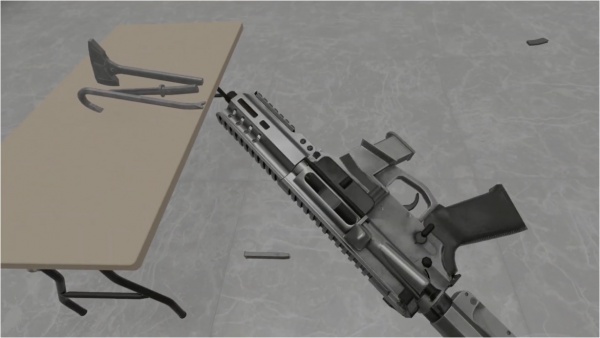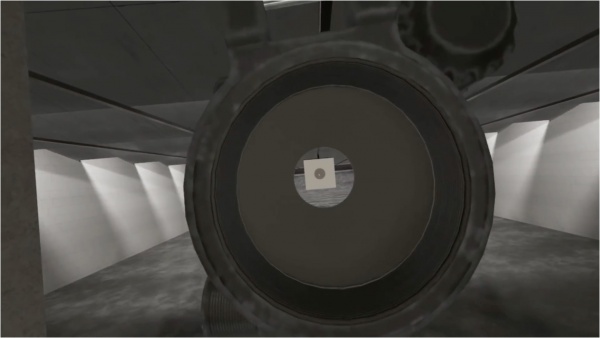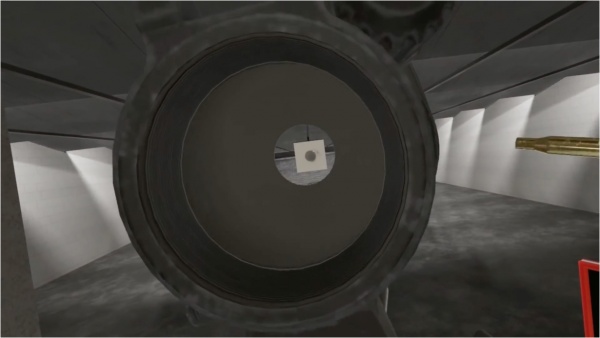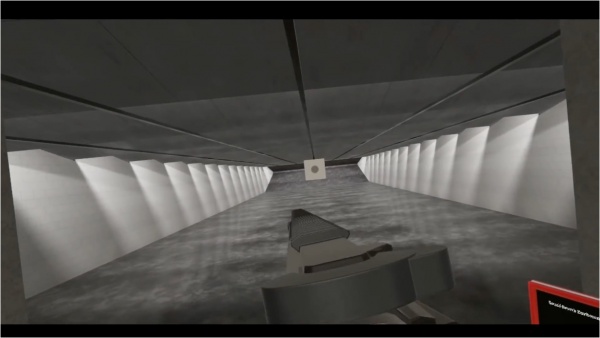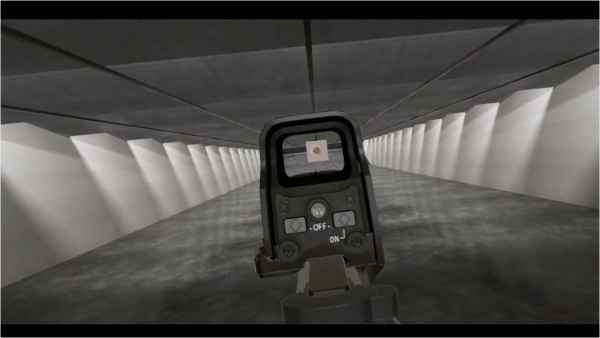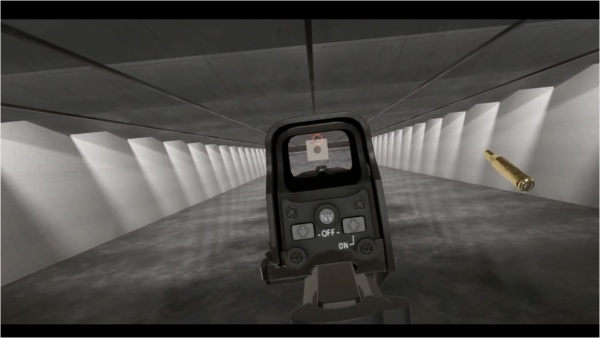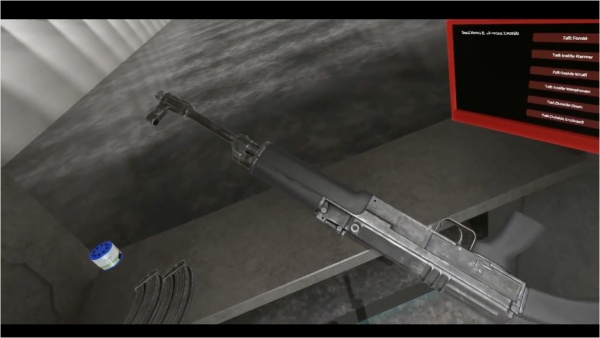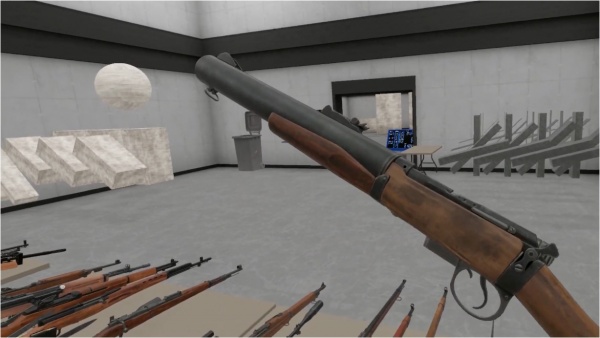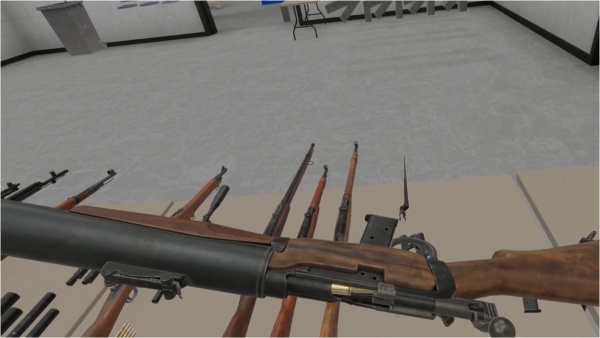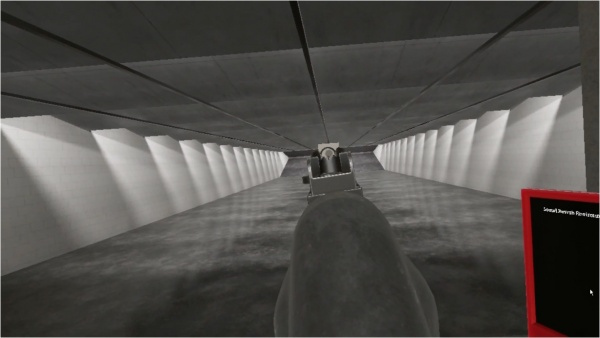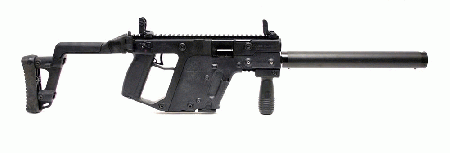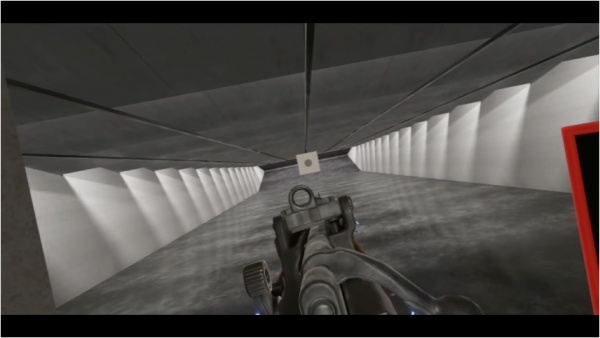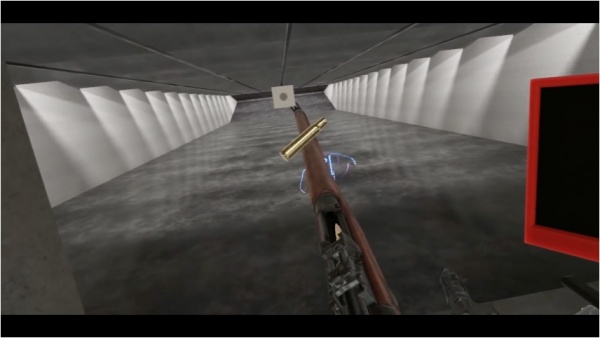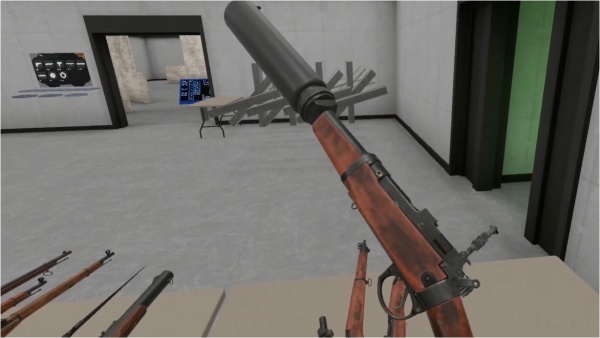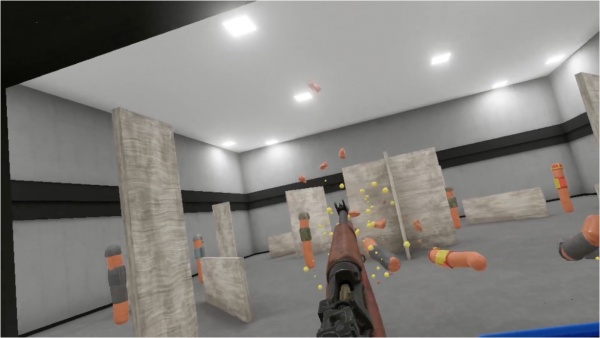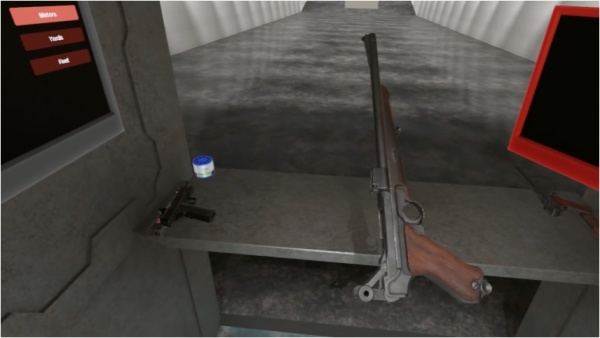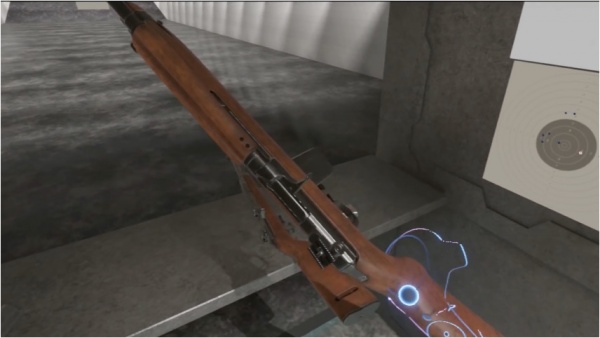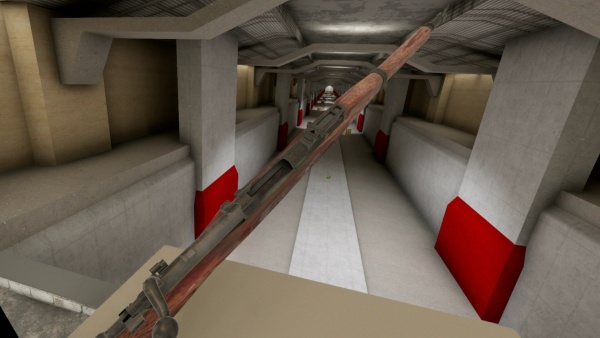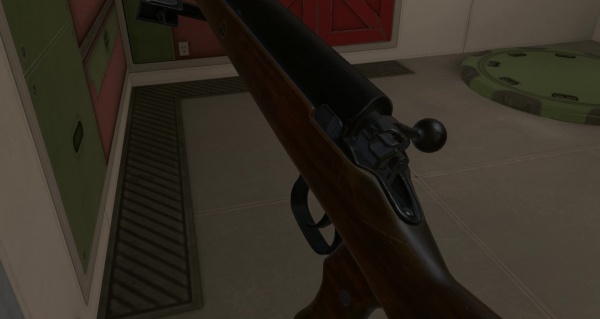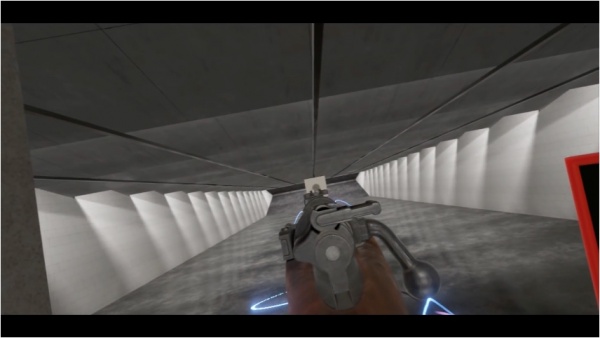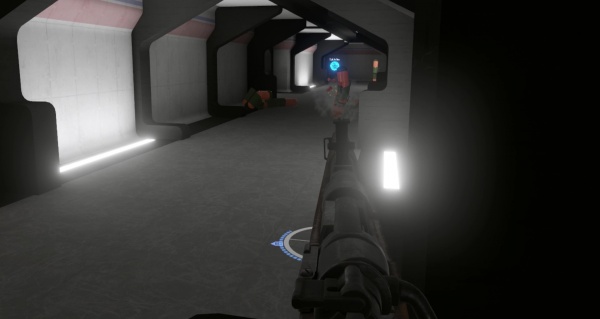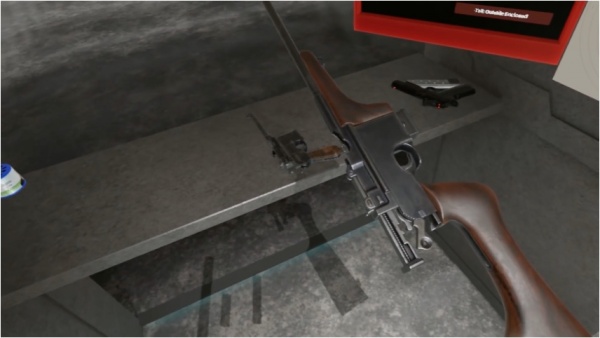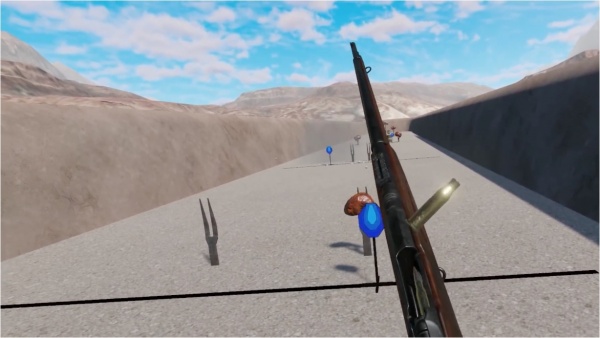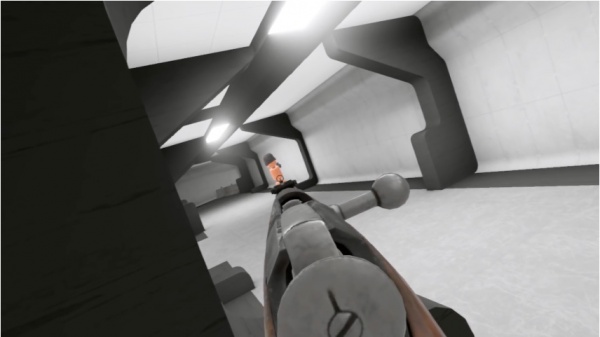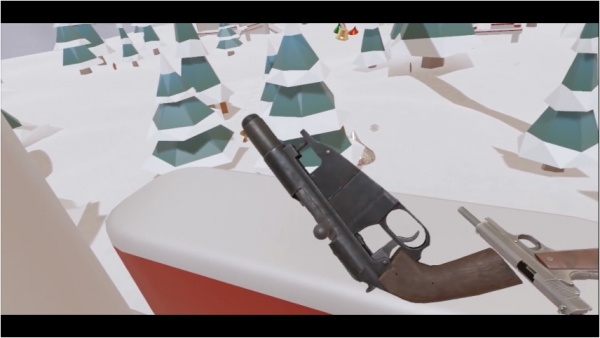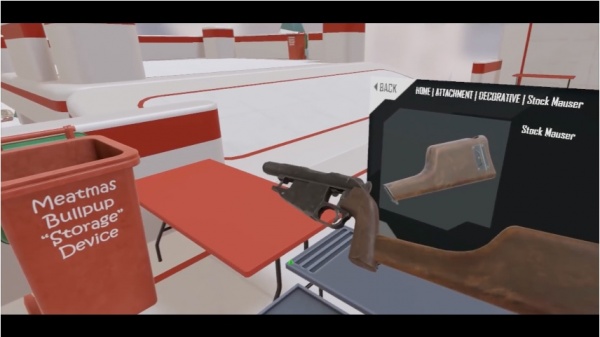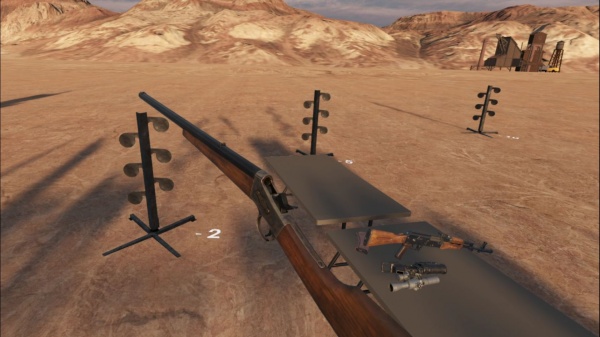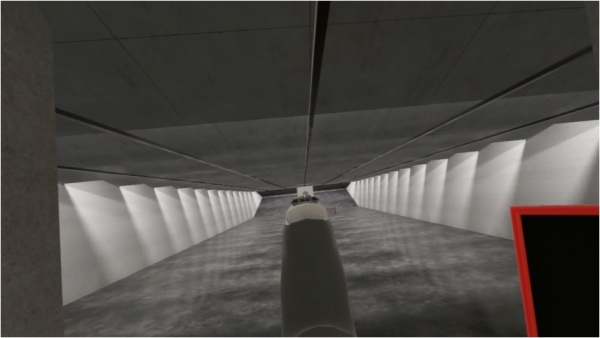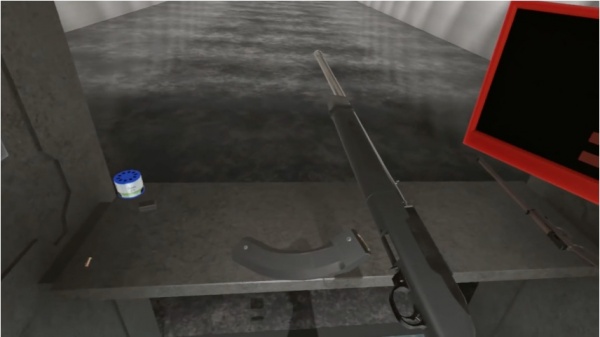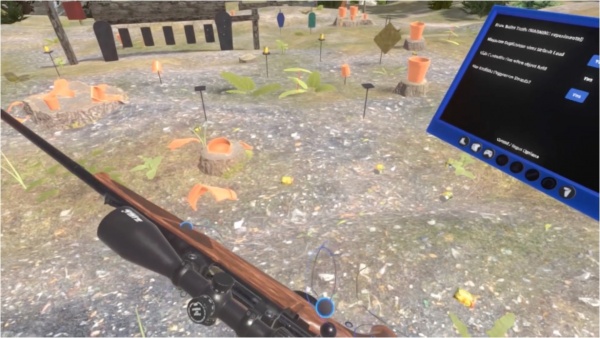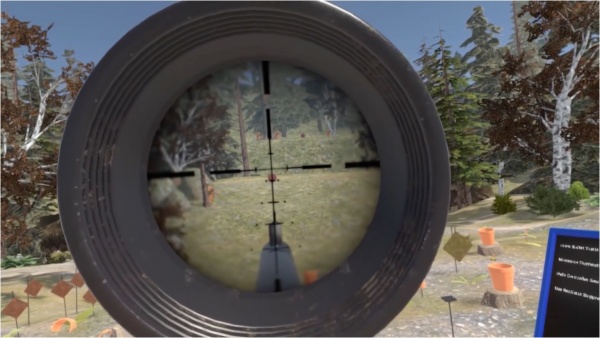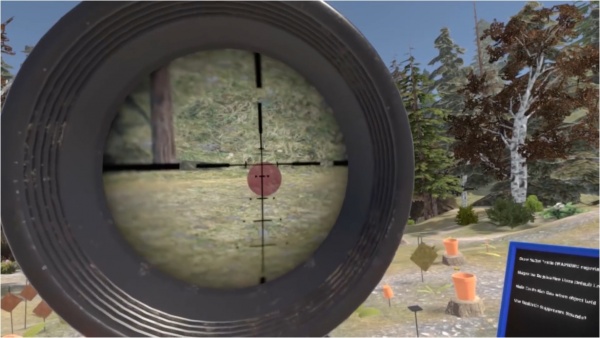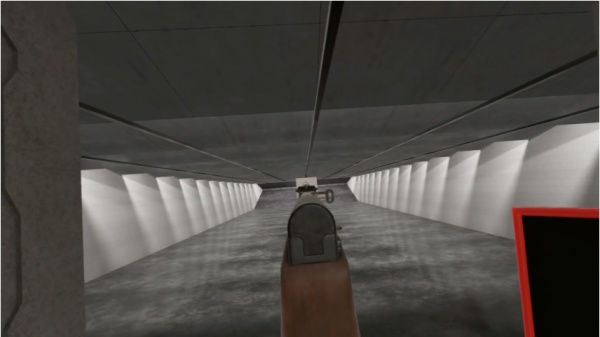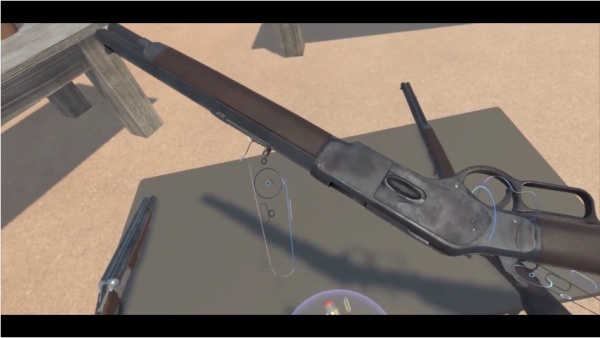Rifles & Carbines
Weapons on this sub-page are a mixed bag in terms of in-game classification; they span across the in-game categories of carbines, bolt-actions, lever-actions, breech-loaders, and even pistols (in both the automatic and bolt-action subcategories). The Carbine category includes any pistol-caliber carbine or intermediate carbine, as well as full-length intermediate rifles that are not fully automatic (such as the SKS or sporting rifles).
Armscor M1600
Added in Update #98 as a belated April Fools' Day present, the Armscor M1600 is available in two forms - the standard "M1600", and a modified version called the "M1600A3000", which features a collapsible wire stock, a full wrap-around handguard, an optics rail in place of the carrying handle, a shortened barrel, and a railed handguard.

Out at the range with the M1600. It's... well... I'm sure it has a great personality.
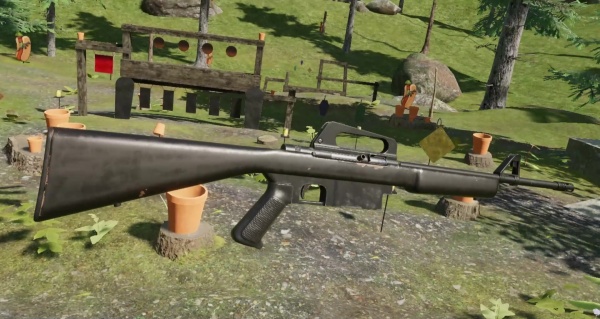
Yeah, for sure - underneath all that gradually-peeling black stock paint is a heart of gold.
"(And a lot of recessive alleles.)" "What was that?" "Nothing!"
Disengaging the M1600's simple two-position safety. Not trying to use that word in a derogatory sense or anything.

Loading in a...
(
"...is that really what it looks like? ...you sure? Alright... here we go, straight face...")
*ahem* Loading in a standard 15-round magazine; these are a proprietary design, with a STANAG-esque lower section that includes the magazine release, and an adapted target pistol magazine at the top.
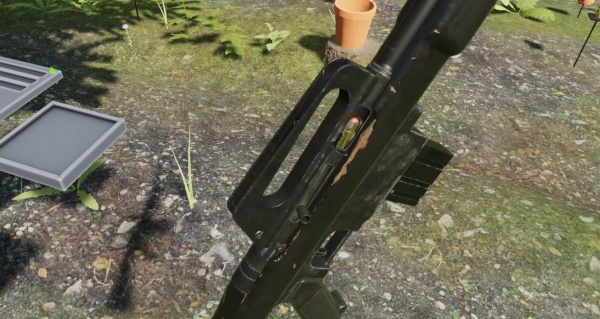
Pulling the charging handle; being...
derived from a typical tube-receiver .22 semi-auto design, this is a reciprocating affair, mounted on the right side.
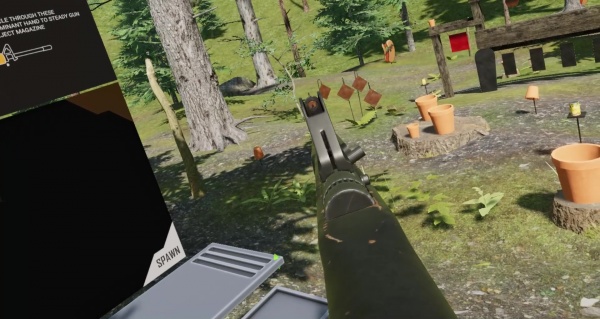
Aiming at a steel plate; the M1600 features M16-style sights that are surprisingly quite usable. Err... surprising if you didn't have high expectations of it, that is! Which I certainly didn't! Because I can tell a strong, brave, capable little gun when I see one!
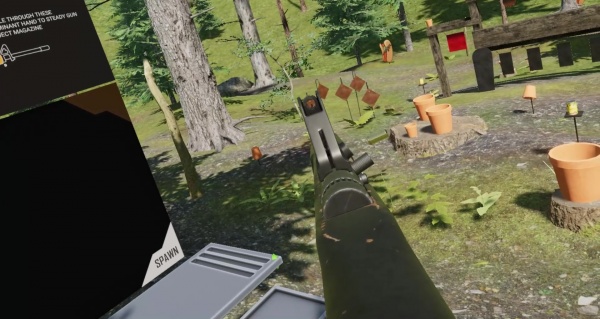
And, speaking of capable, here's the M1600 firing! Great job!
"(Not like you could really screw that up, no matter how-) Nothing! Just thinking about what I'm gonna do after work, that's all!"
Armscor M1600 with full wrap-around handguard and collapsible stock - .22 LR
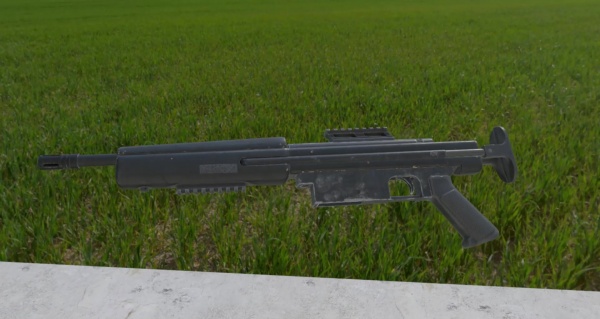
Behold, the weapon of the future!

Extending the M1600A3000's stock, after double-checking to make sure that there aren't too many zeroes in there.

Disengaging the safety. Note that it doesn't go all the way forward; this'll be important later.
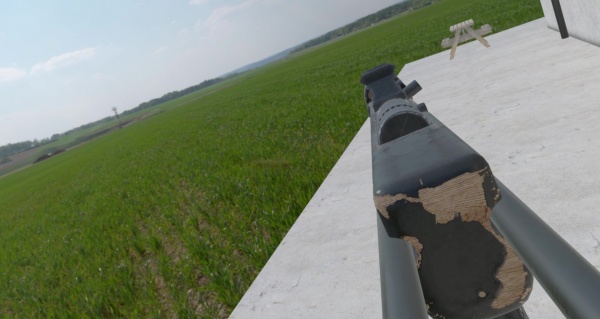
Aiming down the... hmm. Something's not right here.
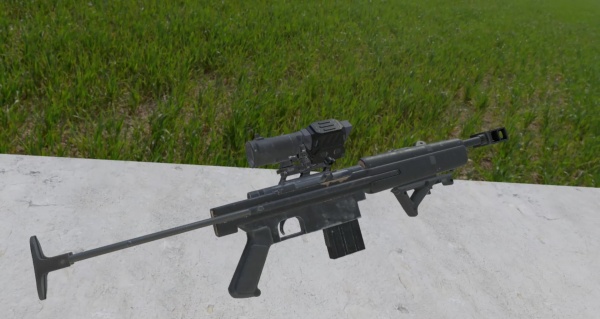
Hmmm... better, but still not quite there yet.
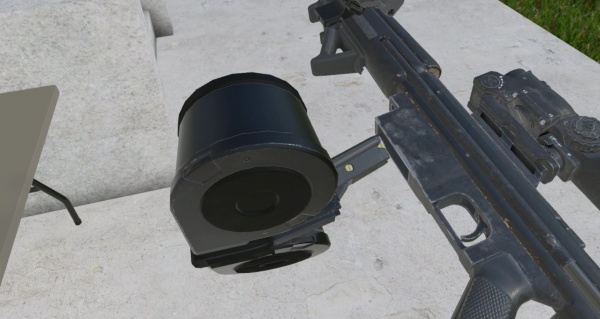
Ah-HAH! That's it, capacity! After all, who needs a 15-round box magazine when you can have a 150-round converted Beta-C! Which would really make it a Beta-C-and-a-half, I suppose.
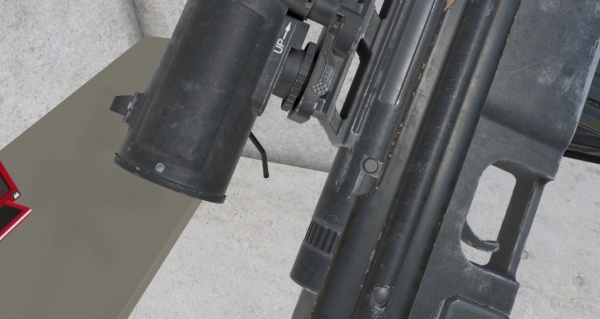
Fully disengaging the safety; the half-forward position on the A3000 is semi-auto, and the fully-forward position sets it to 3-round-burst. This technically makes it the game's second/third .22 LR submachine gun, depending on how you count the two American-180 variants.

Aiming at a hostile Sosig with 3 of the 4 available options - the ELCAN SpecterDR 4-power scope, canted DI Optical EG1 reflex sight, and AN/PEQ-15 laser sight are all in play, with only the backup irons on the ELCAN being left high and dry. Don't worry - they'll get their fun.
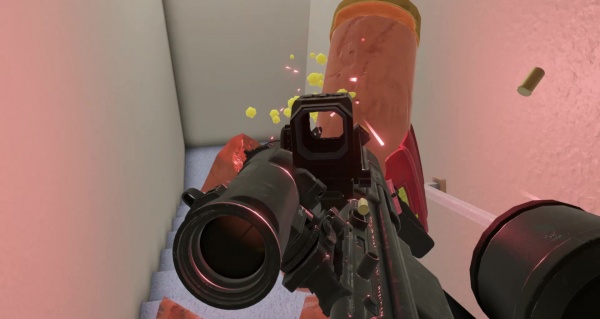
The breaching exercise went well for the breacher; unfortunately for this particular Sosig, his goals and the breacher's didn't exactly line up. Hence the present holiness of his face.
Bendix-Hyde 2nd Model Light Rifle
The second version of the Bendix-Hyde Light Rifle, a prototype carbine entered into the US Light Rifle Program trials, was made available in Update #52's 11th alpha build.
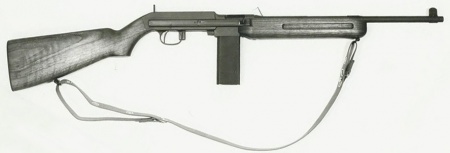
Bendix-Hyde Light Rifle (2nd Model) - .30 Carbine
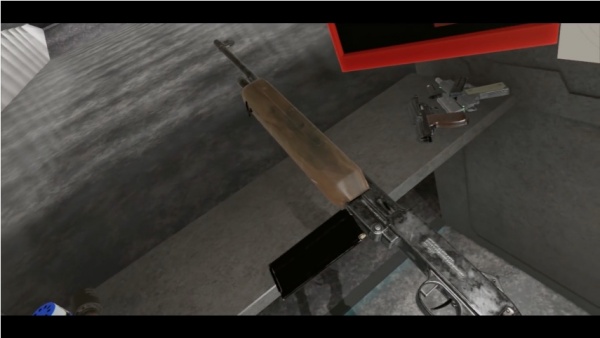
Jamming a magazine into the carbine...
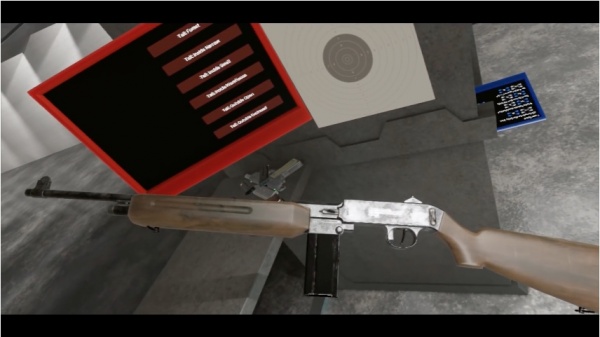
...before taking a good look at its...
interesting proportions.
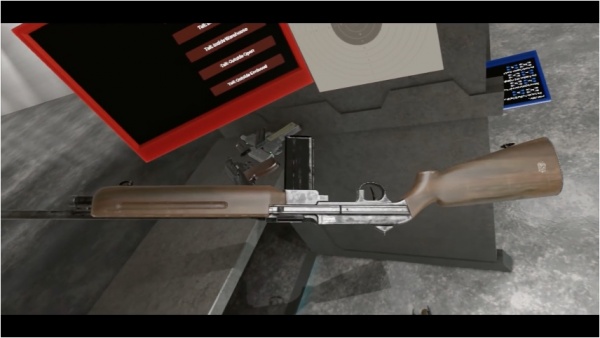
The Hyde's other side, which shows off the charging handle. This was one of the many things changed from the first variant; that one had a non-reciprocating charging handle, which the testing board requested to be changed, citing a need to be able to manually force the bolt closed if necessary.
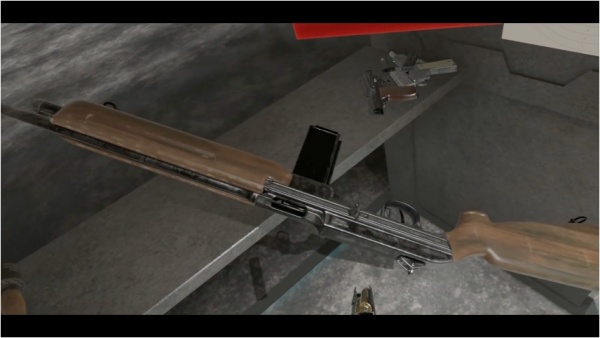
Speaking of the charging handle, it's high time for it to get pulled.
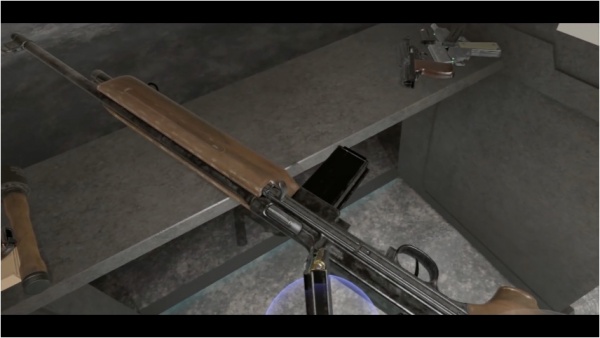
Turning off the safety, which is a piece inside of the trigger guard, rather reminiscent of the
M1 Garand (or, for that matter, the
M1 Carbine that defeated the Hyde in trials).
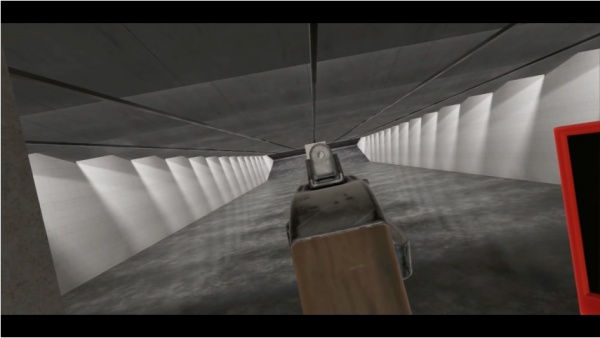
Looking through the Hyde's rear aperture sight...
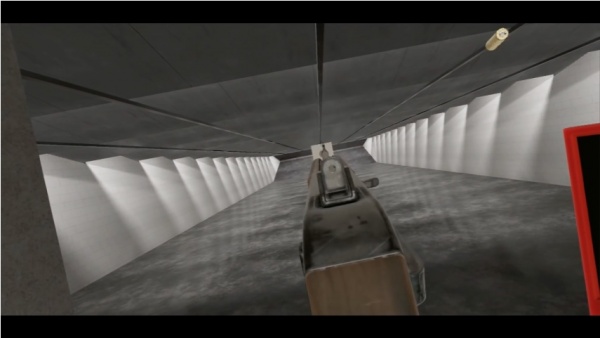
Firing a shot, thankful that doing so doesn't cause it to transform into a Jekyll Carbine.
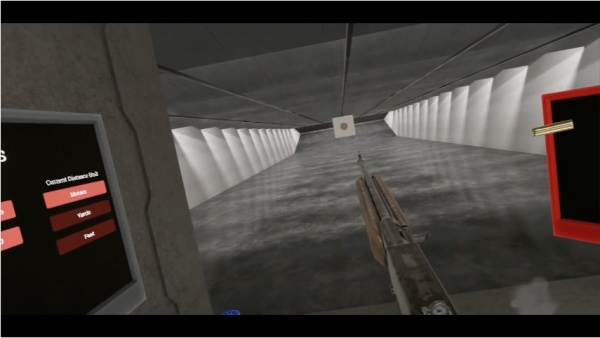
"Y'know, just because one of the complaints about the 2nd model was that it was less accurate than the first, does
not mean that it's okay to do that."
Beretta Cx4 Storm
The Beretta Cx4 Storm semi-auto carbine is available in-game, added in Update #20; it was, until the release of Update #52, permanently fitted with a foregrip. It is correctly capable of sharing magazines with the Px4 Storm added in the same update, as well as the M9A1 added earlier and the Mx4 Storm added later.
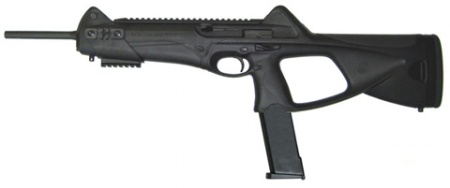
Beretta Cx4 Storm - 9x19mm Parabellum

A Cx4 Storm rests on a table. Not much else to say here.
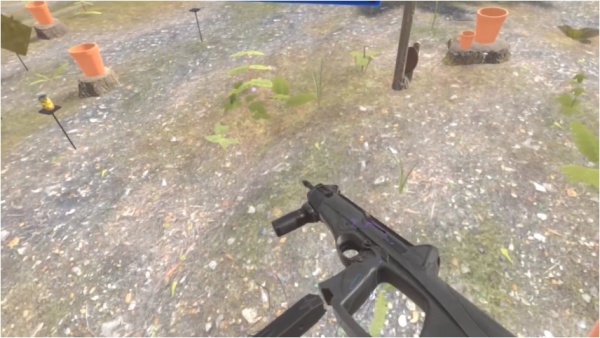
Loading a magazine into the carbine.
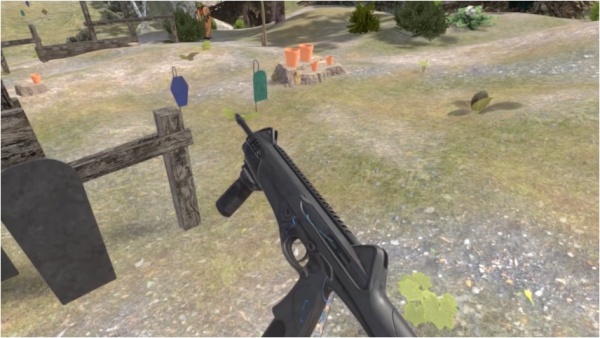
His weapon loaded, Hick-not45 proceeds down range with his Cx4, determined to get a hit on the gong.
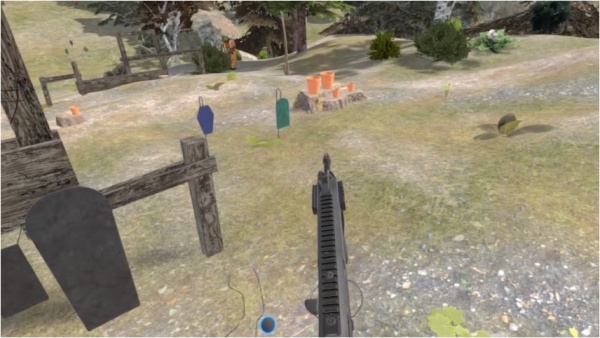
He then remembers to pull the charging handle.
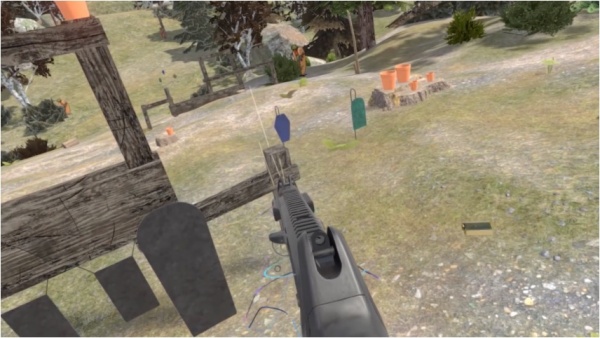
Firing the Cx4; the bullet trails demonstrate one of
H3's interesting mechanics: the ballistics system. The system assigns a material to every object in the game, and has rounds react accordingly; in this case, the FMJ 9x19mm rounds pierce through this wooden post, and are redirected this way and that in the process.
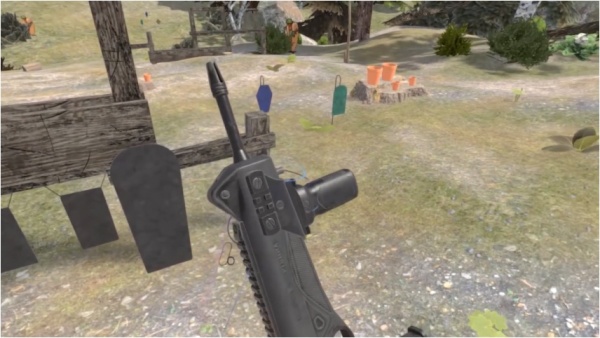
A close-up shot of the Cx4's foregrip; not only did Update #52 remove this, but it also removed the rail system it's attached to.
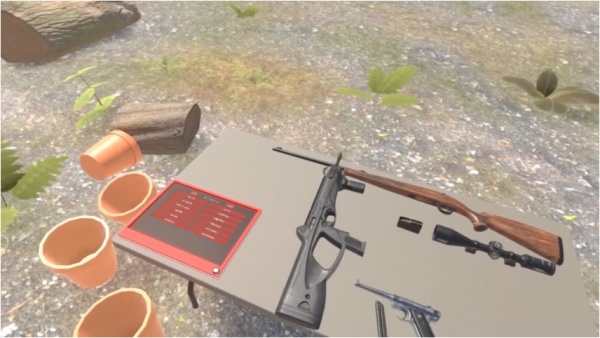
With that, Hick-not45 sets the carbine back on the table, and moves on.
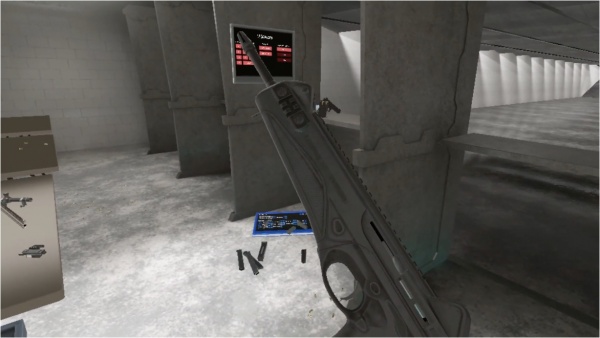
Examining (and cocking) the updated Cx4, in a far more demure setting. The main alteration caused by this update was the removal of both the foregrip and the rail system it was attached to...
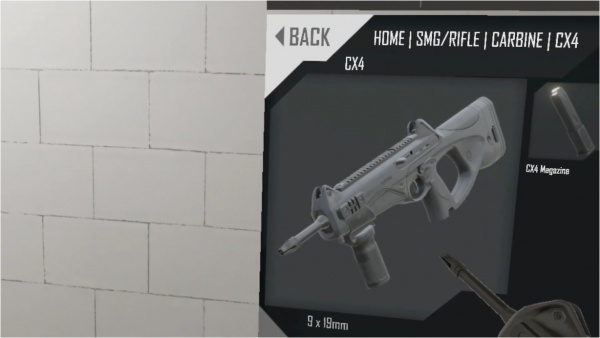
...though the item spawner evidently hasn't gotten the memo.
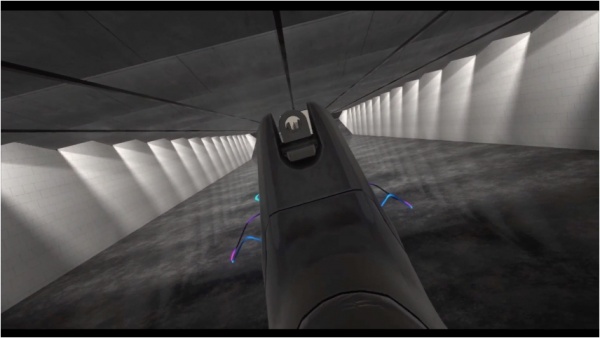
The sights of the Cx4. These didn't change or anything, we just thought that you'd like to see them.
Berthier Model 1916 Carbine
The Berthier Mle 1916 was added on day 8 of the Meatmas 2020 Advent Calendar event. It is the game's second bolt-action rifle to use en-bloc clips, and its second rifle chambered in 8x50mmR Lebel.

Berthier Model 1916 Carabine - 8x50mmR Lebel
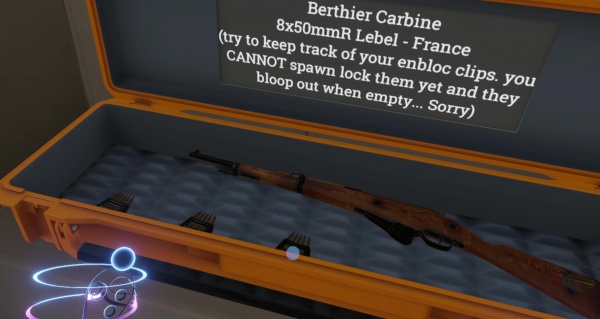
The Berthier in its gift crate, complete with quite possibly the first ever use of the word "bloop" in reference to an en-bloc clip.

Examining the Berthier. This variant is set up as a cavalry carbine, as evidenced by the side-mounted sling points (a large ring at the front, and a fixed bar at the rear).
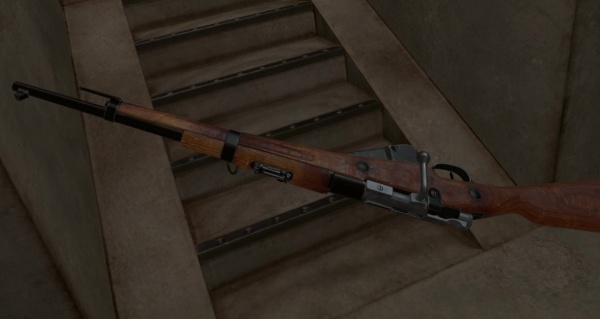
Flipping it over gives a good look at the
Lebel-esque bolt; this makes sense, as the Berthier was originally designed as a box-magazine conversion of the Lebel.

Shoving in a 5-round en-bloc clip; this was one of the primary improvements of the M1916 over earlier Berthiers, which used 3-rounders. The receiver markings are also visible in this shot, showing that this particular Berthier was manufactured at the St. Etienne arsenal.
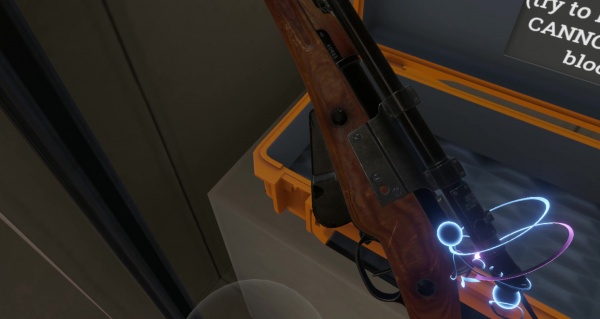
To help deal with the various threats scattered across the vast, open expanses of the Winter Wasteland, the Berthier was made compatible with the Weaver 330 scope; it apparently just screws into the stock.

Testing out the carbine's irons; while they're a bit hard to make out here, they're fantastic in-game, with a large, chunky, easy-to-acquire notch-and-post setup (reminiscent of a modern handgun, minus the high-contrast paint) for close-range engagements, and a small notch in the front sight for lining up more precise shots.

Eagle-eyed viewers may have noticed that the carbine in the above screenshot was uncocked; this is why.
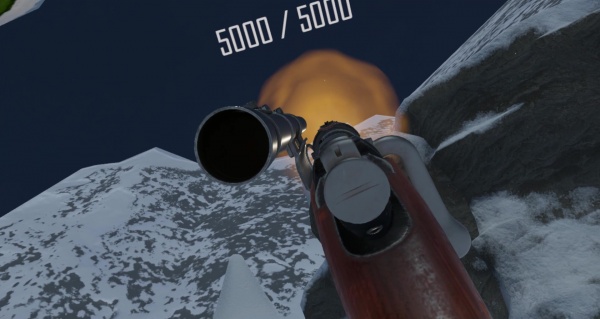
Blasting the Swarm drone that someone rather inconsiderately placed directly outside of a bunker; as one would expect for such a short, light, handy little rifle in a full-powered cartridge, the Berthier is loud and jumpy.

Flashback sequence over, the Berthier can be cycled.

Chamberloading a single 8x50mmR tracer round; between the prior shot and this one came four additional shots, since single-loading a gun like this only really makes sense when there's no en-bloc clip in the magazine.

Taking aim at a distant Static drone. The practical utility of a single tracer for such an application is questionable, to say the least.
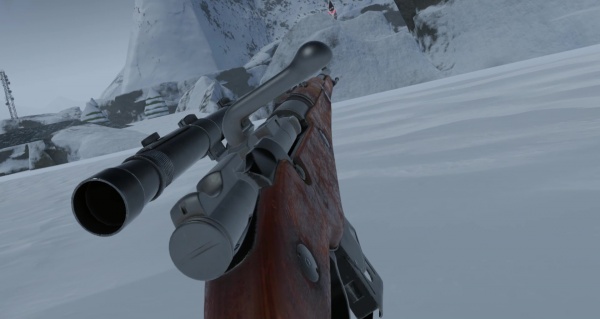
This is further supported by the fact that, in the subsequent interim, another four FMJs were fired, causing the next en-bloc clip to pop out as the fifth round is chambered. Due to the way this ejection is programmed in-game, the clip tends to, well, clip.
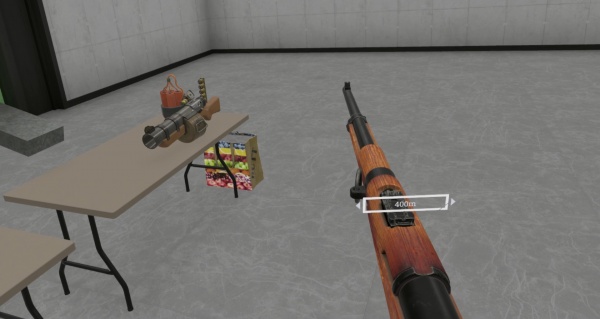
Fiddling with the weapon's sights over in the Proving Grounds. Note the arrows on both sides of the adjustment box; despite starting at a 400-meter zero, it goes down to 300 meters.

The sights max out at 800 meters; a bit optimistic, but far more reasonable than most full-length rifles of its day.
Brown Bess Flintlock Musket
The Brown Bess Flintlock Musket was added on Meatmas Day 2020. It is the second flintlock firearm added to the game and the first flintlock long arm.

Modern reproduction "Long Land Pattern" Brown Bess Infantry musket made from 1722-1768 - .75 caliber.
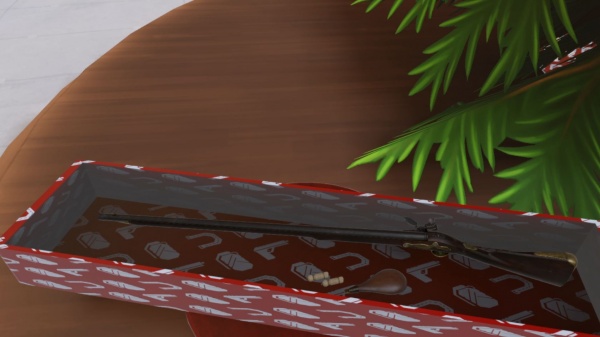
Allo, wot's oll this then? Cor blimey, its a Brown Bess, innit?
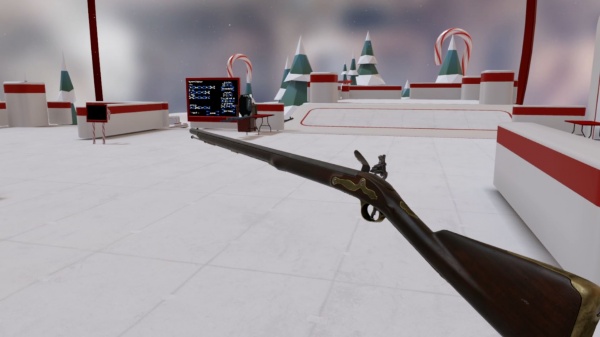
Being the longer version of the Flintlock pistol, the Brown Bess is mechanicaly identically in every major factet.
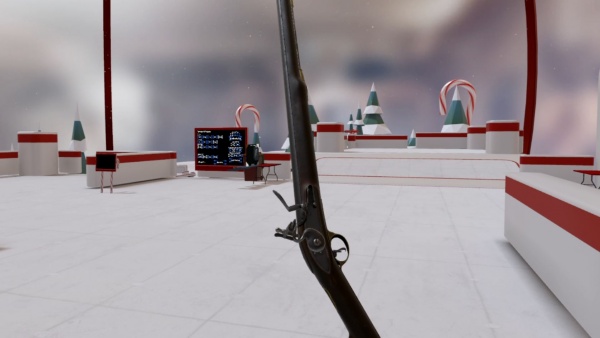
Just, you know... much bigger.

Okay, starting off this long and drawn out loading process, we begin by pouring a few grains of black powder into the flashpan.
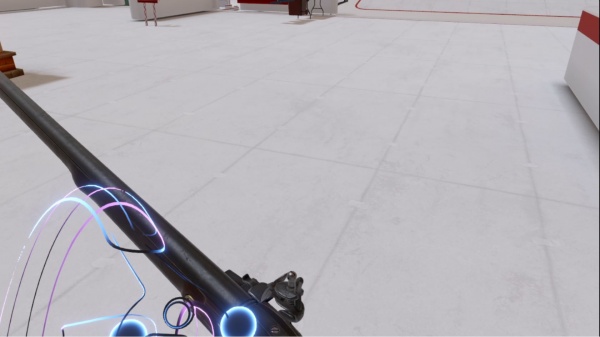
The Frizzen is closed shut, or else all the black powder in the flashpan is going to fall out in the next step.

Removing the ramrod from its hold is a bit more complicated this time around, seeing as its nearly as long as the barrel.
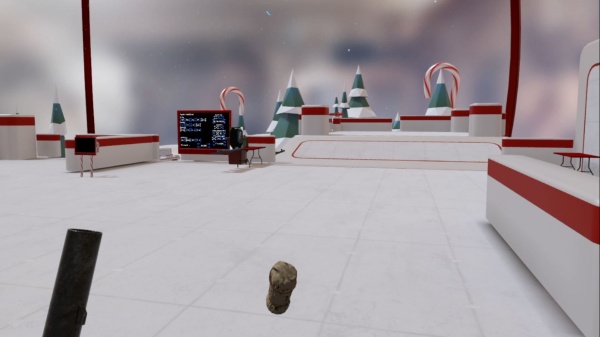
While we could just use loose powder and musket ball, we're provided with a paper cartridge for a somewhat easier loading process.
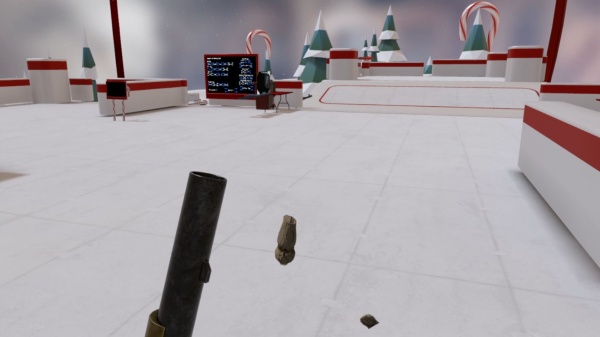
To open, bit off the tip of the paper cartridge. The player spits out the paper immediately. Which is what you should do, because black powder tastes nasty.

Next, dump the powder into the barrel, then place the cartridge and ball into the barrel.
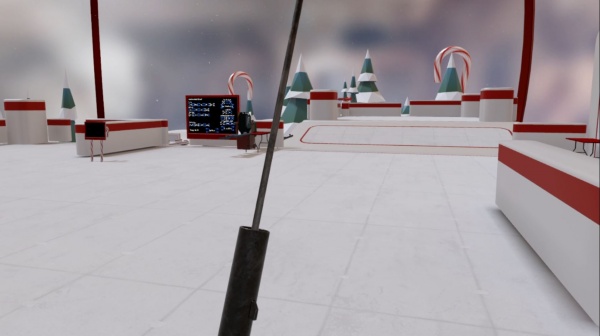
Now we just need to ram that sucker all the way down into the barrel. Because we've got several more feet of barrel to ram, this takes a fair bit longer than on the pistol.
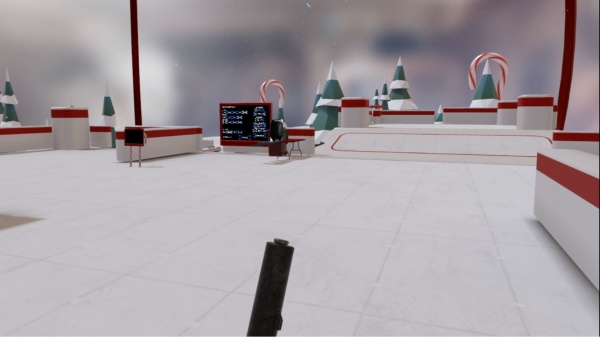
When the ramrod is just barely poking out, you've got the ball all the way down.
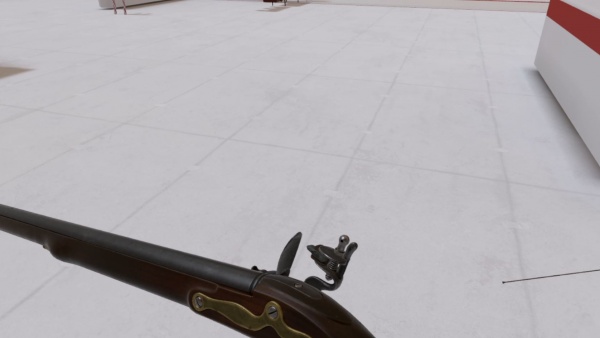
Final step is to pull the hammer into full cock, and we're ready to shoot.
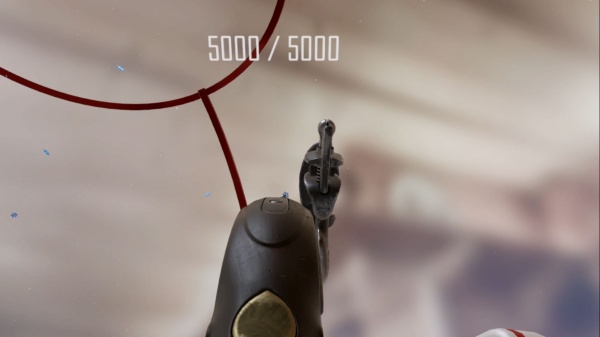
Even with just the rudimentary front sight, the long length of the barrel does make aiming a little bit more accurate.
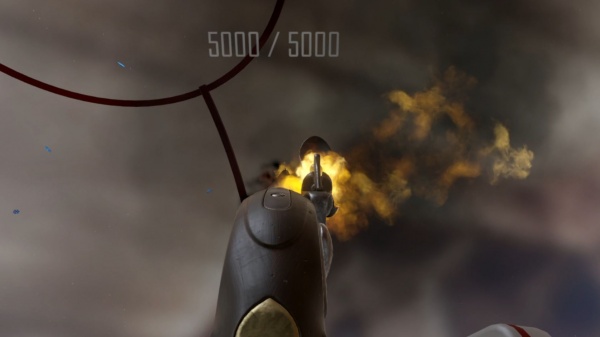
There's a slight delay between pulling the trigger and firing the musketball, depending on how much powder is in the flashpan. Either way, you're going to get a lot of smoke.

And for an unrifled barrel, its not too difficult to hit targets from farther away.
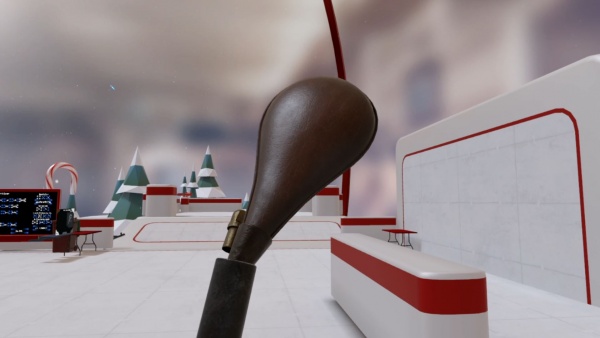
But what happens if we put in
way too much powder?
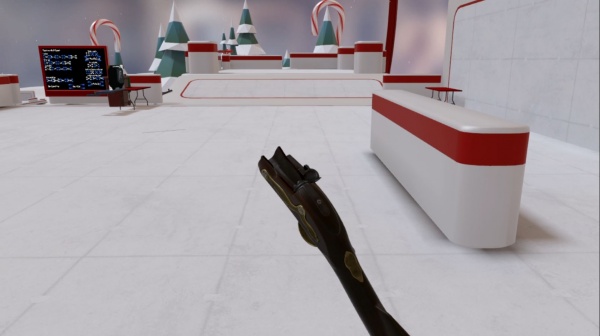
That definitely doesn't look good.
Brügger & Thomet APC45 Carbine
Update #61 added a pair of Brügger & Thomet APC-series pistol-caliber carbines, one of which is an APC45. This is possibly the APC45's first known appearance in any form of media.
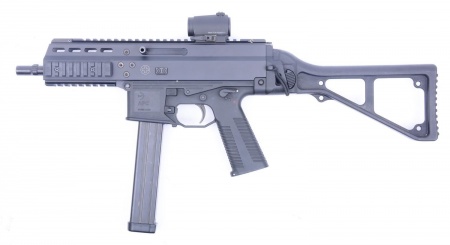
Brügger & Thomet APC45 Carbine - .45 ACP
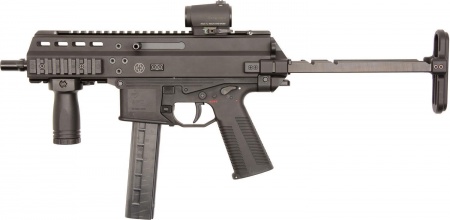
Brügger & Thomet APC9 SMG - 9x19mm Parabellum. Image provided to show the collapsible stock seen on the in-game APC45.
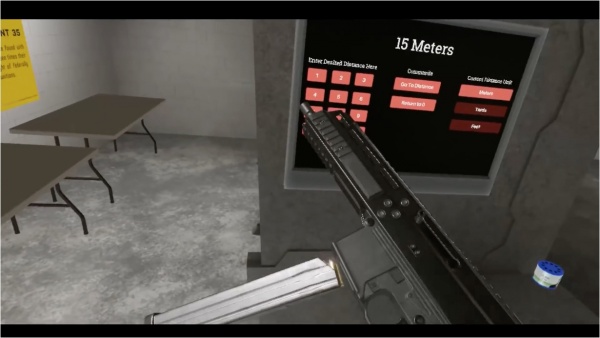
Loading a magazine into the APC45...
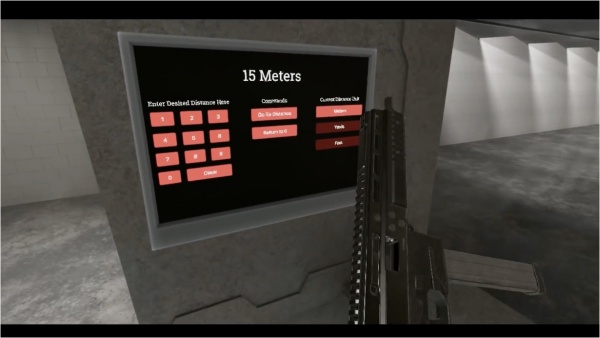
...and pulling the charging handle.
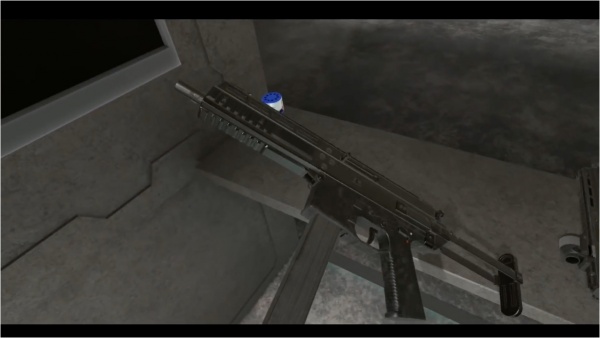
Examining the carbine; note the 2-position fire selector.
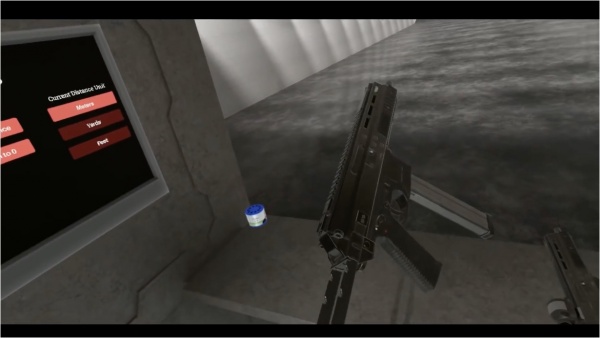
The other side, giving a good view of the collapsible stock. While not as commonly seen on the carbines, the collapsible stock is interchangeable with the side-folder, so such a configuration is entirely possible.
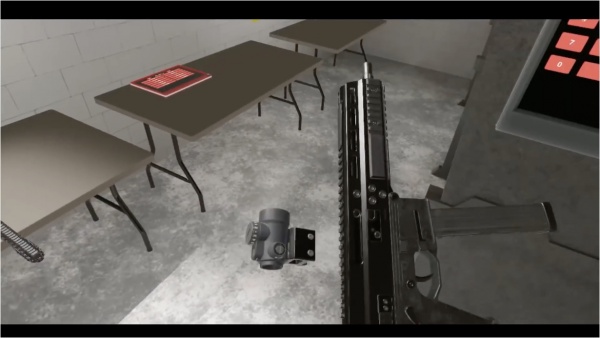
Attaching a red-dot sight, in an attempt to appease the benevolent gods of reference images.
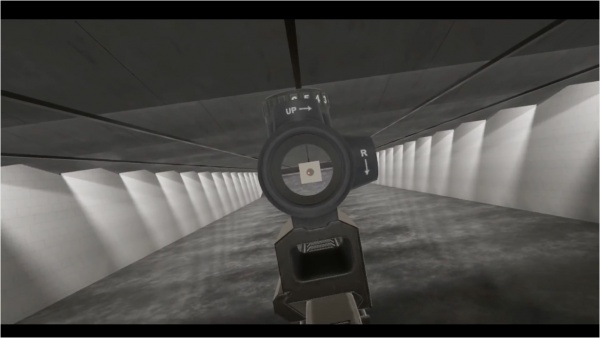
Plus it makes aiming easier.
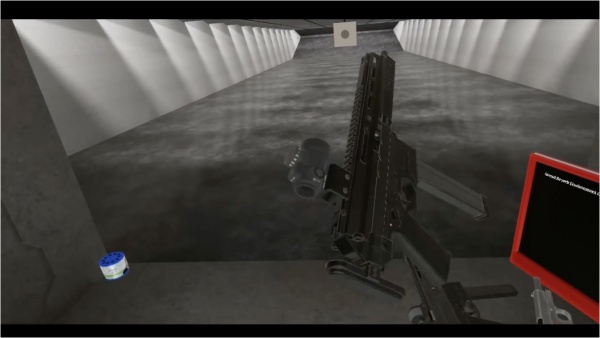
...which fits nice and flush against the back of the receiver.
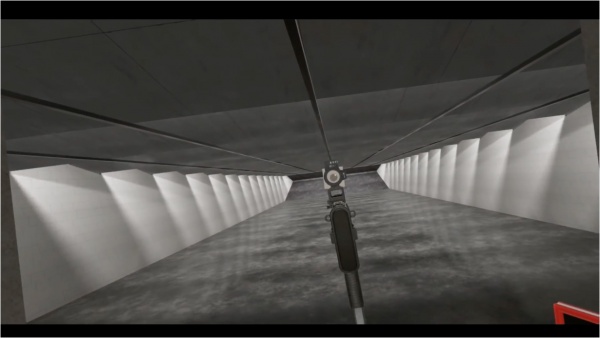
Doing this allows the APC45 to be used as a pseudo-pistol.
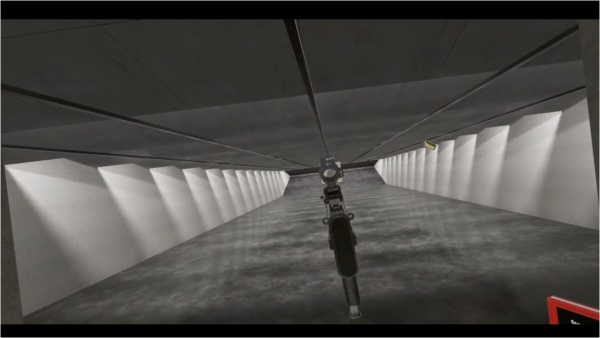
Note the word choice: it
allows the APC45 to be used as a pseudo-pistol. It does
not make doing so easy.
Brügger & Thomet APC9-P
To compliment the APC45, Update #61 added Brügger & Thomet APC9-P semi-auto carbine, a longer-barreled variant of the APC9.
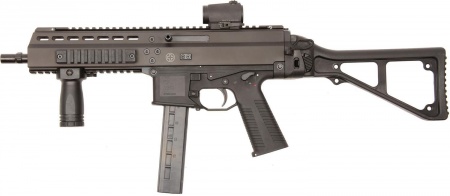
Brügger & Thomet APC9-P carbine - 9x19mm Parabellum

Brügger & Thomet APC9 SMG - 9x19mm Parabellum. As above, image provided to show the collapsible stock seen on the in-game APC9.
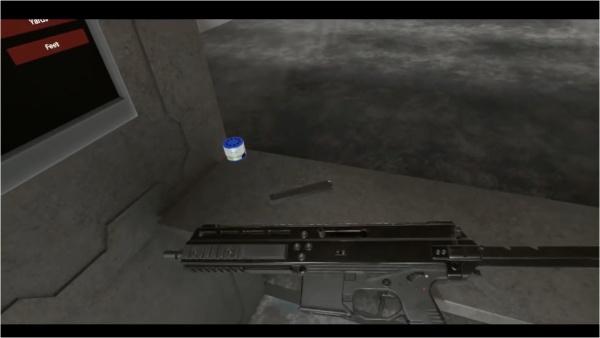
The left side of the carbine...
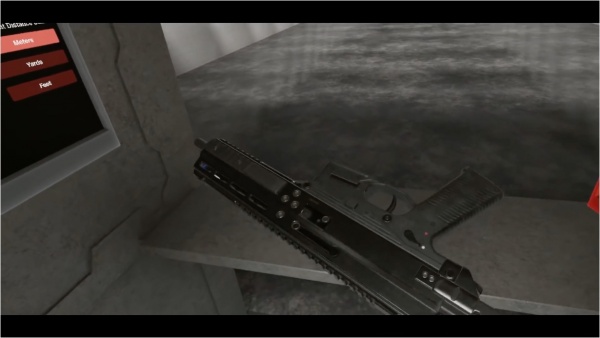
...and the right side. Without the magazine, the APC9 is nearly indistinguishable from the .45 version.
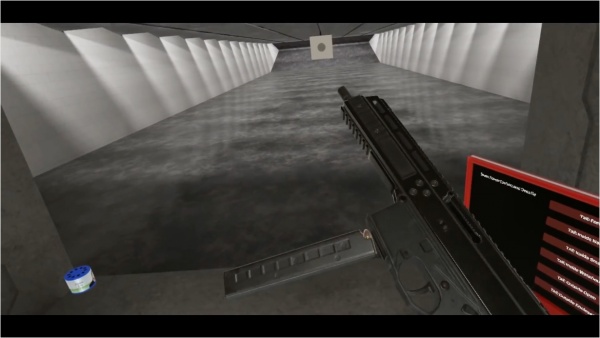
Bringing the magazine into the equation makes the difference relatively clear. These 32-round magazines are interchangeable with those of the
Brügger & Thomet MP9, which makes sense, considering that they're made by the same company.
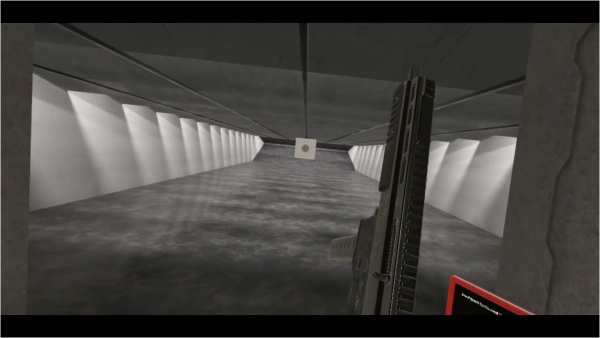
Giving the reciprocating charging handle a nice, solid tug.
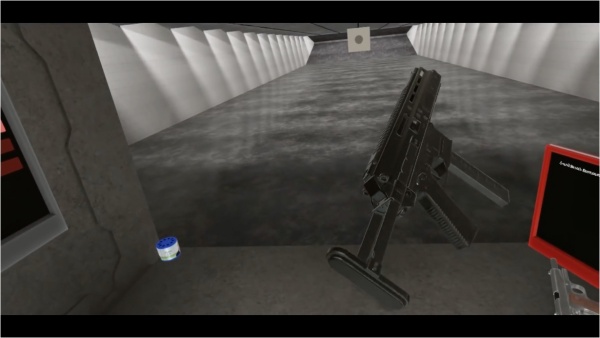
Fiddling with the collapsible stock.
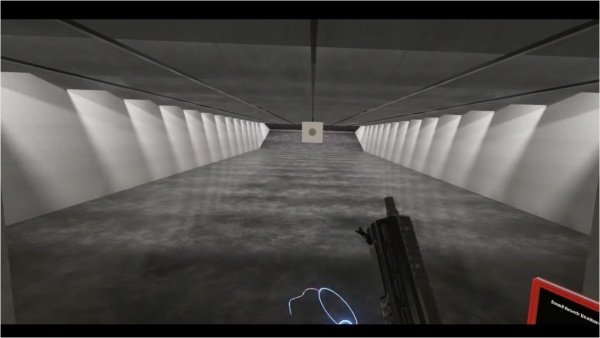
Flipping up the front sight...
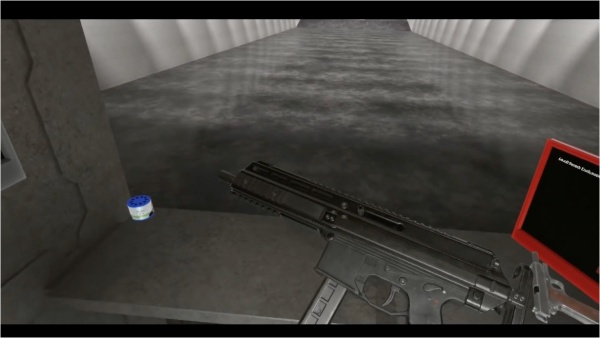
The APC9's selector switch; the civilian carbine versions have only safe and semi-auto positions, while the SMG variants have a 3rd full-auto position around the 8 o'clock position relative to the pivot, denoted by 3 red dots (see the 2nd reference image).
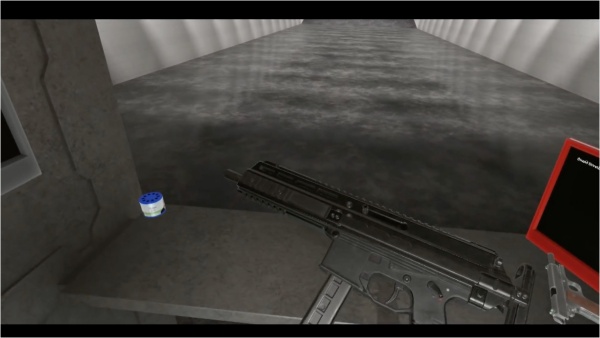
The aforementioned semi-auto position.
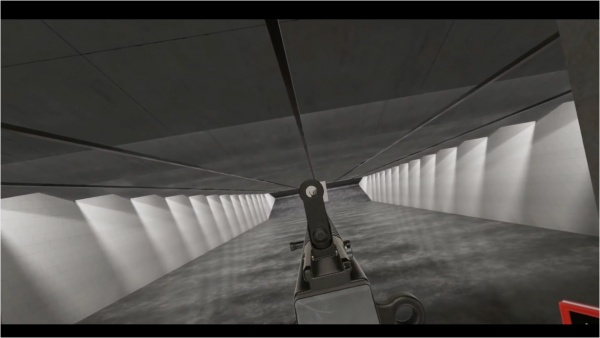
A view through the carbine's flip-up irons.
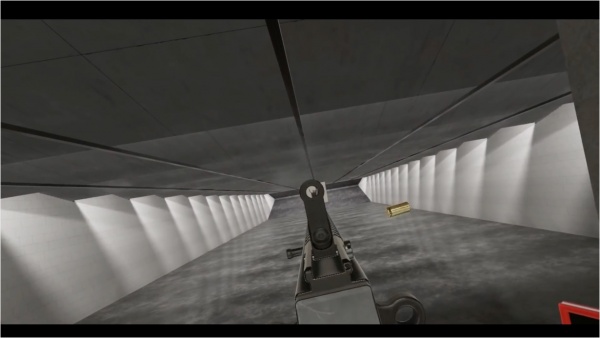
Another view of the same, this time just after firing.
Bushmaster ACR
Added in Update #58, the Bushmaster ACR is, unusually for a video game, correctly treated as a civilian semi-auto carbine, rather than the select-fire assault rifle that most games depict it as.
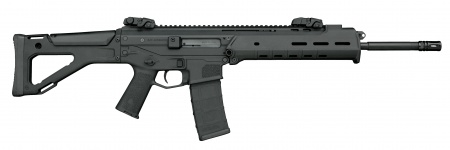
Bushmaster ACR - 5.56x45mm NATO
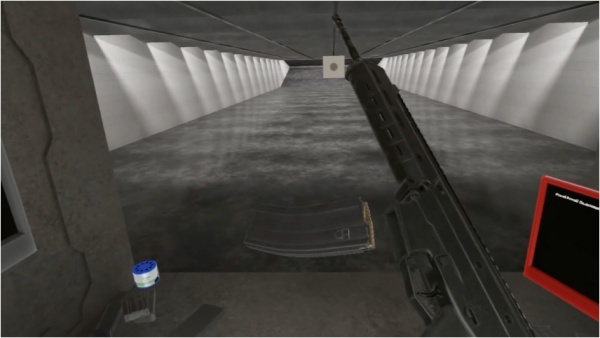
In an act of defiance against the reference image, our invisible operator loads his ACR with a 30-round USGI-pattern metal STANAG, rather than the picture's PMAG.
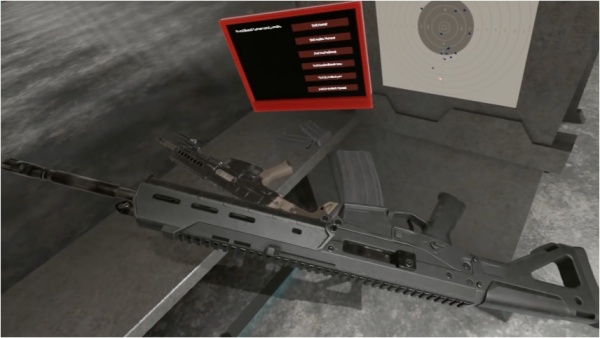
Plus, at the time these shots were taken, the game didn't have any PMAGs yet.
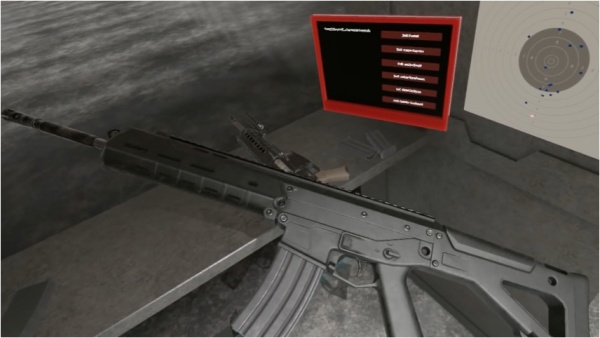
Well, making do is all we can.
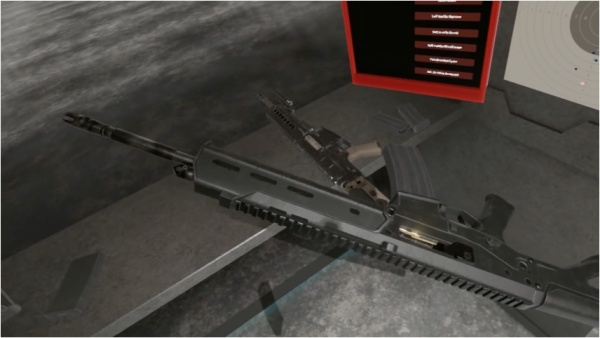
Pulling the charging handle; interestingly enough,
H3's ACR has its reversible charging handle set on the right side, in an ideal position for a left-handed user.
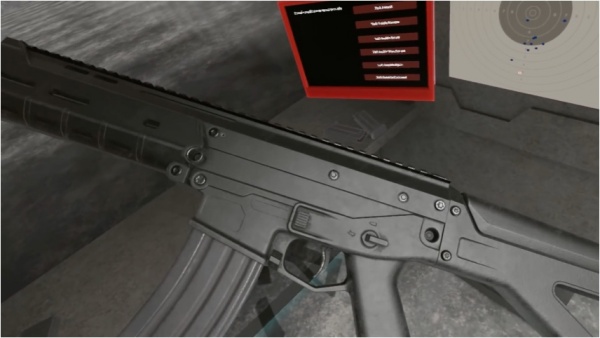
Taking a close look at the fire selector...
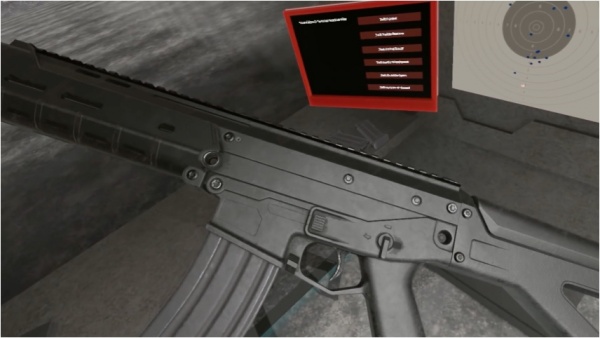
...which has two - count 'em! - settings: safe, and semi-auto.
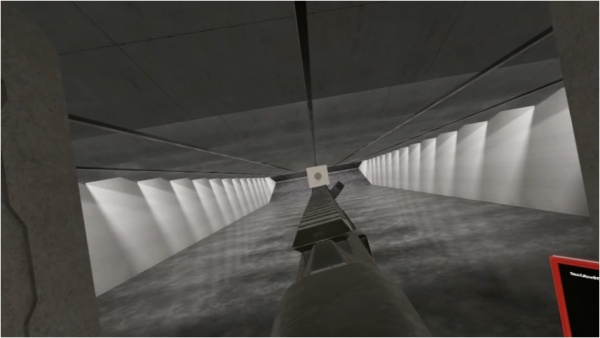
It also has zero - count 'em! - sights by default.
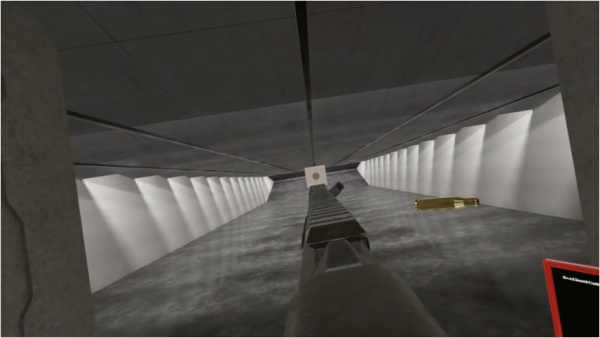
Once again, there's nothing to do but make do.
Carcano M91
On the ninth day of the 2018 Meatmas event, a Carcano M91 was added. It is (understandably) the first weapon in the game to use the 6.5x52mm Carcano round, and only the second to use en-bloc clips (the first being the earlier-added M1 Garand, which uses a slightly different system).

Carcano M91 - 6.5x52mm Carcano
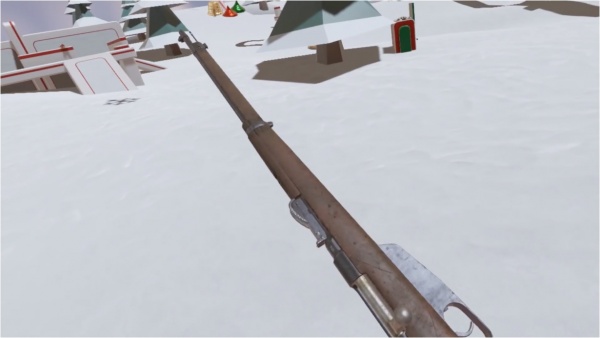
Admiring the rifle. Or, at least, attempting to; being over 50 inches (127 cm) long, the Carcano rarely actually fits in frame.
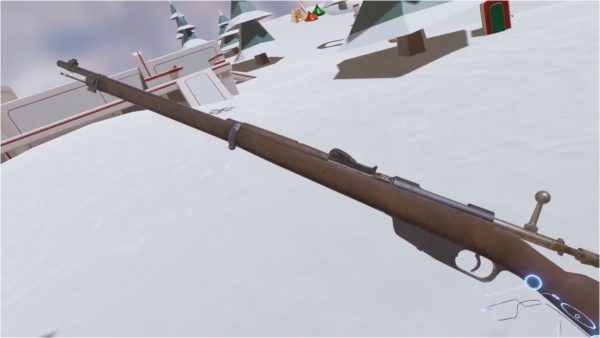
...which, unfortunately, doesn't make the rifle any shorter.
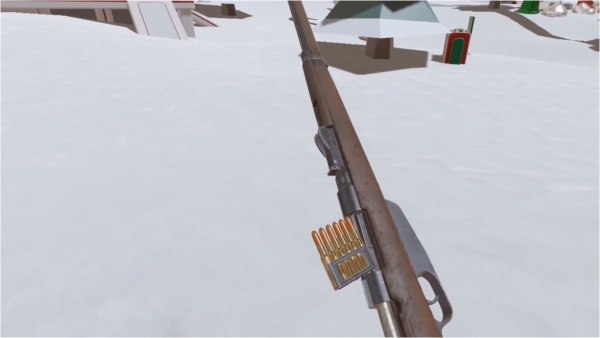
Loading in a 6-round en-bloc clip. Unlike the M1's staggered-column clips, these are based on the original Austro-Hungarian Mannlicher system (or, rather, the improved bi-directional German version developed with the
Gewehr 1888), and, as such, are single-stacked.
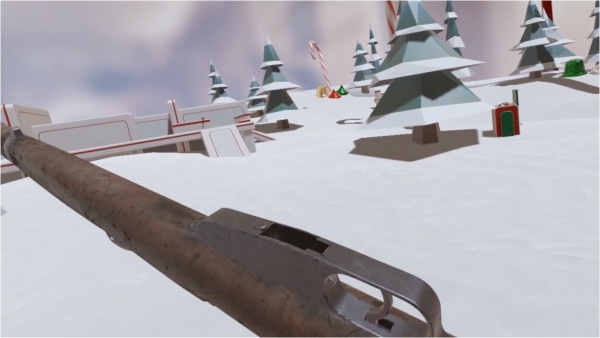
Another aspect of the Mannlicher system is this mysterious hole. Wonder what it could be for...
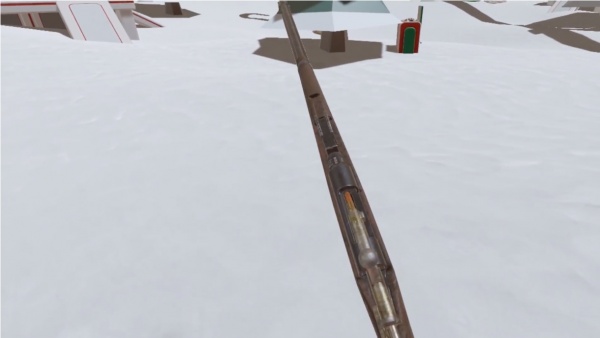
Deciding to just ignore it, and chambering a round.
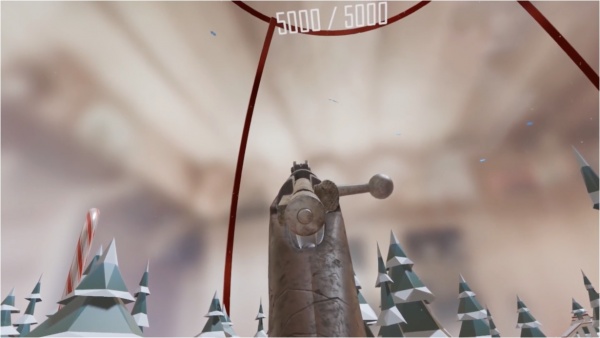
Aiming; the M91's sights are a bit small and hard to see, as was common at the time of its adoption. Which was quite a long time ago, as both the rifle's designation and poor condition make apparent. The two world wars it's been through probably haven't helped.
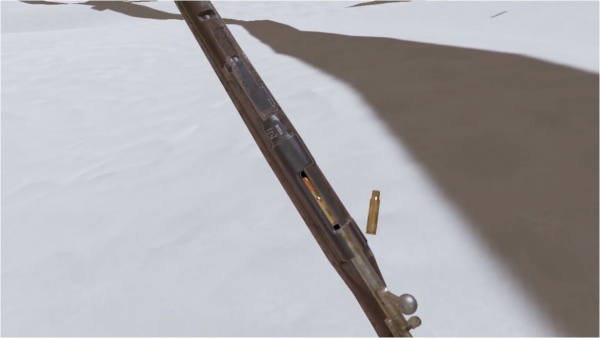
Working the action, and ejecting a spent casing. At full size, this image also shows off some of the markings on the flat-sided portion of the barrel.

Ejecting the second-to-last spent case...
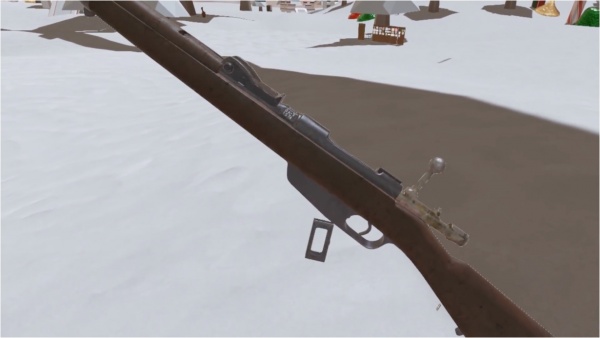
...and chambering the last live round, while simultaneously revealing the purpose of the hole in the bottom of the magazine: clip ejection. Another feature incongruous with the better-known Garand, rather than ejecting clips out the top when the last round is fired, the Carcano's clips simply fall out the bottom when the last round is chambered.
CMMG MkGs Banshee
Added in the 4th alpha build of Update #70, the "Phantom 9" pistol-caliber carbine is a CMMG MkGs Banshee in 9x19mm.
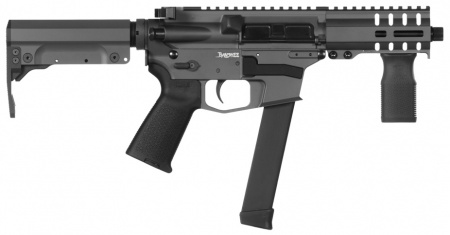
CMMG MkGs Banshee 300 with Magpul RVG foregrip - 9x19mm Parabellum
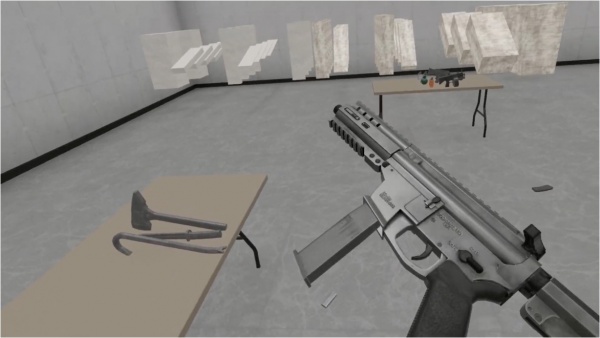
Loading the Banshee with a 15-round
Glock 19 magazine.
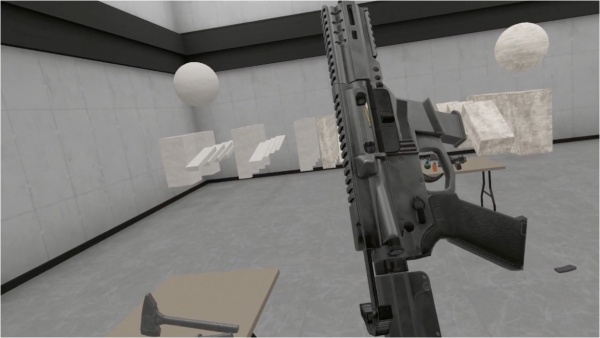
...and racking the charging handle.
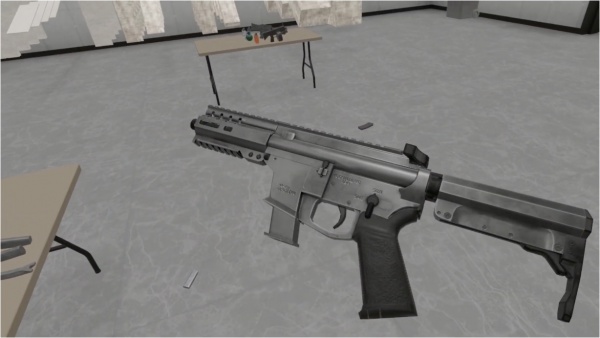
Pausing for a moment to admire the Banshee. The matte-gray finish is an interesting choice, wouldn't you say?

Toying with the adjustable stock; this is CMMG's proprietary RipStock, standard on the SBR-pattern Banshees.
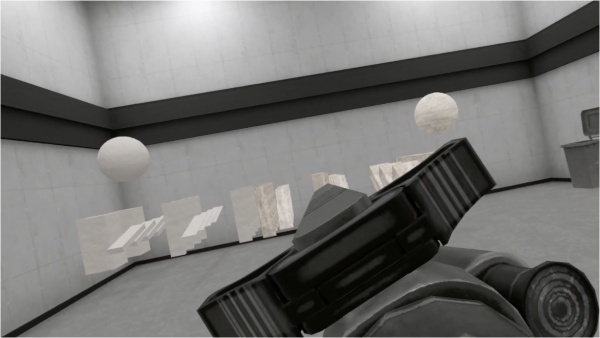
Trying to aim, before immediately discovering that the Banshee doesn't come with any sights by default, which is at least in line with how the carbines are shipped from the factory.

Popping off a few rounds in spite of this.
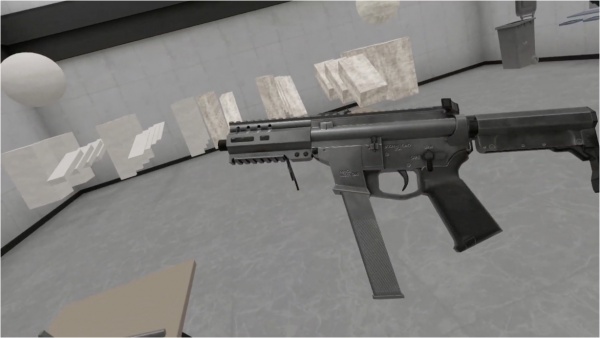
Of course, if 15 rounds is good, then 33 must be better, right?
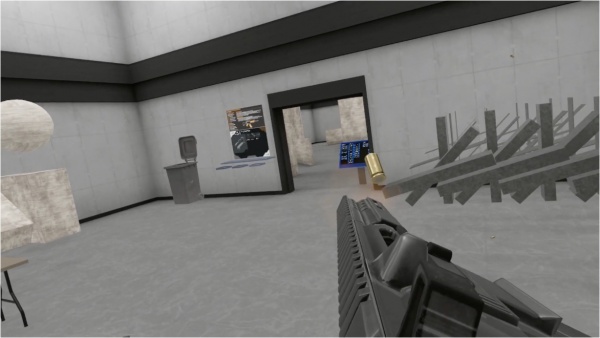
Following this sound logic, and firing some more rounds, in the ever-cool-but-impractical diagonal-firing stance. Of course, without any sights (or, for that matter, any particular target), it's a bit of a moot point.
Custom AR-15
Update #59's eighth alpha added a custom AR-15 carbine, with a short barrel and PDW-type collapsible stock. Being a civilian rifle, it fires exclusively in semi-auto. Update #61 added another custom AR, this one a full-length rifle (though still classified as a carbine, lacking a better category), known as the "Bubba-15".
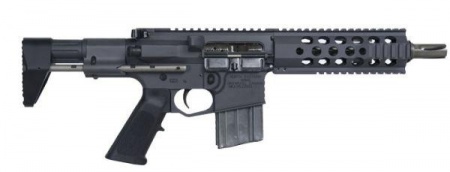
North Eastern Arms NEA-15 PDW - 5.56x45mm NATO. Similar (though not identical) to the rifle in-game.
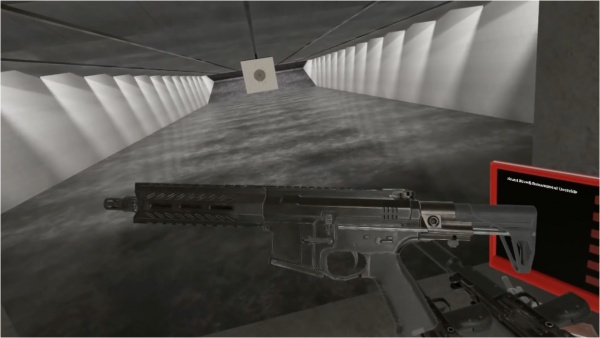
Admiring the AR. 200 extra dollars and 9+ months of waiting well spent.
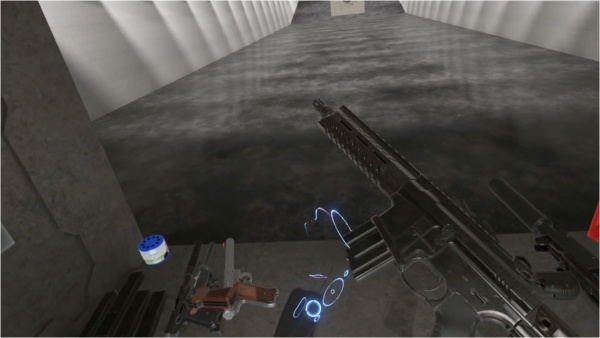
Loading in a 10-round magazine, for legality's sake, before irritatedly remembering that most states with magazine capacity restrictions have a total moratorium on SBRs anyway (SBR standing for
Short-
Barreled
Rifle, a term used in the context of US firearms laws to refer to any firearm with a stock and a rifled barrel shorter than 16 in (40.6 cm), or a front-to-back overall length under 26 in (66 cm); under the National Firearms Act of 1934, these require registration with the Bureau of Alcohol, Tobacco, Firearms, and Explosives, with a $200.00 fee, though some states simply prohibit them outright).
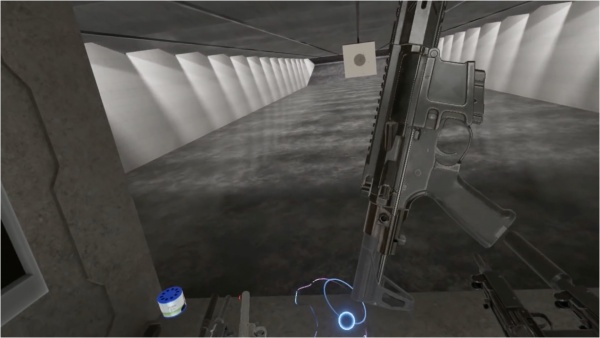
"Well, if they're going to come for my dogs, they're going to have to go through me first."
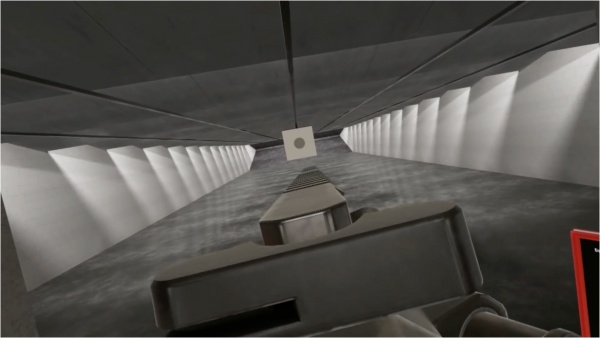
"That might be a problem."
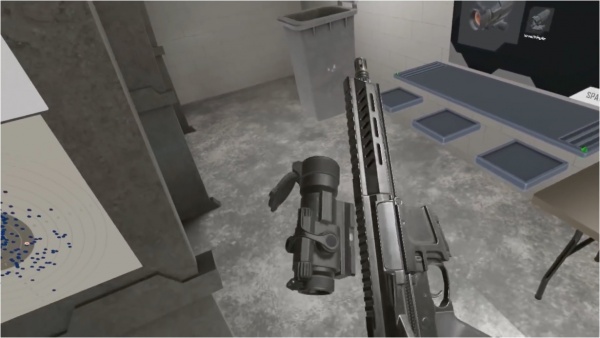
Alleviating the aforementioned problem, by attaching an Aimpoint red-dot sight.
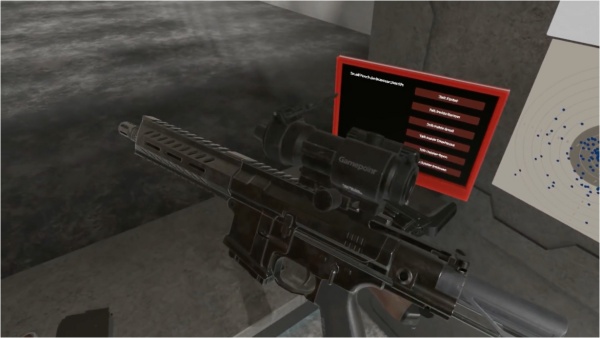
WE ARE EXPERIENCING TECHNICAL DIFFICULTIES; PLEASE STAND BY.
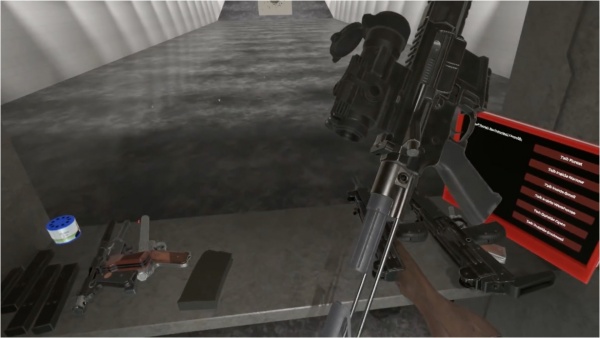
Remembering that funny little thing called "eye relief" exists, our heroic dog-defender extends his rifle's stock.
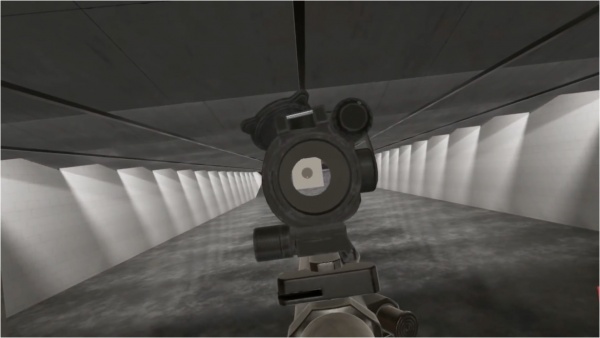
There we go, much better.
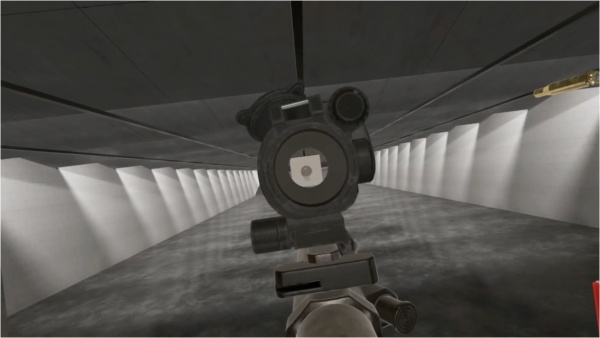
Firing again, this time without any risk of objective lens-related eye injuries.
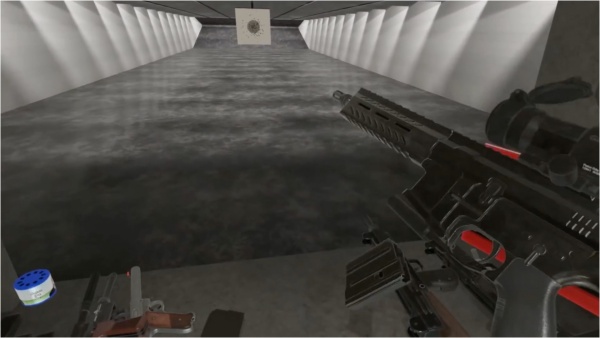
Dumping out the empty magazine. 10 rounds lasts longer than you might think, but not as long as you'd like it to.
"Bubba-15"
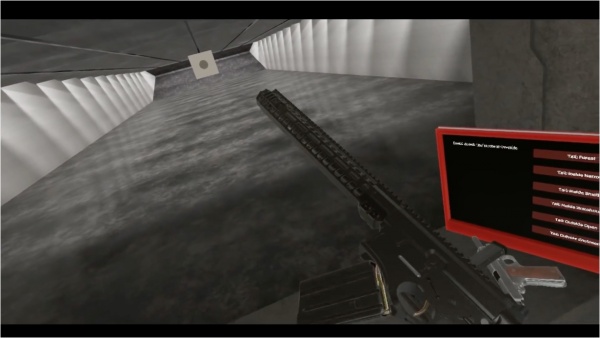
Attempting to stick a magazine into the trigger guard; Bubba isn't known for his hand-eye coordination. After all, he only has one of the latter and one and half of the former.
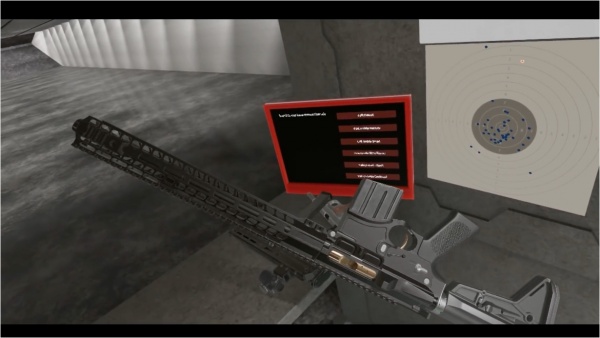
Still, depth perception isn't needed for drooling over a bronze-coated bolt carrier.
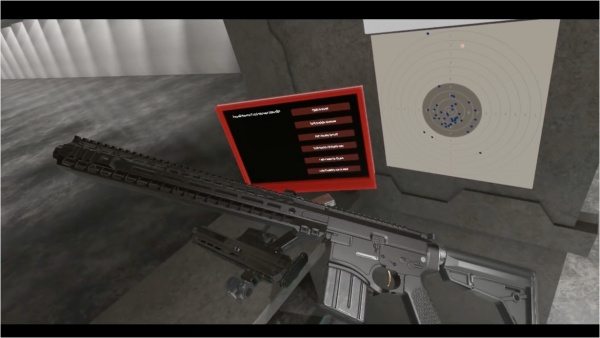
Or any of the rifle's other aftermarket components, for that matter.
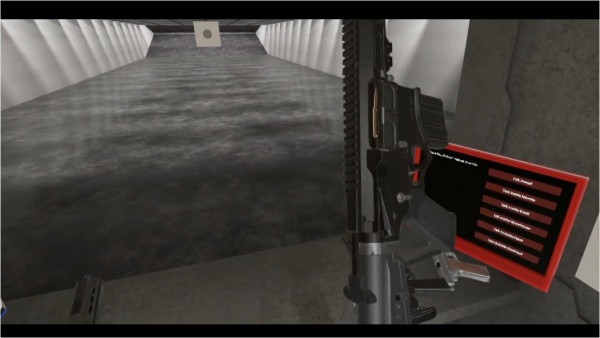
Getting back to standard Bubba business, and pulling the charging handle.
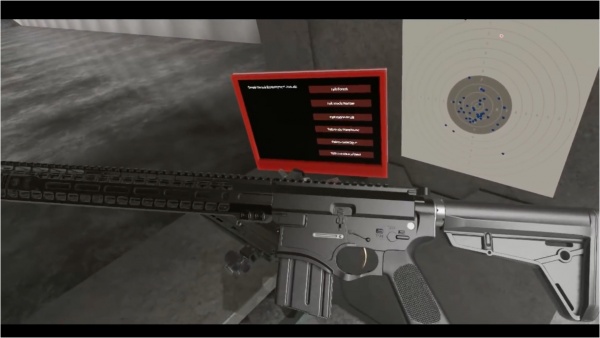
Flipping the selector, from "Safe"...

...to "this is still a civilian rifle, what'd you think its fire modes would be".
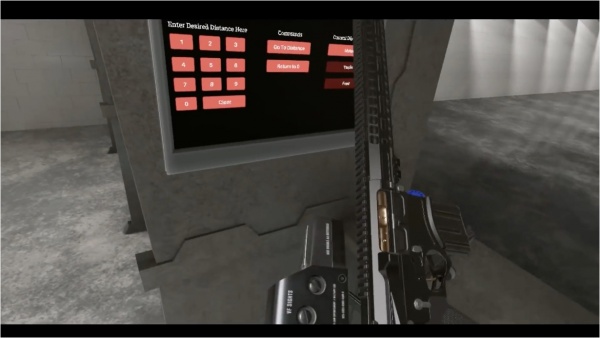
...before remembering that, of course, no expensive rifle is complete without an expensive optic.
CZ 858
The last of Update #59's SA vz. 58 variants was a synthetic-stocked CZ 858 civilian sporter carbine.

CZ 858 with polymer furniture - 7.62x39mm
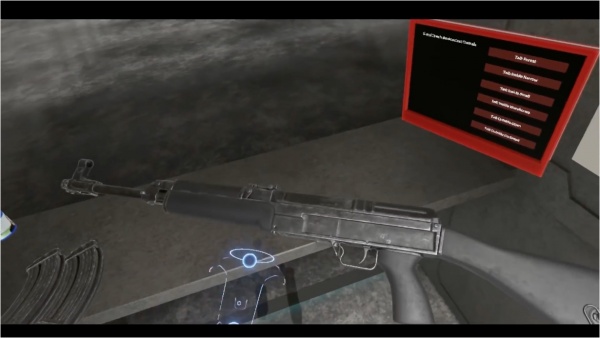
The rifle's other side. As one might expect, it's more or less the same as the standard vz. 58 from an aesthetic perspective, barring the fire selector and furnishings.
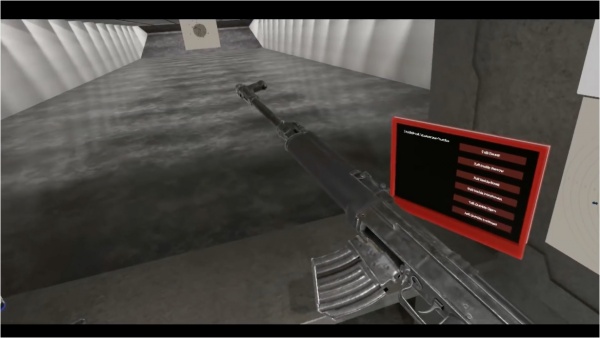
Loading a 10-round magazine into the 858. While thematically appropriate, the 10-rounder isn't the only available option; standard 30-rounders work just fine.
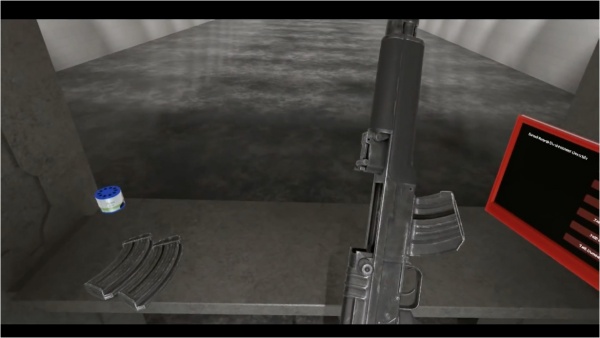
Pulling back the charging handle.
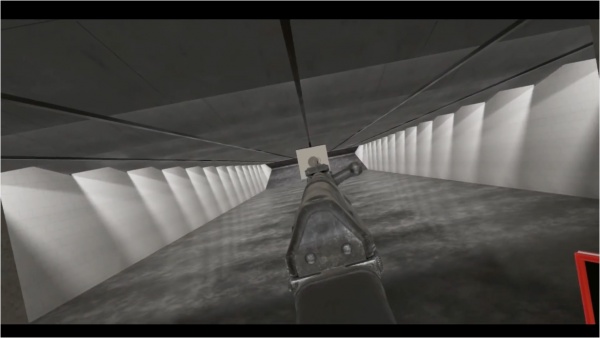
Aiming the rifle... poorly.
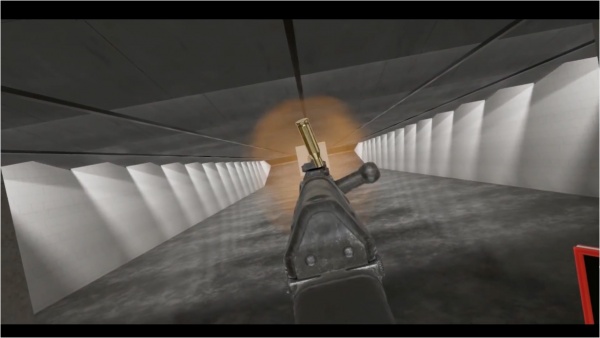
Firing the rifle in spite of this fact, with groupings to match.
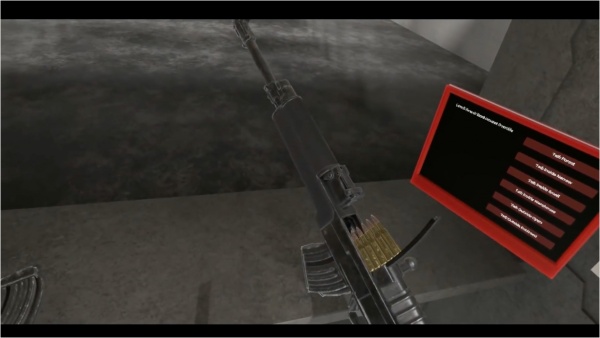
While there aren't many perks to using a 10-round magazine on a rifle such as this, one among them is the ability to fully top it off with a single stripper clip.
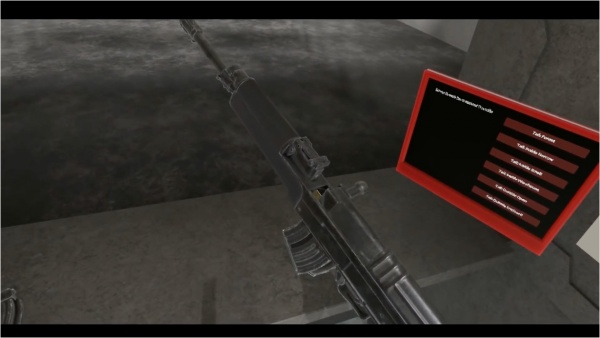
Letting the bolt slam back into battery.

The 858 was another one of the many guns that got an adjustable rear sight in Update #94; it goes from 100 to 800 meters, in 100-meter increments. This one's also been fitted with a PBS-4 suppressor - that way, if the sheer impossibility of making a target out at 800 meters without a magnified optic at HMD resolution doesn't stop you from landing a shot, the point-of-impact shift (another Update #94 addition) will.
De Lisle Carbine
Update #76's first alpha added the De Lisle Carbine, an integrally-suppressed Lee-Enfield derivative chambered in .45 ACP, intended for use by British special operatives during the Second World War. Despite the name, it is categorized with the bolt-actions rather than the carbines in-game, on the basis of its action.

De Lisle Carbine - .45 ACP

A De Lisle Carbine sitting on a table, alongside several other bolt-actions of the same approximate period (albeit far more normal ones).
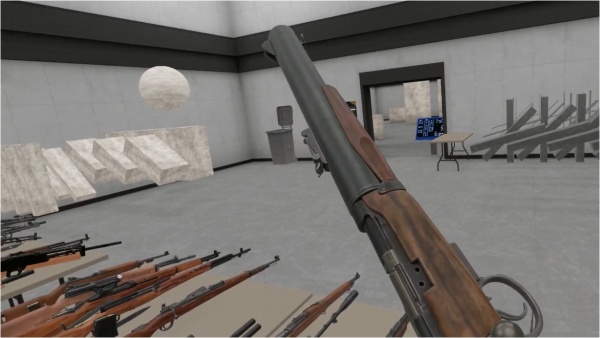
...before noticing that the magazine apparently decided to just take a break.
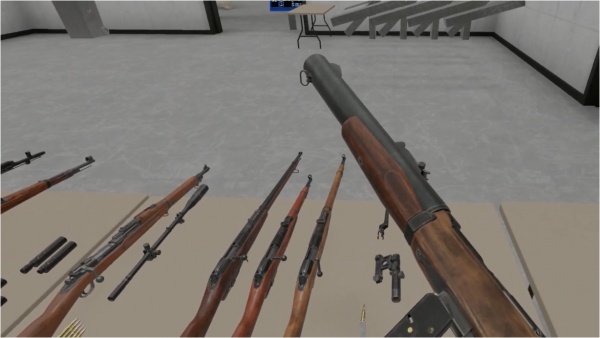
Rectifying the above issue, by reminding the mag that it's not part of a union, and can be fired at the employer's discretion. This is a specially-modified
M1911 magazine, intended for use with the De Lisle.
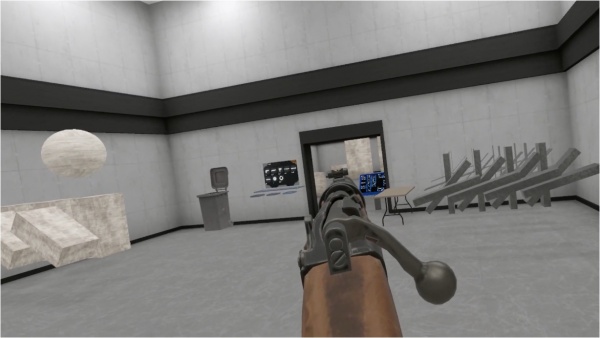
Giving the sights a try; these are rather obviously different from normal Enfield sights, being meant for a subsonic cartridge and attached to something other than the original barrel (which isn't even a part of the gun anymore, as the .303 barrel was replaced with a modified barrel from a
Thompson as part of the conversion process).

Firing off a shot. Given the
incredibly soft report (the De Lisle is the quietest firearm in the game, and one of the quietest ever created), the nonexistence of a muzzle flash, and the lack of any automatic cycling system, the only real indication that a shot has been fired (other than effect on target) is the dropping of the striker, as seen here.

It's so quiet, in fact, that the process of cycling the bolt is actually louder than the gun firing. Not that you can tell from a still image, of course.

Adjusting the carbine's sights; given .45 ACP's rainbow-like trajectory (and the weapon's intended role), these only go from 50 meters to 200, in 50-meter increments.
FightLite Raider
The FightLite Raider, a civilian semi-auto AR-15 "pistol" (i.e. legally considered a pistol by US gun laws, but not really a pistol from a technical or logical standpoint; the game also classifies it as such) based on Ares' traditionally-stocked SCR lower, makes its media debut in H3's 58th update.

FightLite Raider - 5.56x45mm NATO
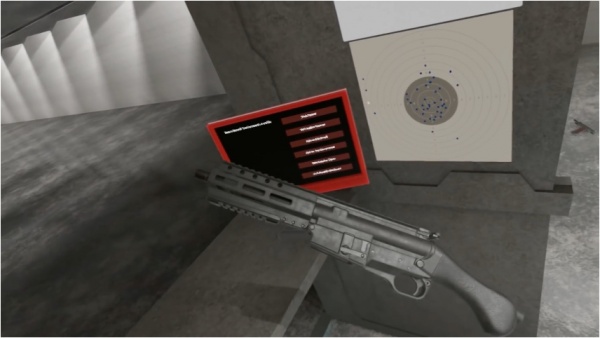
Taking a look at the downright bizarre concept that is the Raider.
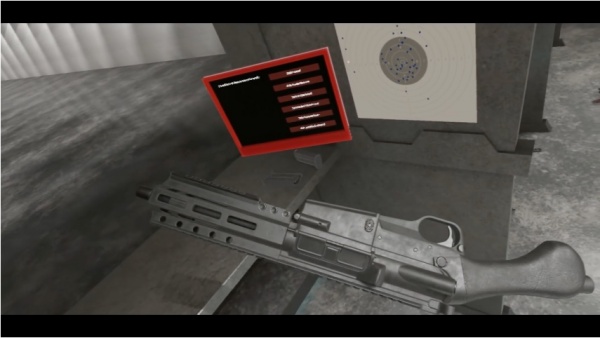
The right side, which is just as strange as the left.
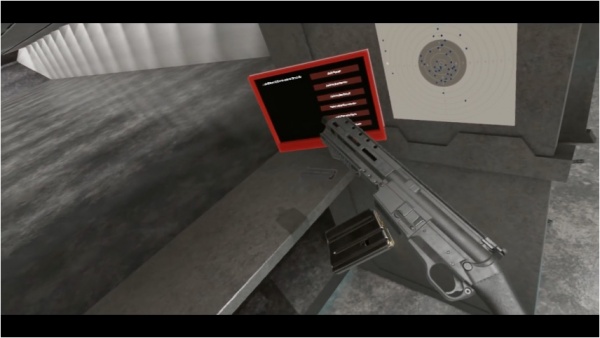
Loading in a 10-round magazine, for maximum legal compliance.
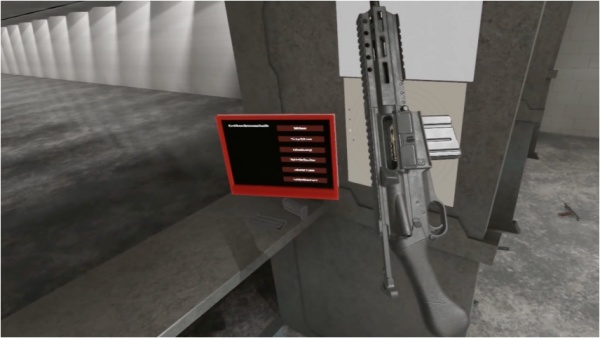
Pulling back the charging handle; as with the game's other AR variants, the dust cover correctly pops open.
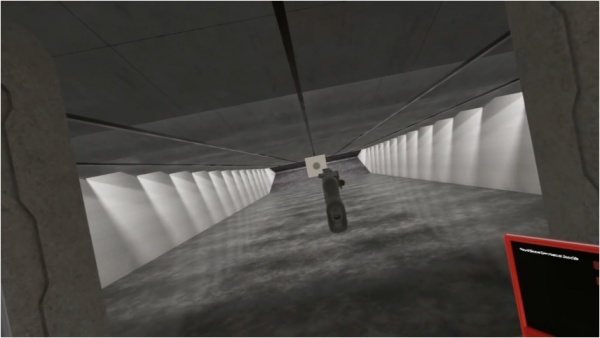
"Aiming"; the top rail can be used to mount irons or optics, but doesn't come with any by default, not that a stockless rifle with the ergonomics of a flintlock pistol is something that one expects terribly good accuracy out of, anyway.
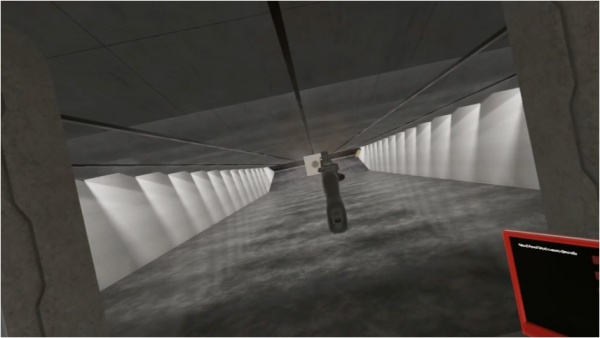
Firing the Raider. Being a short-barreled rifle in every sense except that of the law, the Raider produces a suitably impressive muzzle flash; however, this isn't exactly something that can be captured well in a still frame.
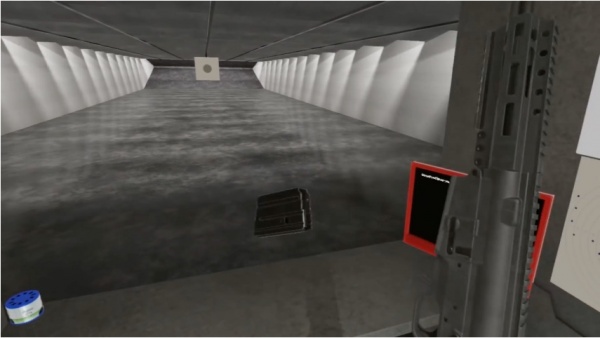
Removing the now-empty magazine; while these drop free from most AR-pattern rifles, the Raider's grip is too far back for the magazine release to be accessible with the firing hand, so the magazine has to be removed manually.
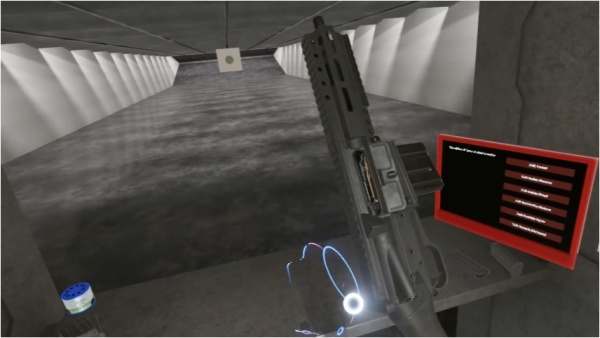
Furthermore, while the bolt does lock back, the Raider doesn't actually have a bolt release.
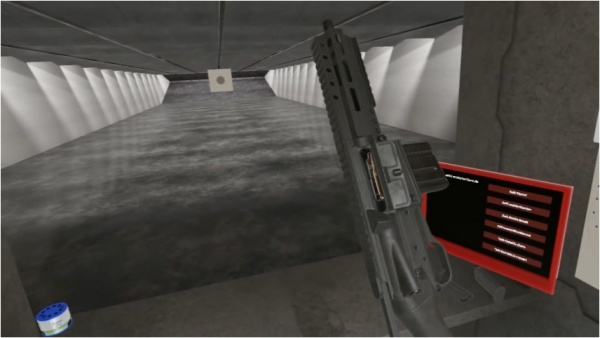
As such, the bolt must instead be returned to battery with a quick tug of the charging handle.
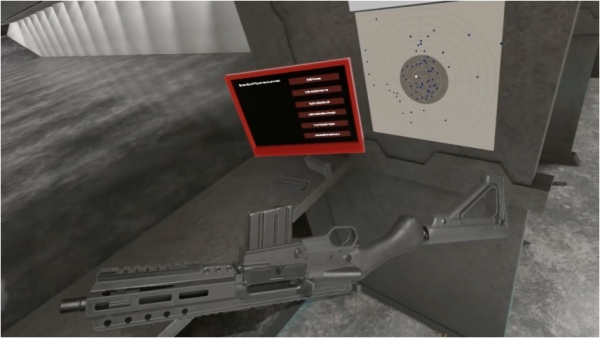
As if the whole situation wasn't strange enough already, the Raider in-game is compatible with all of the stocks that can be attached to actual handguns, allowing for the creation of odd-looking carbines like this.
Heckler & Koch MP5SFA2
Interestingly, Update #63's collection of Heckler & Koch MP5 variants included the MP5SFA2, a variant of the MP5A2 with a 2-position safe-semi fire selector, developed as a pistol-caliber carbine for police use.
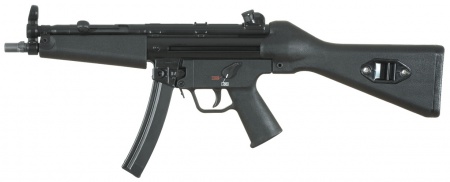
Heckler & Koch MP5SFA2 - 9x19mm Parabellum
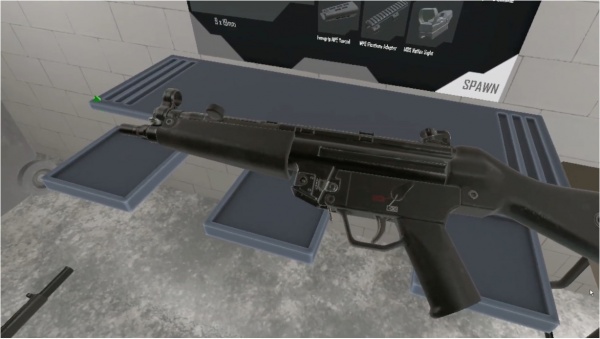
Examining the MP5SFA2. Like an MP5A2, but, y'know, SF.
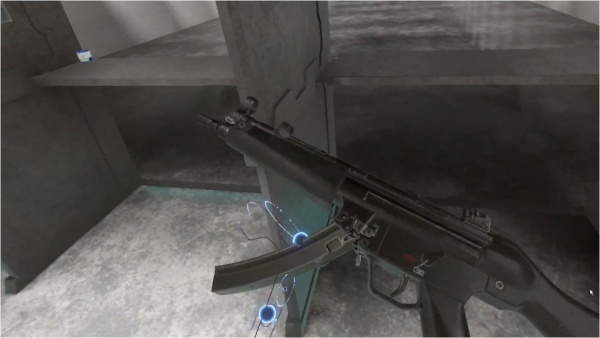
Loading in a standard 30-round magazine.

Pulling back the charging handle.
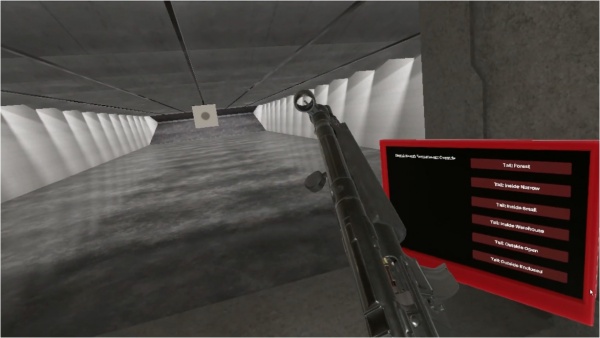
This is followed by a quick brass check. Just to be sure.
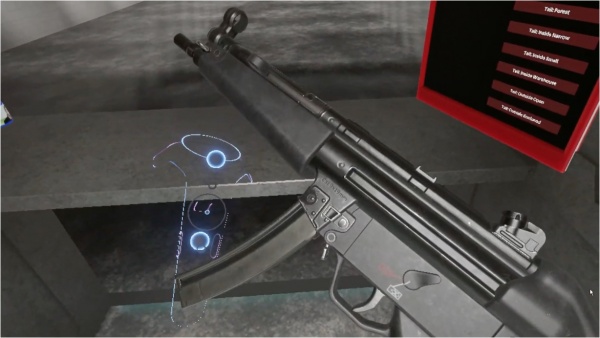
Taking a look at the lower, and flipping the selector switch from the first of its 2 positions...
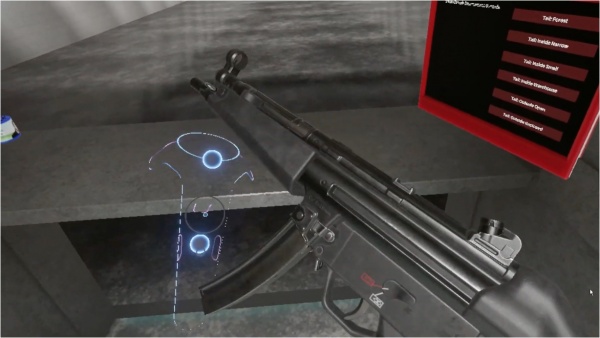
...to the second. Apparently the selector also doubles as a lightswitch.
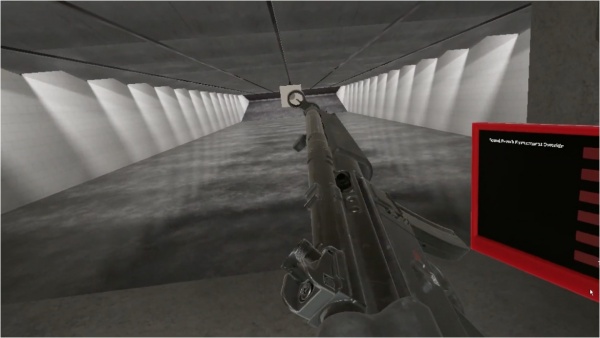
Checking to make sure that the safety's still off on this side, too. And also seeing that the bolt has somehow locked itself open.
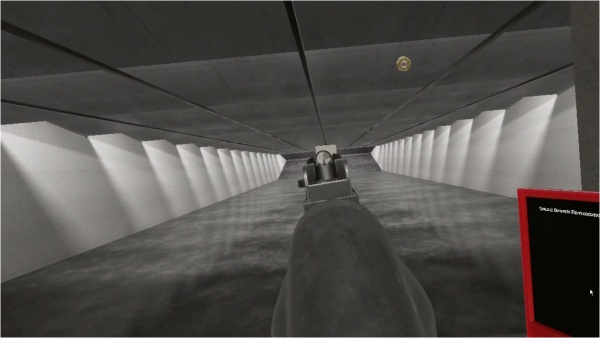
...and laying down the law, one round at a time.
Heckler & Koch MP5SFA3
Complimenting the MP5SFA2, the MP5SFA3 (a semi-auto carbine version of the Heckler & Koch MP5A3) was also added in Update #63.
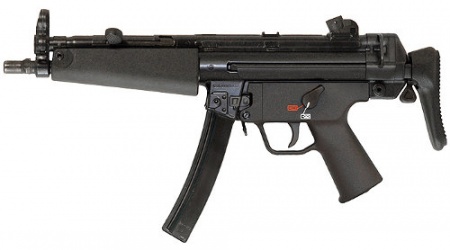
Heckler & Koch MP5SFA3 - 9x19mm Parabellum
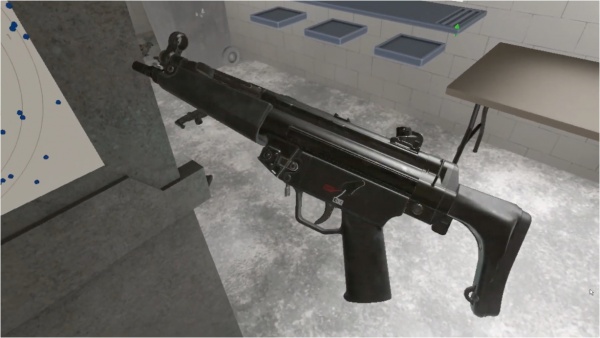
Examining the MP5SFA3. Like the MP5SFA2, but, well, A3.
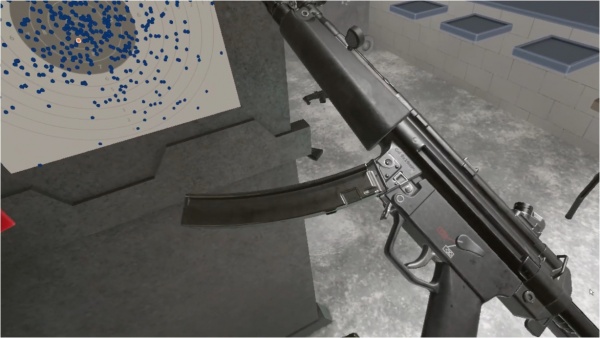
Once more, same as before, loading in a 30-round curved magazine.
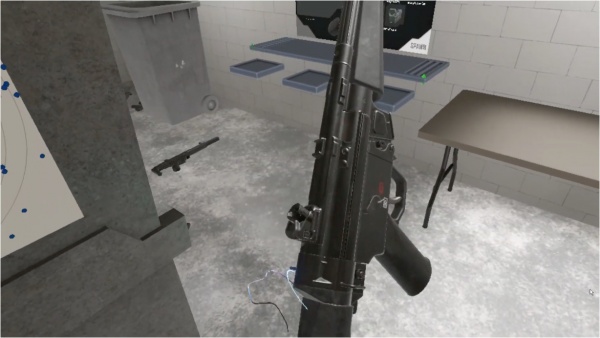
Flipping the carbine over...
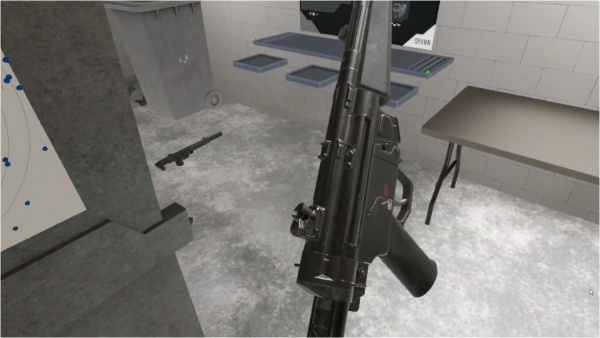
...extending the stock...

...and disengaging the safety.

Giving the charging handle a quick tug, while observing a target that probably should've been cleared a couple hundred rounds ago.

Attempting to line up the sights, and...
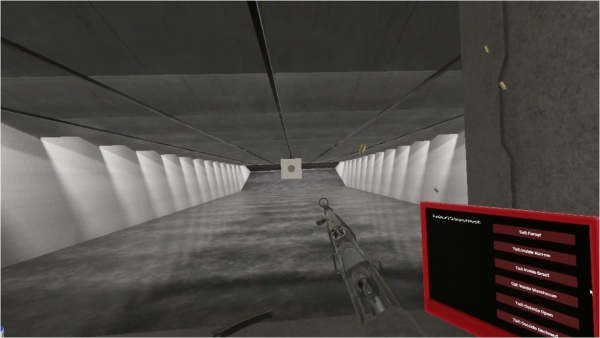
...
"Bah, to hell with it."Henry 1860
The Henry 1860 was added on day 10 of the Meatmas 2020 Advent Calendar event.
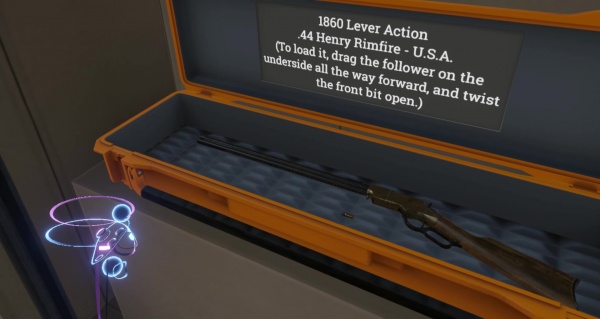
The Henry in its box - another oft-requested addition, in the game at long last.

Taking a step outside the bunker to admire the Henry: this is the left side...
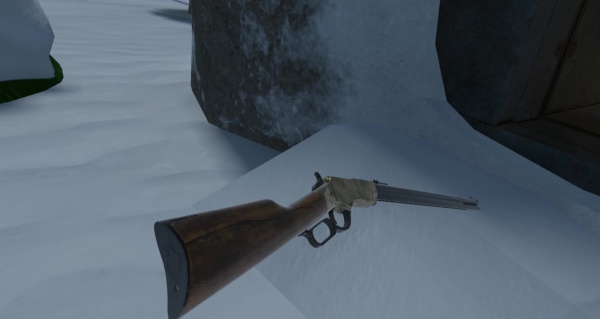
...and this is the near-identical "opposite" side, because the site won't let me create a file that calls it the "right" side for some reason.

"Alright, now how do I load this damn thing again?" 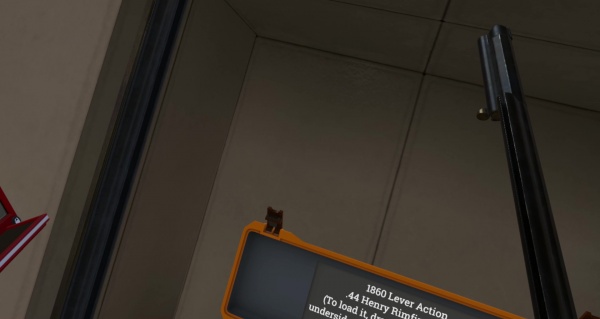
Following the instructions helpfully printed on the inside of the box, and twisting the pushed-forward follower to the side - it'd be easy to not understand this at first, given that the mechanically-similar
Volcanic Repeater (which was the Henry's direct predecessor) used a simplified system at first; it was later adapted to (correctly) work the same way.

Loading a single .44 Henry Rimfire round - added along with the rifle - into the magazine tube. Fourteen would later follow it.
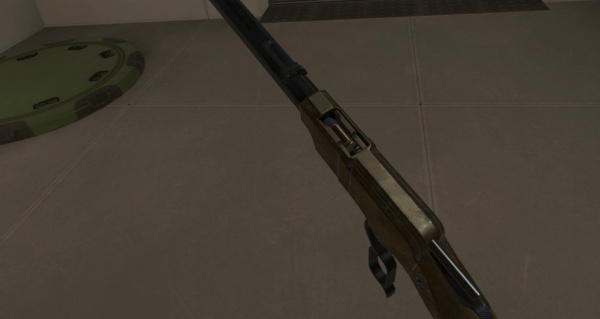
Chambering this round, with the magazine now closed; note the visibly-moving cartridge elevator. If you so desire, you can re-open the magazine to add a sixteenth round, but this is generally not considered worthwhile - if 15 rounds of .44 don't solve your problem, it's doubtful that 16 will.

Aiming the Henry at one of the bunker's walls; the sights are a nice, clear notch-and-post arrangement.

Which is good, because the muzzle flash and black-powder smoke cloud the rifle produces can obscure your view of your target for a moment - and in the Winter Wasteland, that can be a serious problem.
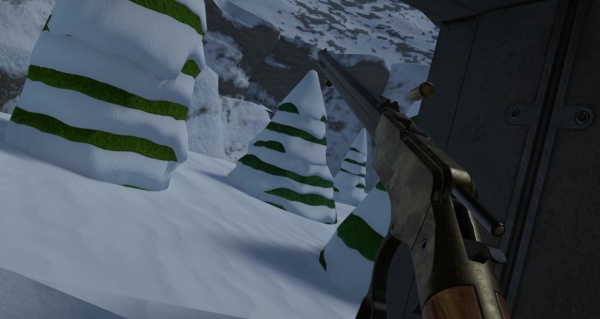
Cycling the Henry's action.
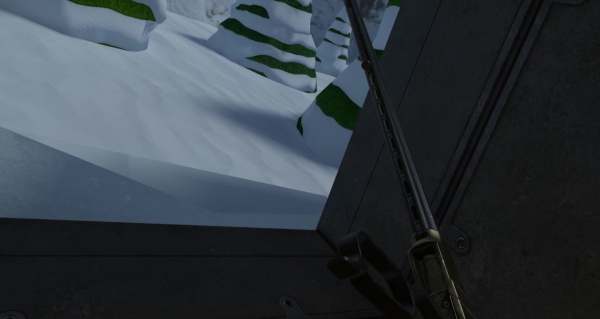
Doing so a few more times produces a picture like this; the open bottom and exposed follower of the Henry's magazine allows for a quick check of how many rounds are left in it. Also note the bottom of the elevator, which is currently busy elevating a round. Or, since the rifle is upside-down at the moment, depressing it.
KRISS Vector CRB
The KRISS Vector CRB, a long-barreled civilian carbine variant of the full-auto Vector, was added at an unclear point (presumably post-Update #53, since that was when the long-barreled full-auto Vector was removed from the game); it cannot be attained normally, instead showing up in Take & Hold as a rare drop when playing as Ricky Dicky Random, or as a slightly less rare drop from 3-point pistol-caliber carbine rolls when playing as Zombiehunter Zeke. Like the older version, it is a Gen I Vector, but fitted with the barrel shroud of a Gen II Vector CRB Enhanced, along with an AR stock adapter to which a Magpul MOE fixed carbine stock is attached.

Gen II KRISS USA Vector CRB Enhanced - .45 ACP / 9x19mm Parabellum
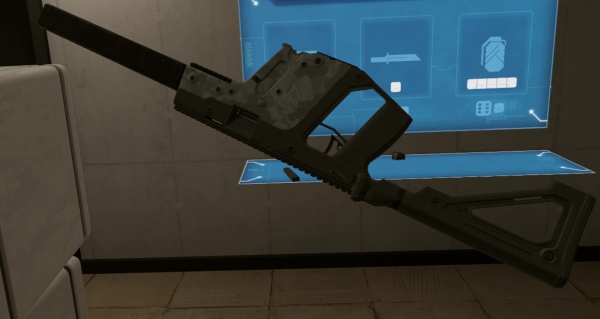
Rolling for a random gun, Ricky finds himself surprised by the inexplicable presence of a gun removed a couple dozen updates ago.
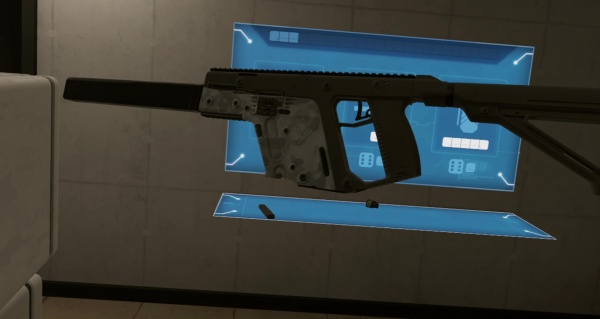
Still, he can't help but feel like there's something missing from it.
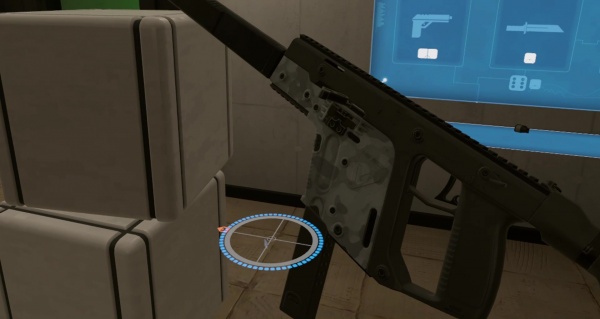
And no, it's not just a shot of the thing being loaded.
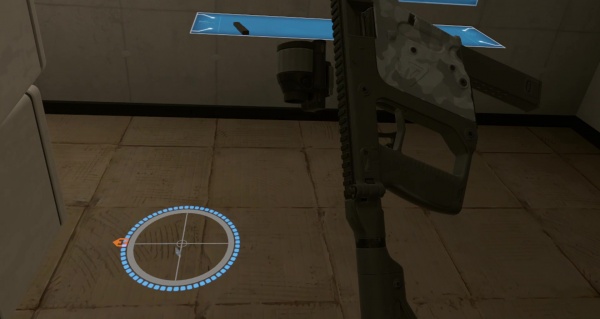
You could say "sights", but those were always missing from the Vectors. You could also say "the foregrip that they used to have", and you'd be right, but that's not the joke that this section is working towards, so please don't say that.
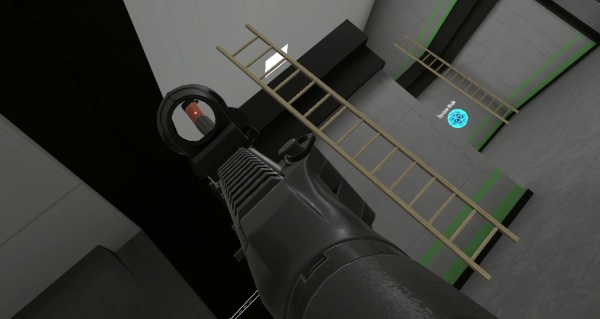
Aiming through the now-affixed Trijicon SRS-2 red-dot sight at a point-guarding Sosig...
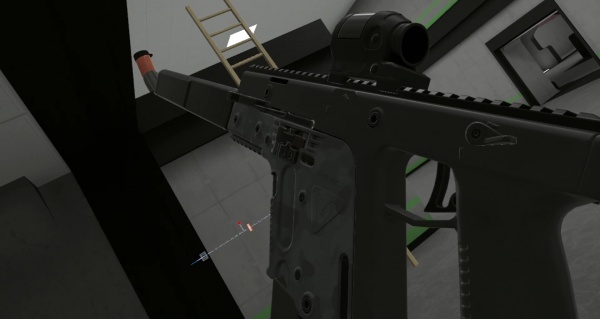
...and then, as is tradition, belatedly remembering to turn off the safety.
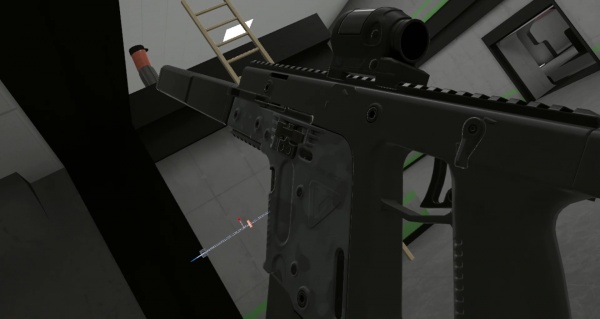
In doing so, Ricky realizes the bit that's missing: a second switch. The original long-barreled Vector was simply an SMG with a CRB's barrel and shroud, whereas this one is a proper semi-auto-only carbine.
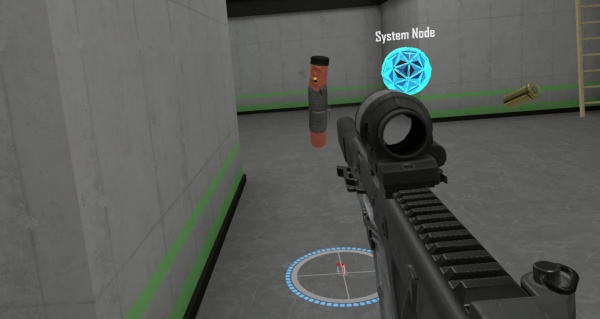
Popping another guard with the carbine; the relatively small muzzle flash and low recoil make it a bit hard to show what's going on at times.

Having finished a hold with it, Ricky concludes that the carbine Vector is, apart from the 16" shrouded barrel and lack of a giggle switch, pretty much identical to the SMG version. Case in point: both have side-folding AR stock adaptors.
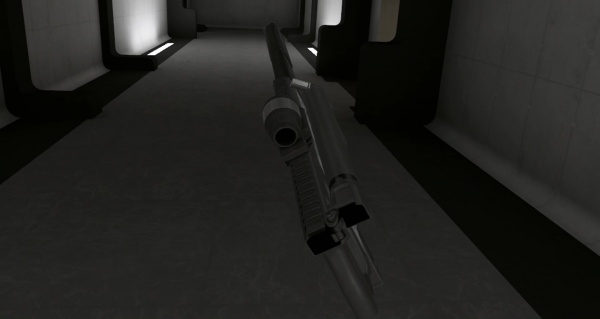
And, just like the regular Vector, actually folding this stock does rather interesting things to the ejection pattern.
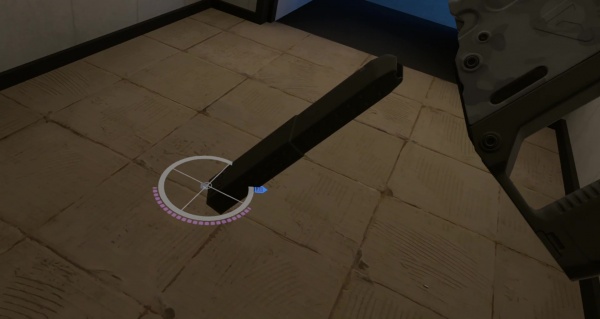
Having run dry after a supply-point clearing that was far more frenetic than it needed to be, Ricky pulls an empty magazine out of his Vector.

He then crams in
a loading shot, since this page was missing one a fresh mag, full of .45 ACP armor-piercing incendiary rounds. Yes, you read that right.
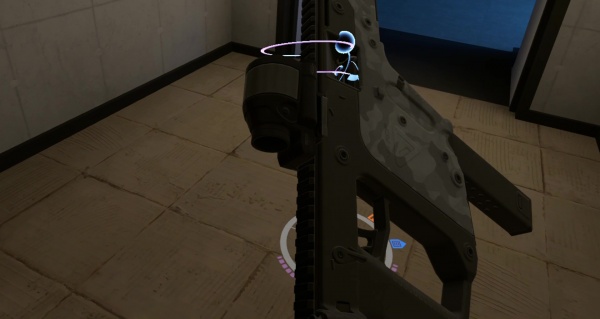
Chambering one of these rounds with a smack of the bolt release; since the player's hands aren't physical in-game, clipping them through a weapon as seen here is common enough to be the
de facto norm.
Lee-Enfield No.4 Mk.I
The Lee-Enfield No.4 Mk.I, the standard rifle of the British Army and the armies of the Commonwealth during the Second World War, was added to H3 in Update #52. Update #76's first alpha build included, among other things, a bayonet for the rifle, an attachable scope, the ability to remove and replace the rifle's magazine (correct, though as they were only issued with one magazine there was little point in doing so in the field), and a fixed wooden cheekrest, the latter of which effectively turned the rifle into the No. 4 Mk.I (T) variant. It also included two other versions: a sawn-off variant (a la the "Obrez", though some earlier Mk.III SMLE rifles were sawn off in a similar manner for trench fighting during WWI), and a variant with a leather cheekrest/cartridge holder, a shortened barrel, and a positively enormous integrated suppressor; being an invention of the Enfields' modeler, the Swedish 3D artist Stefan Engdahl, the latter is referred to as the "Swede Mod".

Lee-Enfield No.4 Mk.I - .303 British
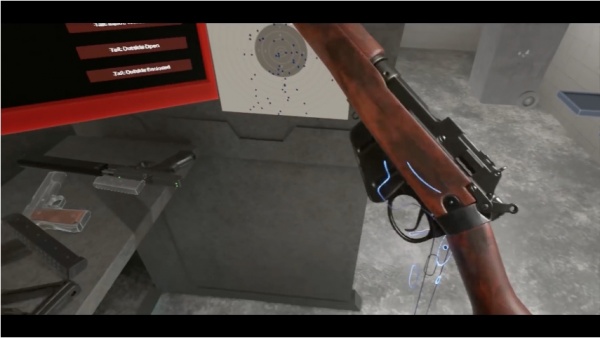
A good closeup view of the No.4's action.
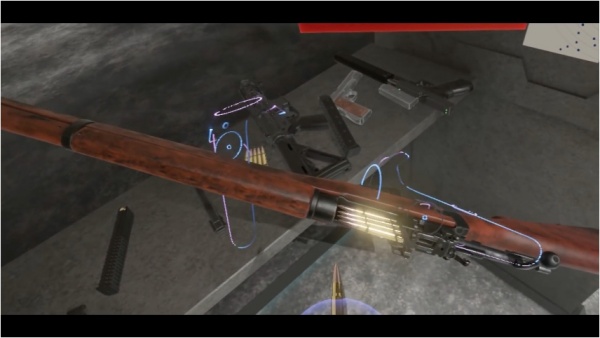
Loading the rifle with the first of two 5-round stripper clips.

Sending the bolt into battery, and a .303 round into the chamber.
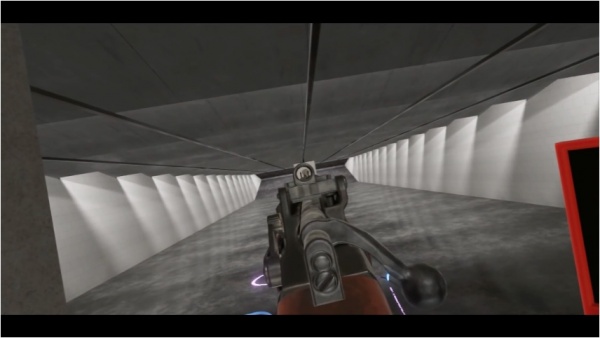
Taking aim at the target. In the period between this shot and the previous one, the safety was turned off.

To maximize the weapon's rate of fire, one can use this...
interesting technique.

Lee-Enfield No.4 Mk.I (T) - .303 British

A shot of the various Lees on a table, displaying the distinctive (T) stock of the updated No.4.
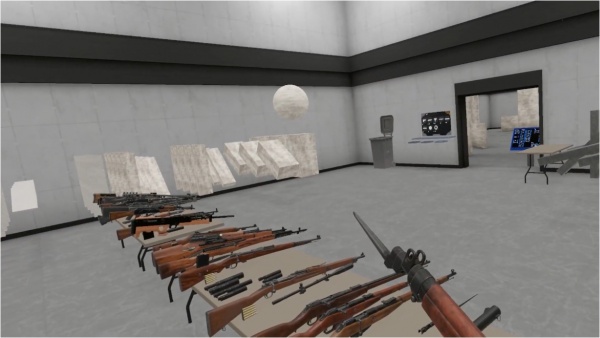
Affixing a bayonet to the Mk.I (T).
"Lee Enfield Obrez"
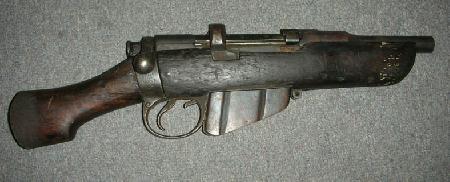
Sawn-off Lee-Enfield No. 1 Mk.III SMLE - .303 British

"Wait a minute... what are you?" 
Yep, this is a thing. It's not quite identical to the reference image (being a No.4 instead of an earlier SMLE, since the role that a sawn-off rifle would fill had largely been superseded by submachine guns by the time WWII rolled around); it also still has its front sight, for reasons unclear.
"Lee Enfield SwedeMod"
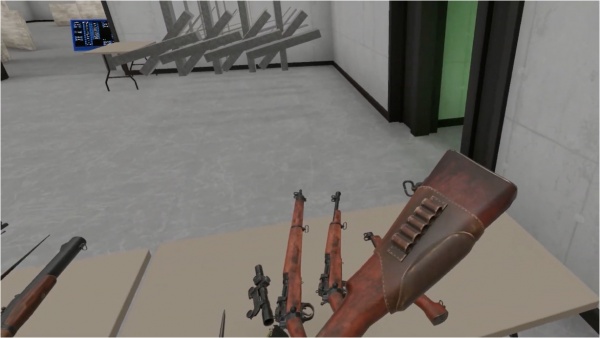
Meanwhile, we have what appears to be a mostly normal-looking Lee-
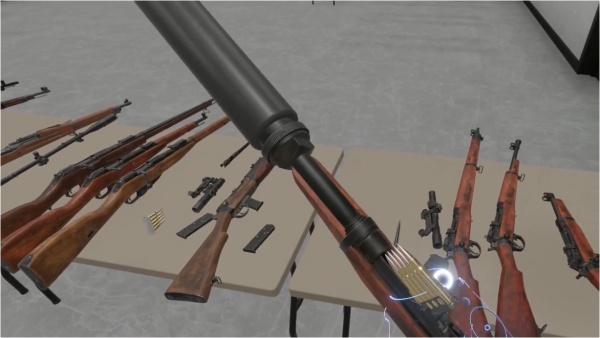
Attempting to load the rifle with a stripper clip.
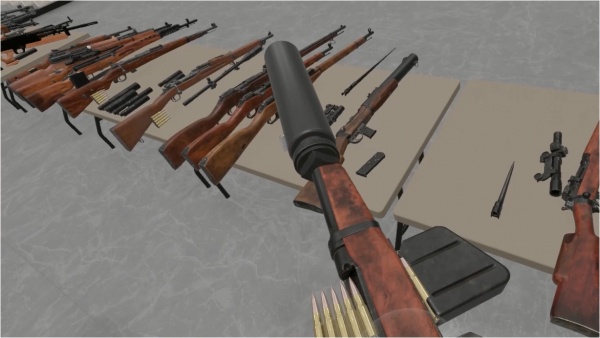
There being no magazine in the rifle, this is met with limited success. The magazine going in in this shot is also fully loaded, so the whole stripper clip affair would prove to be quite unnecessary in the long run.

Giving the sights a try; with the sheer size of the integral suppressor, the rear sight has to be set to one of its longer-ranged positions just to get a picture.
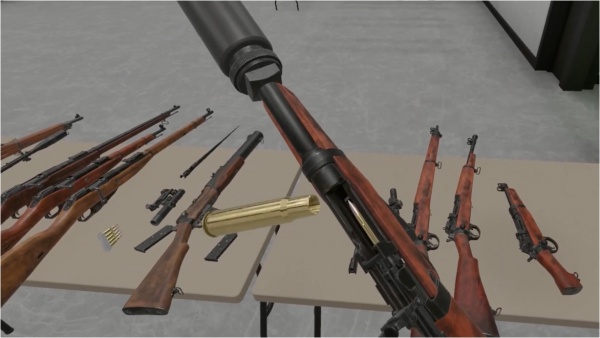
Working the action to eject a spent case, which makes the rather dramatic move of throwing itself directly at the camera.

If you don't find the raised sights to be to your liking, the modified Enfield is also compatible with the same No.32 scope as the Mk.I (T).
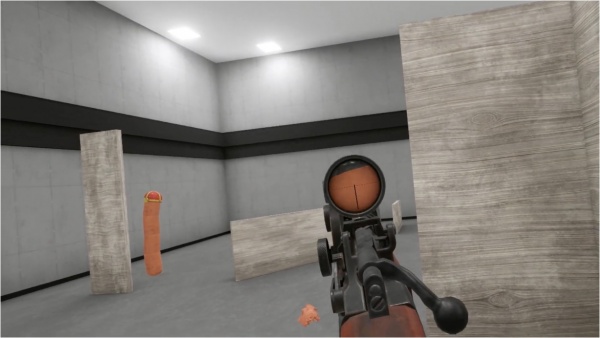
Aiming at a Sosig's head through the scope...
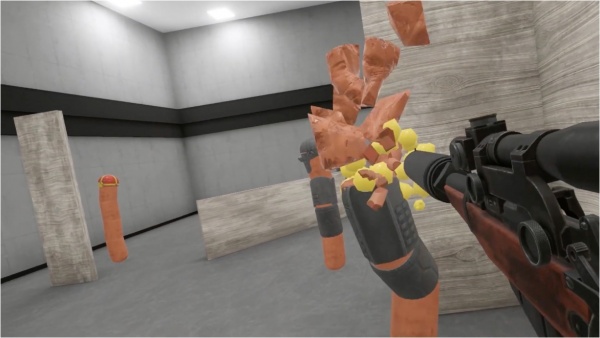
...before ignoring everything in the above shot altogether.
Lee-Enfield No. 5 Mk I "Jungle Carbine"
Along with the aforementioned variants, the 1st alpha of Update #76 added a Lee-Enfield No. 5 Mk I "Jungle Carbine"; like the De Lisle Carbine, its action takes priority over its length, and it is thus classified as a bolt-action rifle rather than a carbine.

Lee-Enfield No. 5 Mk I "Jungle Carbine" - .303 British
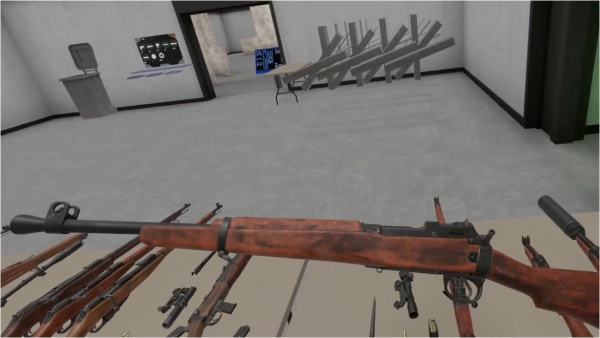
Inspecting the Jungle Carbine's left side.

As for the right side, the Carbine couldn't afford to get its own full set of screencaps, so it had to share a table shot with the No.4s. Tragic, I know.
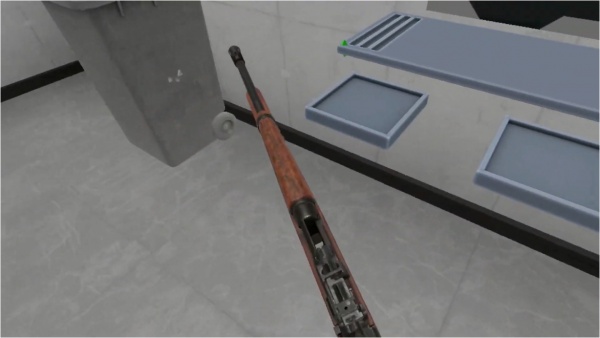
Luckily, after a few months of work at the sawmill, the No. 5 managed to scrape together enough money for screencaps of its own. Here's one of the bolt being opened...
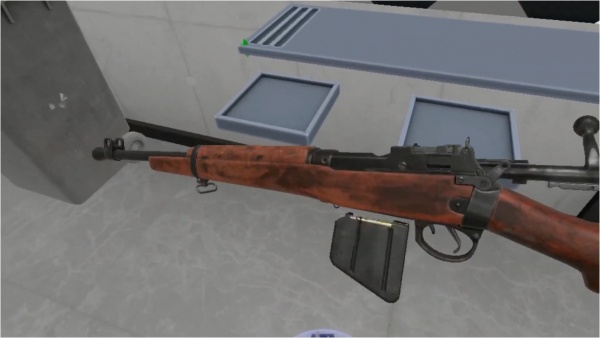
...and another of a magazine being loaded...

...and a third of a round getting chambered! All done by a fancy, big-city man, with one of those new-fangled... what're they called again? Chimeras?
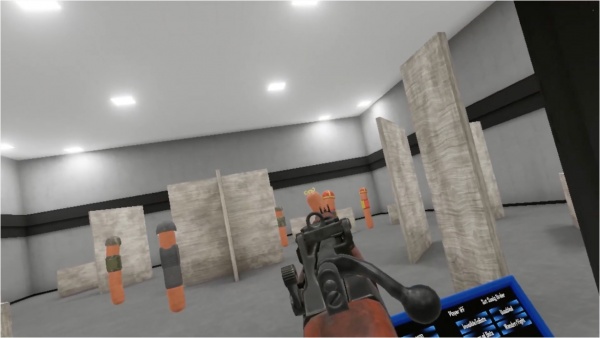
Looking past the sights at a Sosig; the No. 5 uses the same aperture/winged post setup as the full-length No.4 upon which it was based.
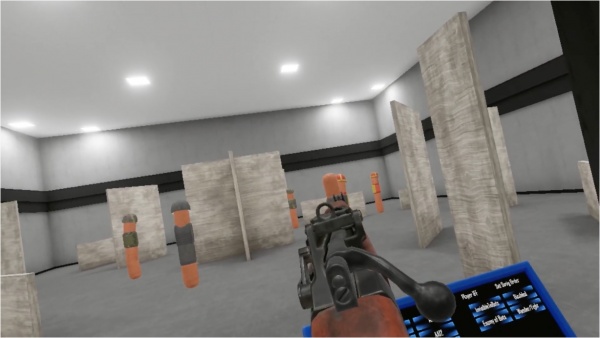
Switching off the safety...
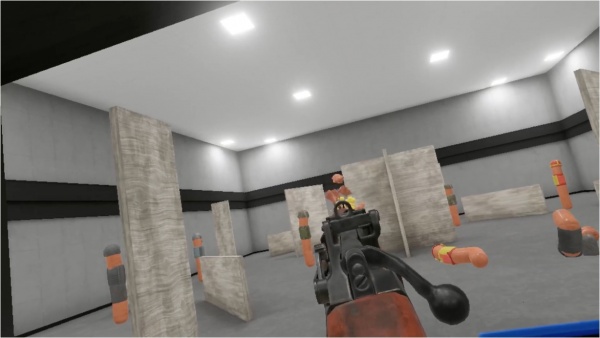
...and shooting a different Sosig, this time at least attempting to align the sights.
Luger 1902 Carbine
The last of the 3 Update #52 Luger variants is a rare full-stocked carbine. The in-game model lacks the real Carbine's grip safety.

Luger Model 1900 Carbine - 7.65x21mm Parabellum
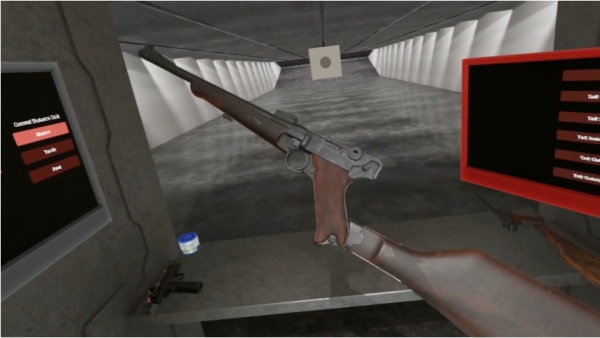
Admiring the Luger Carbine. If it's good enough for Kaiser Wilhelm, it's probably good enough for you.
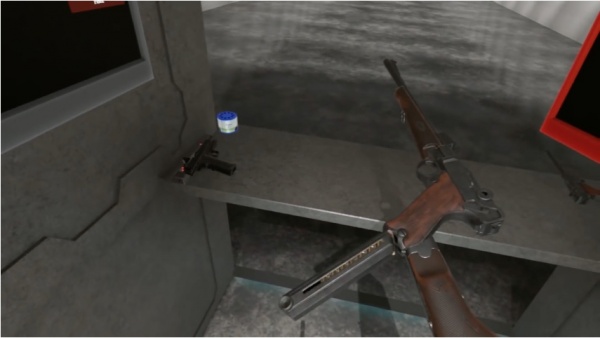
Loading in a full magazine of 9mm Luger; the vast majority of Luger Carbines are in 7.65mm Luger, but at least one 9mm version is confirmed to exist.
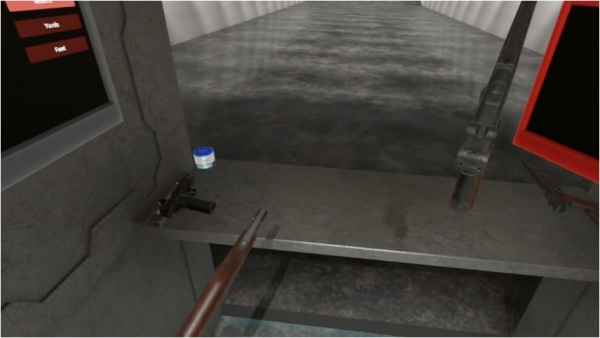
A quick check reveals that the stock is, in fact, detachable; this is one of many new mechanics and features coming in Update #52.
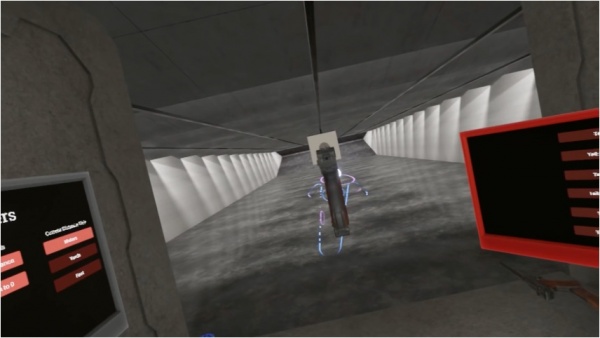
Taking aim with the carbine, sans stock.
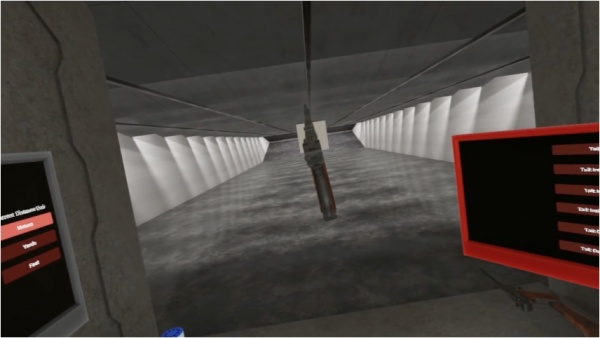
Firing a round at the target.
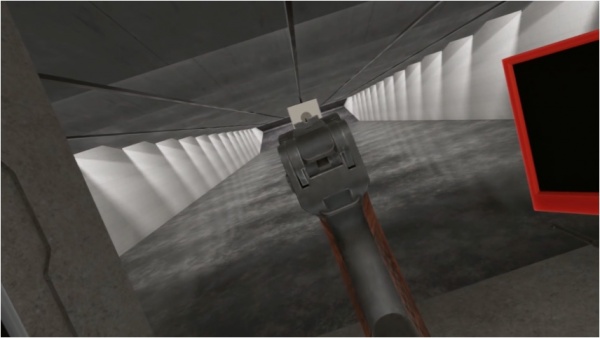
"Well, that was a terrible idea."
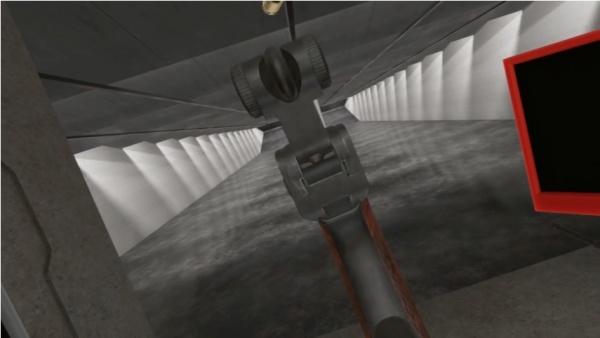
After realizing the mistake of doing without, the carbine is fired properly - that is, with a stock attached.
M1 Carbine
Update #48 added the M1 Carbine. It is a late-war/post-war model (with a bayonet lug and adjustable aperture sights), and can accept either 15-round or 30-round magazines of .30 Carbine. Update #51 made a variant with a permanently-attached M84 scope available as well; Update #52 replaced this with an attachable version of the scope.

M1 Carbine (late-war/post-war) - .30 Carbine
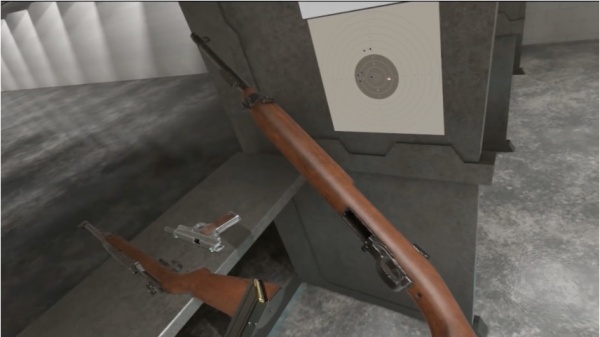
"Wait, where does this thing go again?"
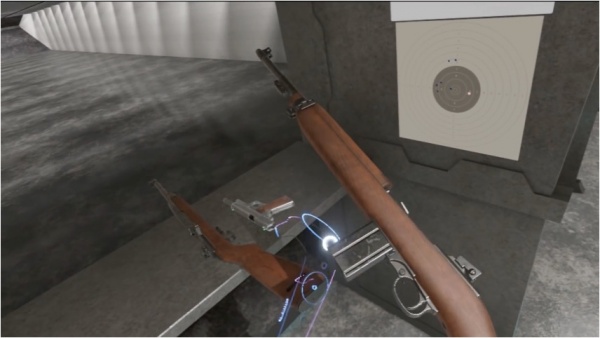
"Oh, okay. Yeah, that makes sense."
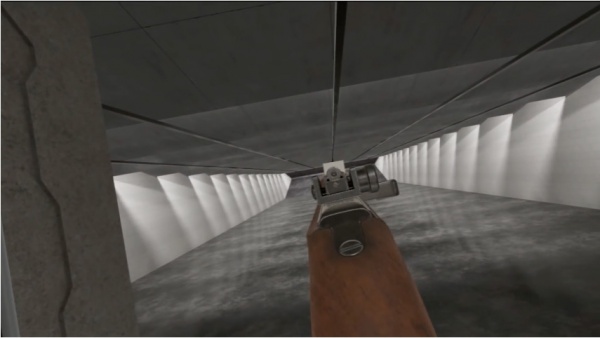
The Carbine's sights. They're a bit small, but quite usable.
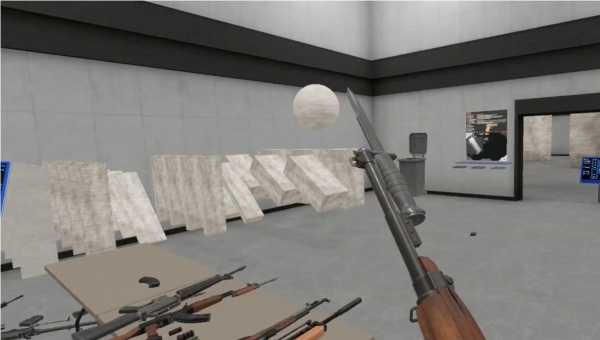
With the release of Update #76's 1st alpha, the late-war bayonet lug became more than just an aesthetic feature, allowing for the attachment of an M4 bayonet (also compatible with the M2 below, for obvious reasons).
M2 Carbine
Along with the M1 Carbine came its select-fire relative, the M2 Carbine. The M2, like the M1, has the late-war pattern of sights and a bayonet lug. It also has a metal heat shield; this was likely both due to the increased amount of heat that the M2 is likely to produce, and to make the M2 more visually distinctive. As with the M1, the M2 gained a variant with an M84 scope following Update #51; also like the M1, this variant was removed, and replaced with an attachable version of the M84 scope.

M2 Carbine (with sling and 30-round magazine) - .30 Carbine

M1 Carbine with heat shield - .30 Carbine. Image provided to show the metal heat shield used on the in-game M2.
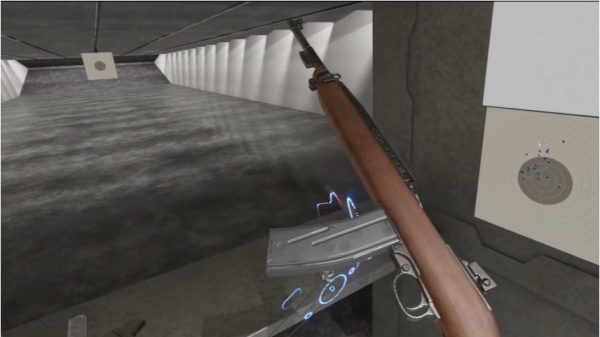
The M2 Carbine, complete with 30-round magazine.
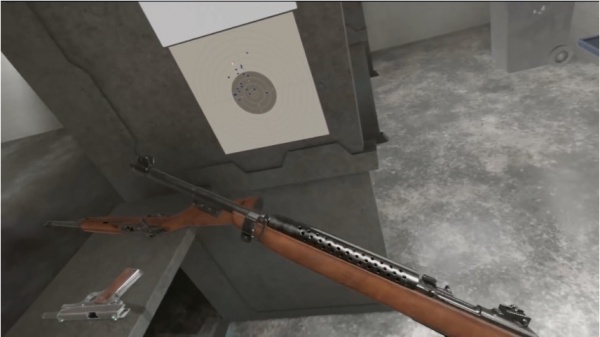
Taking a look at the M2's metal heat shield. Note also the bayonet lug and adjustable sights, confirming both this and the M1 (which also has these features) to be late-war models.
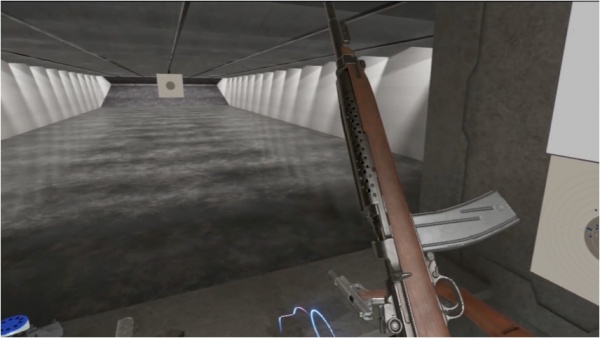
Letting the M2's charging handle drop into battery after pulling it back.
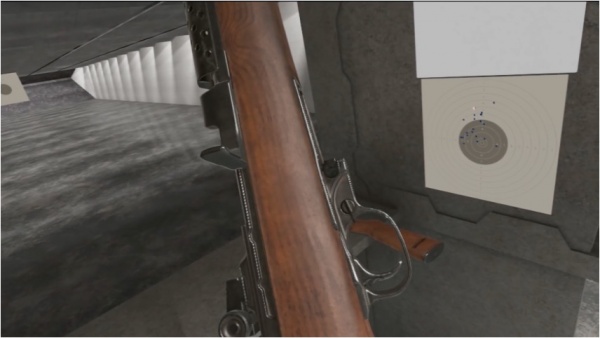
Manipulating the Carbine's safety. This control is the same on both the M1 and the M2.
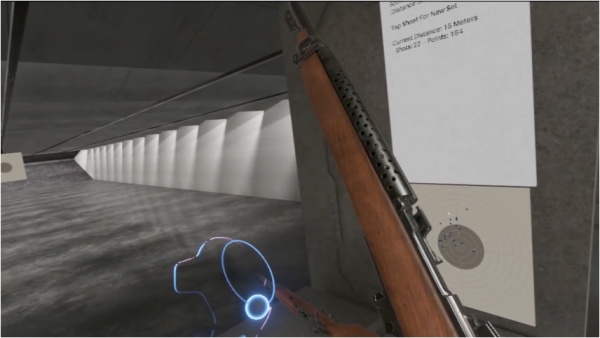
This one, however, isn't. This is the fire selector of the M2 Carbine, currently pushed forward for rock n' roll.
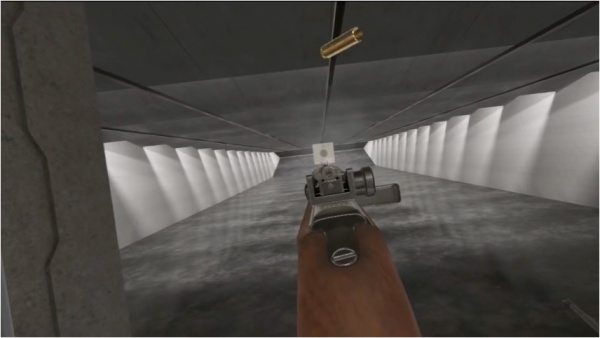
Opening fire with the M2.
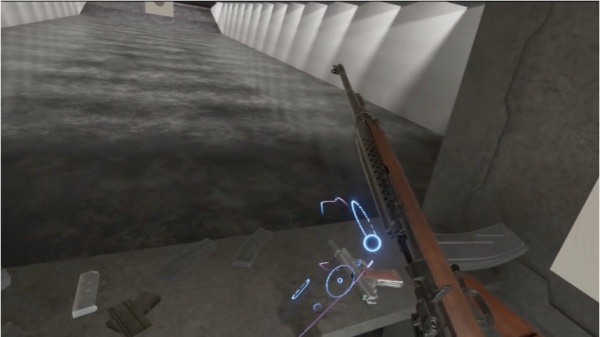
One quick mag change later, a quick tug of the charging handle to release the bolt is merited, seeing as it locks open when the weapon runs empty.
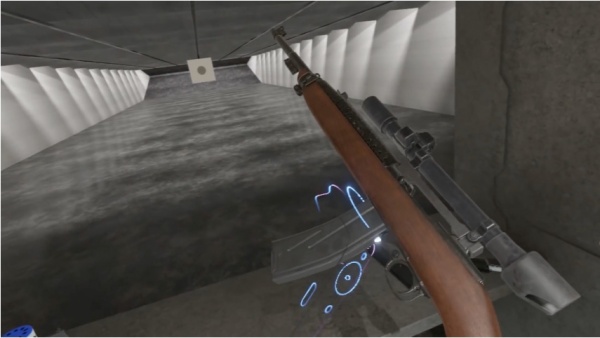
An M2 Carbine with an M84 scope attached. An unlikely combination, but not an impossible one by any means.
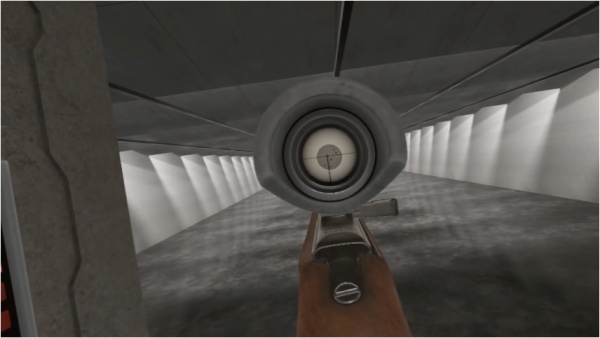
Looking through the M84 scope at a paper bullseye target.
M1903 Springfield
Update #52's 10th alpha build added a transitional-variant M1903 Springfield rifle to H3.
Screenshots courtesy of Reddit user Shubishu.

M1903 Springfield (interwar transitional) - .30-06 Springfield
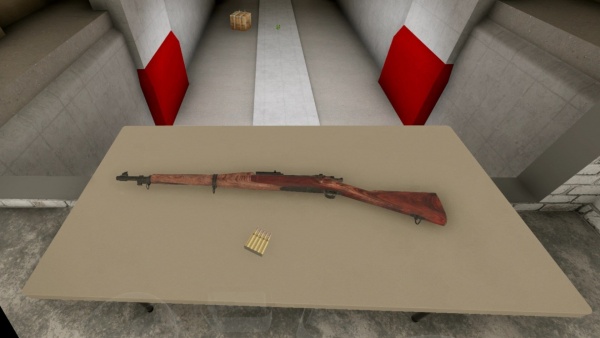
An M1903 Springfield and a 5-round stripper clip on a table, inside the Sniper Range. Competition-oriented rifle or not, iron-sight sniping is a daunting task.
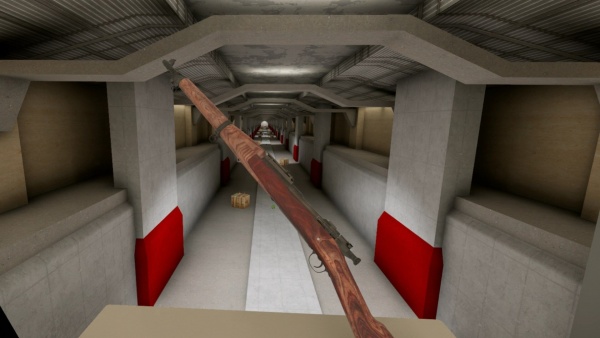
Examining the Springfield. The barrel-mounted rear sight, straight-wristed stock, and lack of grasping grooves in the forend peg this rifle as a somewhat more seldom-seen transitional model, manufactured between the WWI-era original and Mark I variants, and the later M1903A1.
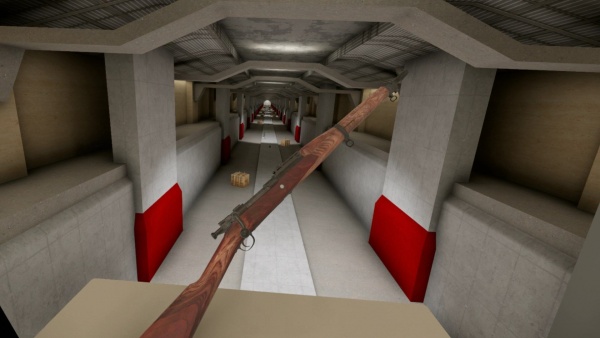
The other side. Note the interesting pattern of the stock's wood grain; this mis-matching could possibly indicate that the rifle was repaired at some point in its lifetime, possibly a personal restoration of a sporterized surplus rifle to its former glory.
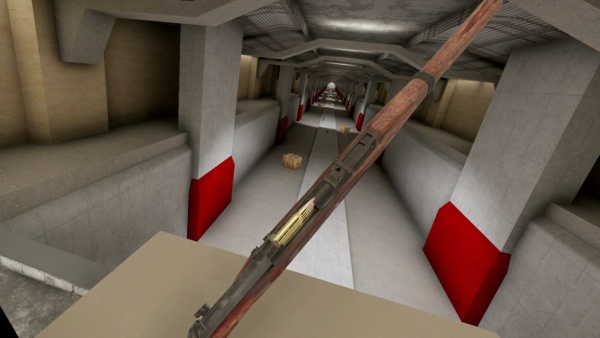
Then, in a surprise plot-twist, the stripper clip that showed up a few screenshots ago turns out to be incredibly important to the central plot! This shocking twist surprised... absolutely nobody.

Disengaging the
Mauser-type flag safety, common to rifles of the era. It especially makes sense on the Springfield, since it is, for all intents and purposes, a Mauser-pattern rifle.

Aiming the M1903; being designed in substantial part for long-range competition target shooting, the M1903's sights are small and precise. This is nice and all for long-range shooting, but can be a bit tricky to use for closer, faster shots.
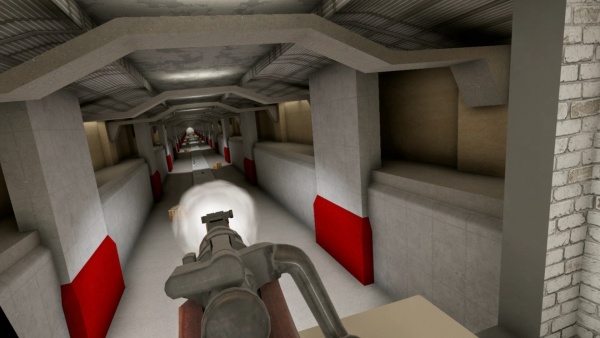
Putting an end to the squint-fest of aiming by firing off a shot; note that the striker, previously off of the bottom of the shot, is now in full, plain view.
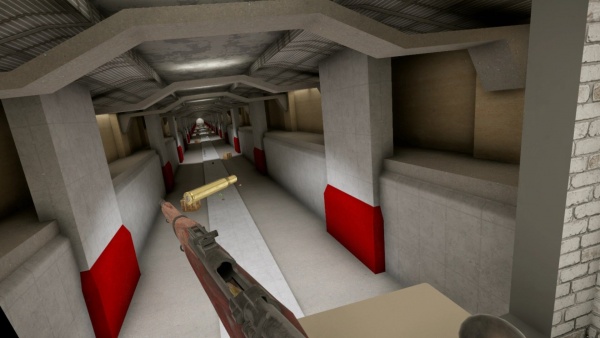
Observing the damage done to the targeted watermelon whilst cycling the rifle, preparing for another.
M1903A1 Springfield
The release of Update #76's first alpha replaced the aforementioned transitional M1903 with a later M1903A1 Springfield, complete with an attachable Unertl scope.

M1903A1 Springfield - .30-06 Springfield

M1903A1 Springfield with 7.8x Unertl scope - .30-06 Springfield
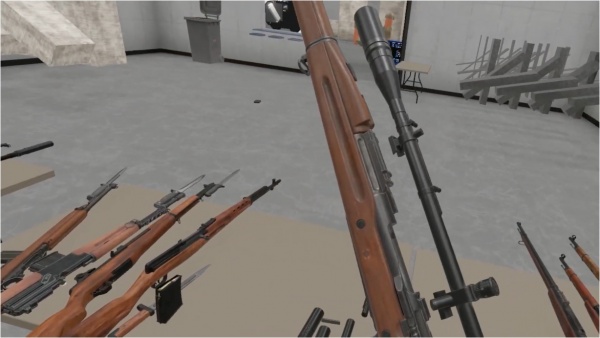
Affixing the rifle's proprietary Unertl scope...
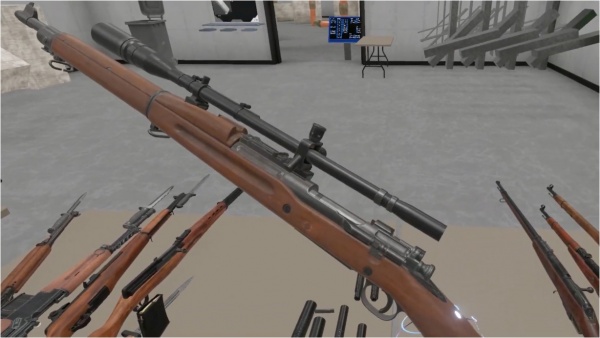
...which stretches across the entire receiver, and most of the handguard to boot.
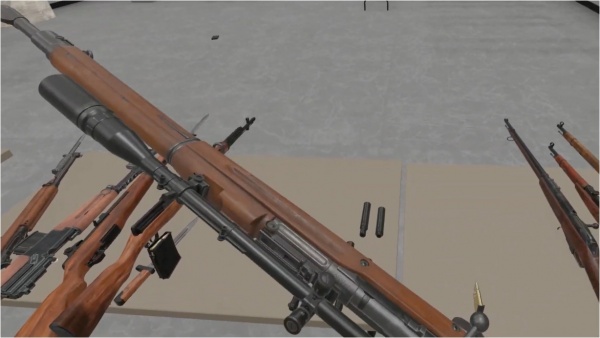
The rifle's other side, showing off the bolt handle and receiver.
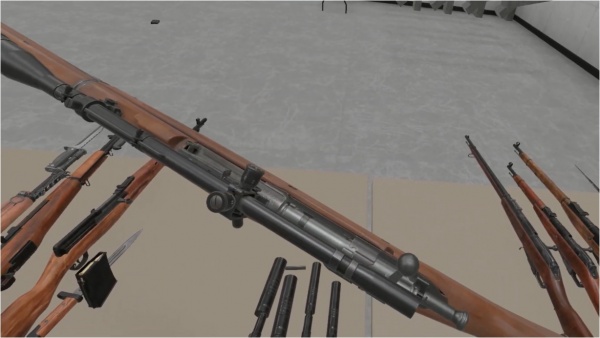
Opening the bolt; being a later-pattern
Mauser-type design, the M1903 cocks its striker when the action is opened.

As is common for scoped rifles of the era, the M1903A1's scope blocks the stripper clip guide, forcing the user to single-load.
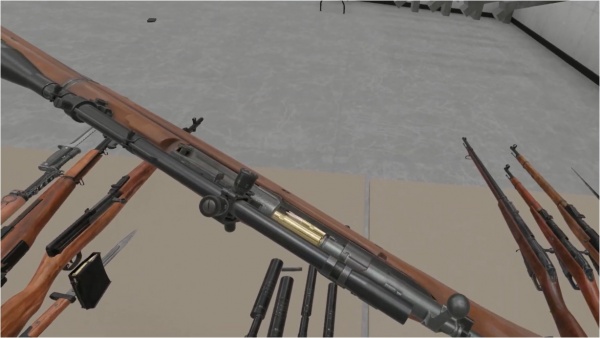
Sending a .30-06 round into the chamber.
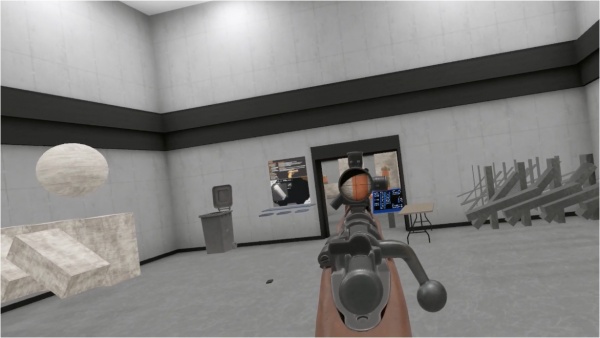
Aiming at a Sosig; even with the aim-steadying Virtual Stock system, the Unertl scope's combination of a small objective lens and a high magnification (7.8x) makes target acquisition rather difficult, as the black area at the top of the scope demonstrates.
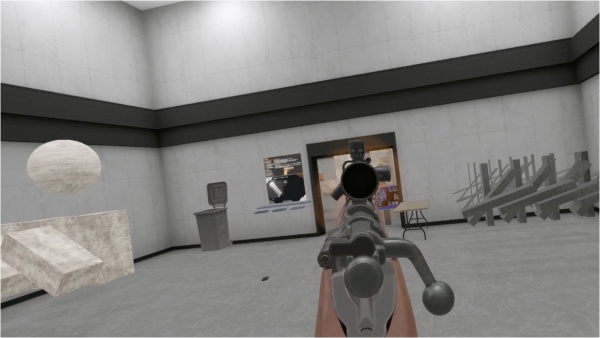
This also means that, upon firing, the rifle's vertical recoil upsets the sight picture entirely, making it difficult to tell whether or not a shot has hit its mark.
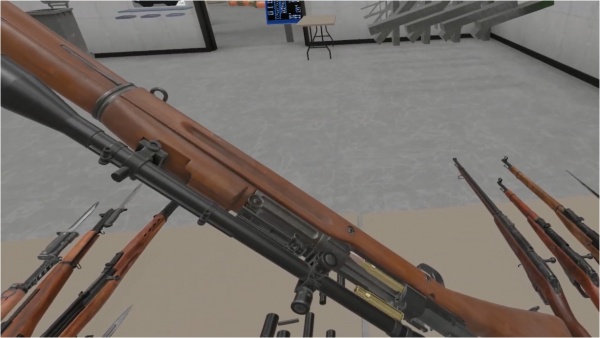
To top it all off, the position of the optic over the action tends result in cases going straight into the scope tube, as seen here.
Martini-Henry Mk. II
Another gift from the 2019 Meatmas update was a Martini-Henry rifle (more specifically, a Mk. II variant), a long-requested addition. It is categorized as a lever-action rifle in-game, owing to its lever-operated falling block mechanism; this makes it the first rifle in the category to not be magazine-fed.

Martini-Henry Mk. II - .577-450 Martini-Henry

Examining the Martini-Henry; at 49 in (124.5 cm) in length, it's a rather difficult rifle to fit on the screen.
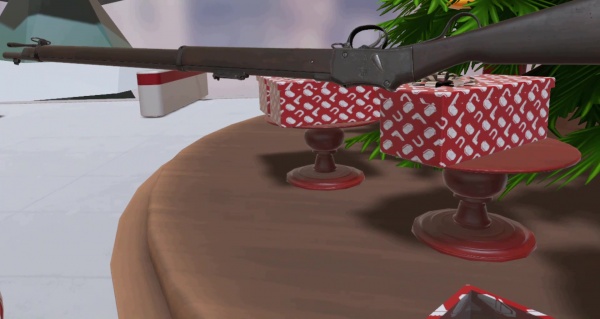
Hence why you shouldn't bother. The large-ended cleaning rod seen above, coupled with the large-sized indicator visible below, peg this as a Mk. II variant.
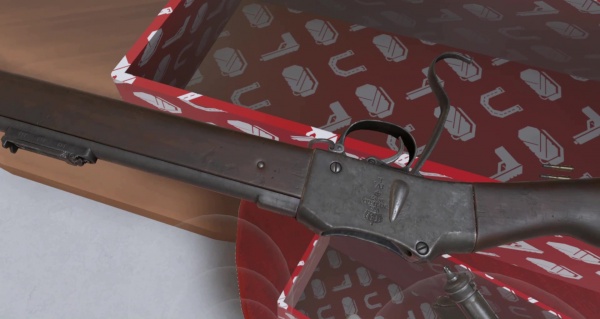
Said indicator indicates when the rifle's internal hammer is cocked; this is a useful thing to have on a rifle with no safety. The rifle's proofmarks are also visible here; perhaps one of our Australian users could lend a hand in translating them.
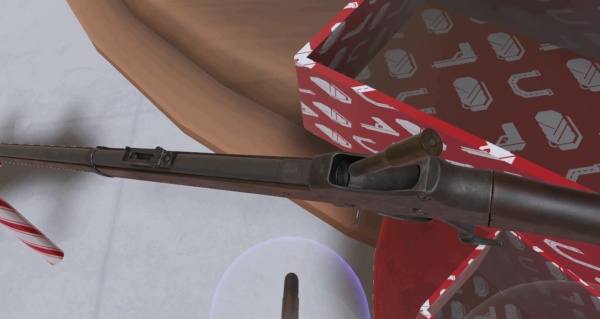
Loading in a single .577-450 round (so named for its use of a .45 caliber bullet in a necked-down .577 Snider case); these are only available in one type, that being a period-standard bottle-nosed unjacketed lead bullet.
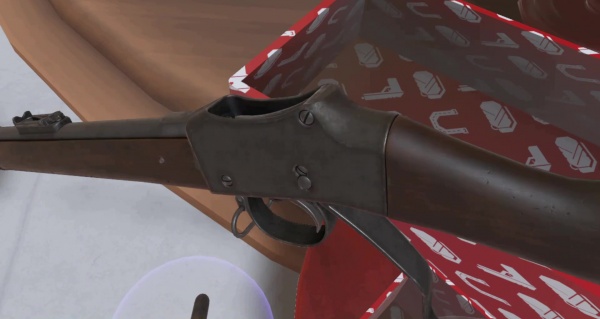
Closing the Martini can be a bit tricky, often requiring a fair bit of force; a general rule of thumb is to shake it, not stir it.
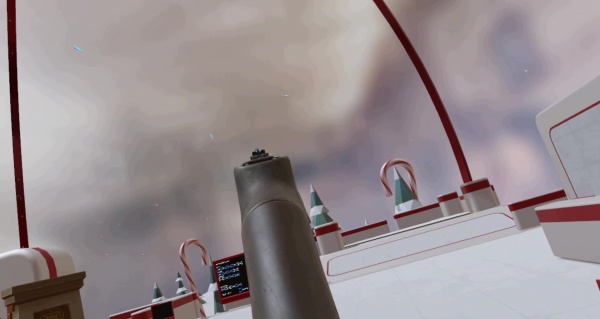
Aiming at a particularly tribal-looking snowflake. The sights are surprisingly readable; this is especially relevant on a rifle where every shot needs to count.
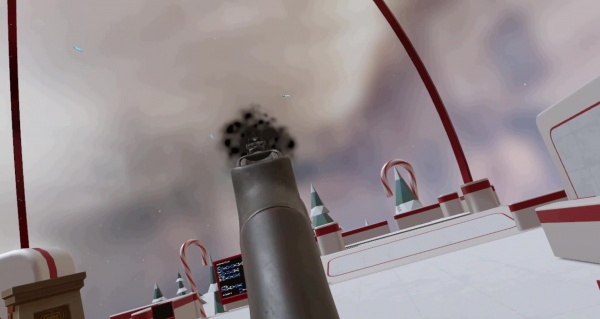
Making the shot count, and slotting the charging crystal; even if the recoil didn't obscure the target, the large cloud of black-powder smoke it produces certainly would.
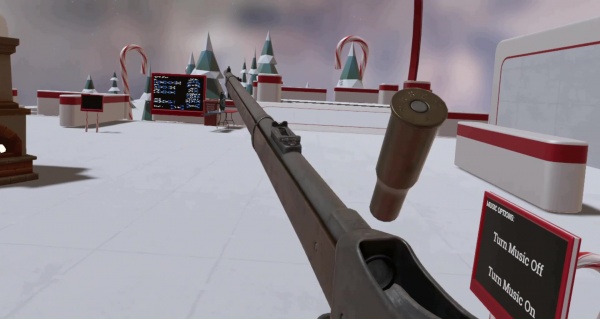
Ejecting a spent (but unfired) case, showing the "BSE" marking on its head; slightly more concerning is the "DP" marking visible on the chamber, which stands for "Drill Purpose", and denotes a rifle not considered suitable for anything beyond basic training drills (i.e. often of dubious safety to actually fire). This marking was later removed.
Mauser 1918 T-Gewehr
The Mauser 1918 T-Gewehr was added on day 12 of the Meatmas 2020 Advent Calendar event in Update #99. It is the first classic anti-tank rifle added to the game (i.e. predating modern anti-materiel rifles like the Barrett M82, and having been intended for use against actual tanks); it is also the game's oldest anti-materiel rifle, and will remain so, seeing as it was the first purpose-made anti-materiel rifle ever created.

Mauser 1918 T-Gewehr - 13.2x92mm TuF
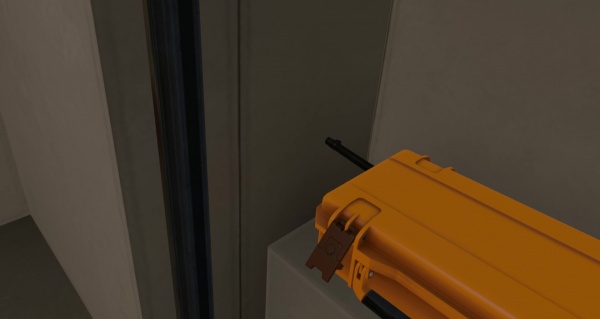
It's worth noting that weapon crates in
H3 are actually empty until the latches are popped; upon doing so with Bunker A-12's crate, it immediately becomes apparent that something is amiss.
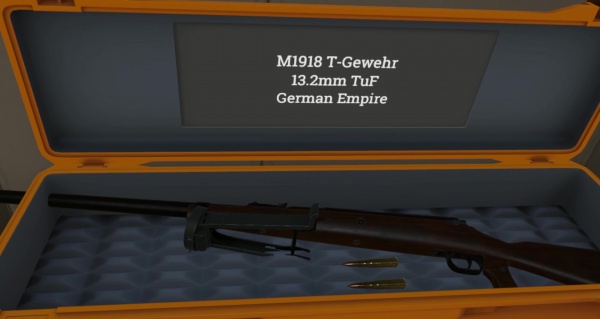
Popping open the crate's lid reveals the source of the issue: a gun that doesn't actually fit.
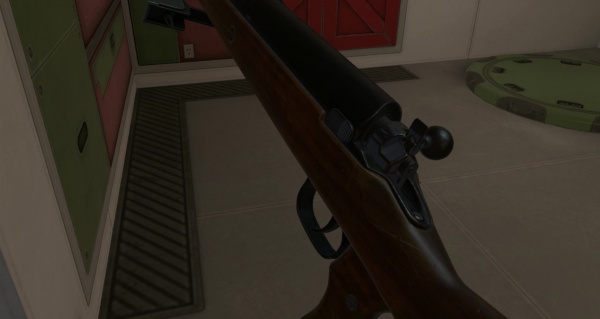
Despite its massive size, a theme you'll see throughout this section is that the T-Gewehr is essentially a scaled-up
Mauser Gewehr 98; one clear example of this is the near-identical bolt, right down to the flag-style safety.
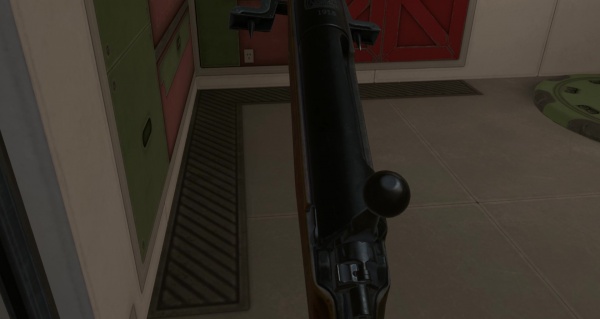
Unlocking the bolt. Note that the striker is now cocked; this makes sense, as the Mauser 98 and its derivatives are cock-on-open actions.

Loading in one of the weapon's massive (and proprietary) 13.2x92mm TuF rounds; "TuF" stands for
"Tank und Flieger", German for "Tank and Aircraft", since the German word for tanks would remain "tank" until the emergence of the term
"panzer" during Germany's interwar re-militarization.

Shoving the round into the chamber.

Stepping outside the bunker for a better look at the rifle; since it's hard to fit the whole thing on-screen, here's the front of the left side...

...and the back of the right.
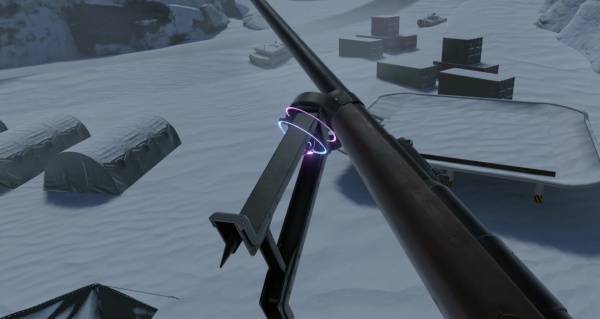
Deploying the weapon's
MG08/15-based bipod up on top of an S-COM tower; being put together in a remarkable hurry, the T-Gewehr uses a variety of pre-existing and/or slightly-modified components to minimize its toll on the already stretched-thin industrial capacity of the German Empire.
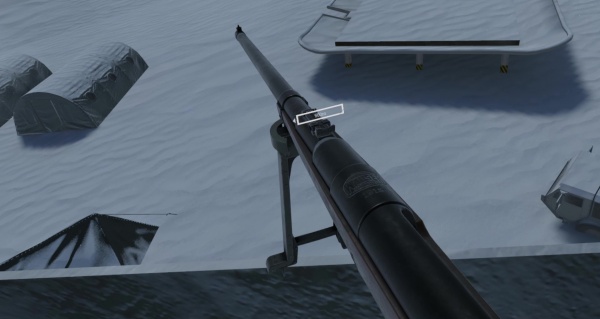
To that end, it also uses what seems to be a pre-existing tangent rear sight marked for the drop of the 13.2mm round; it could slide much further out than 500 meters' worth of elevation, but this wasn't ultimately deemed useful, given that the round likely wouldn't be effective against period tank armor out past 500 meters anyway. The T-Gewehr's receiver markings are also visible here; presumably due to the continued existence of Mauser as a company, this is apparently a "WAUSER" rifle.

Having set the sights to a range about 400 meters more than is useful, the marksman takes aim at a tank at least 62 years too modern to be vulnerable to the T-Gewehr, and an indeterminate number of years too long-abandoned to render the activity worthwhile.
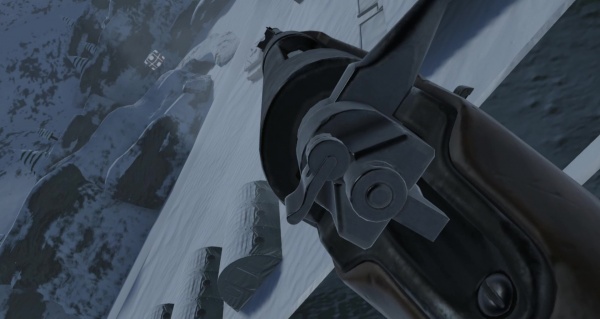
Firing in spite of all this; suffice to say, a giant anti-materiel rifle with no muzzle brake kicks rather hard.

Ejecting a spent casing, and going off in search of another target.
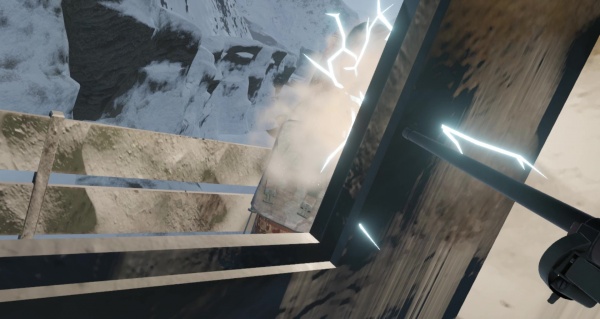
Turns out, the marksman doesn't need to look far. While it might not be useful against modern MBTs, the T-Gewehr is certainly capable of shooting through other forms of armor, like the thick metal walls of S-COM towers.
Mauser Karabiner 98 Kurz
Update #52 brought along a Karabiner 98k, furthering the game's collection of World War II-themed weaponry.

Mauser Karabiner 98k - 7.92x57mm Mauser

A clear look at (most of) the K98k. Note the earlier-pattern stock nosecap and cleaning rod, showing that this is an earlier-pattern rifle, and not the later "Kriegsmodell".
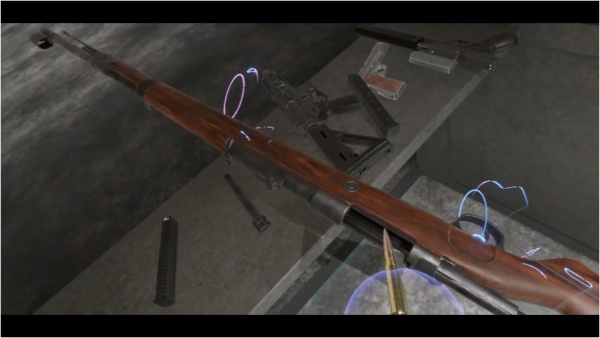
The other side of the rifle, with the bolt open.
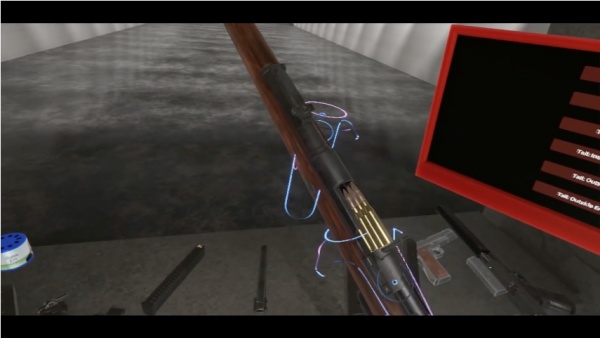
Loading the rifle with a 5-round stripper clip.
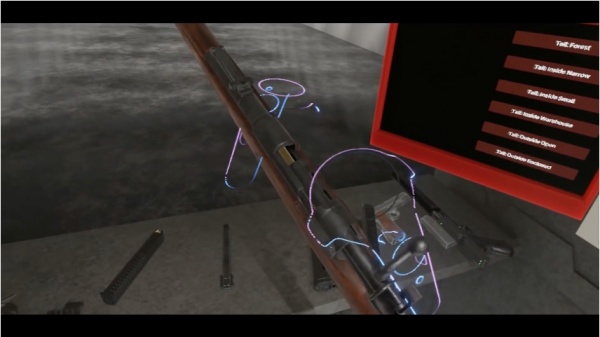
Chambering a 7.92mm round.
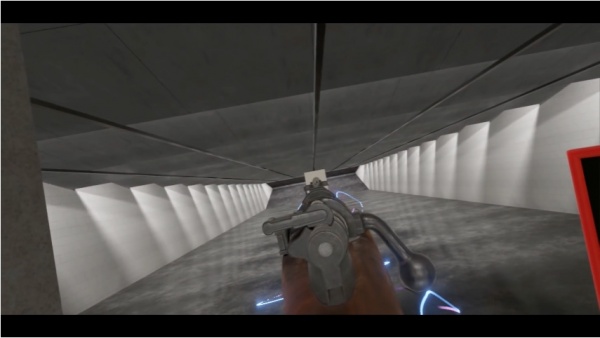
...and remembering to turn off the safety. The color of the target is conspiring with the picture's resolution to make the front sight hood virtually invisible.
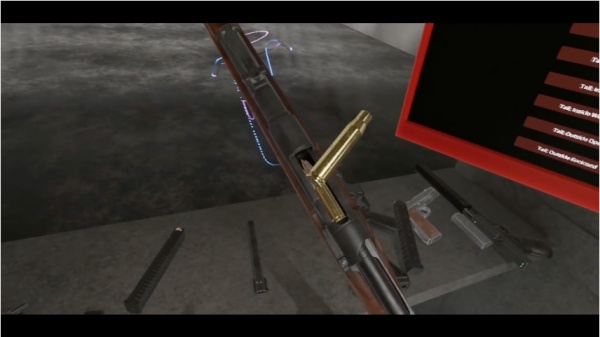
Ejecting a spent case. One down, 4 more to go.
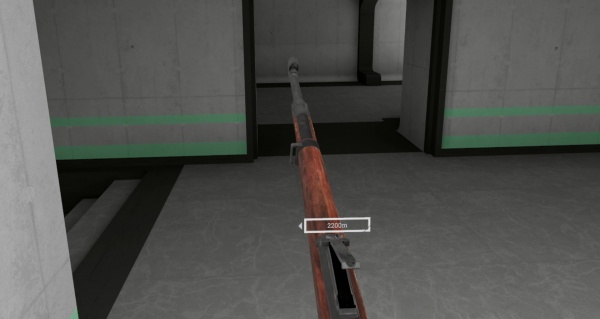
The Mauser was one of several guns that got an adjustable rear sight in Update #94, which goes out to 2,200 meters in 100-meter increments. Extremely helpful for the notoriously long-ranged engagements of the original Take & Hold map.
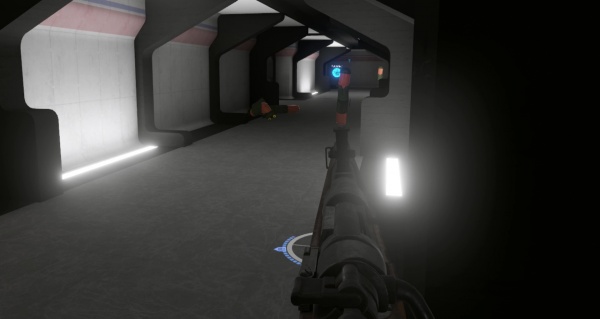
Should you wish to actually hit something at a shorter range with the sights set like this, you're going to need a rather substantial 6 o'clock hold, and a fair bit of luck.

Mauser Karabiner 98k with Zeiss ZF42 scope - 7.92x57mm Mauser
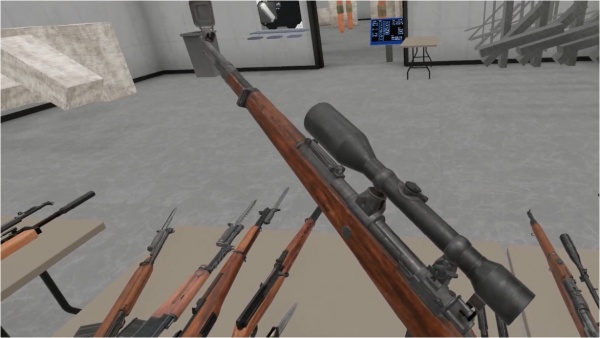
Update #76's 1st alpha build added a scope for the Karabiner (specifically, a Zeiss ZF42), another long-awaited addition.
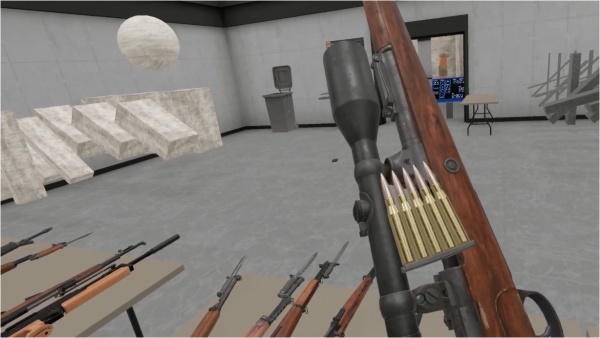
Unfortunately, the centerline placement of the scope makes the use of stripper clips all but entirely impossible; as seen here, they don't physically fit between the scope tube and the receiver.
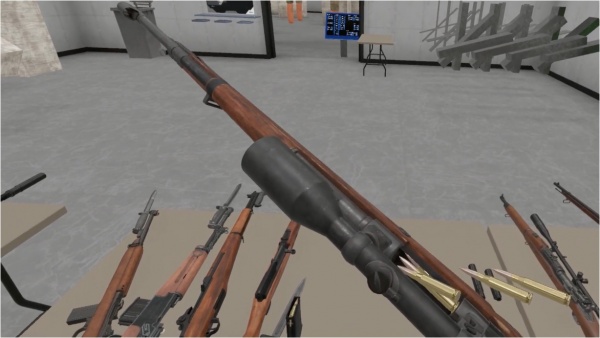
As such, the only way to load the scoped 98k is one round at a time.
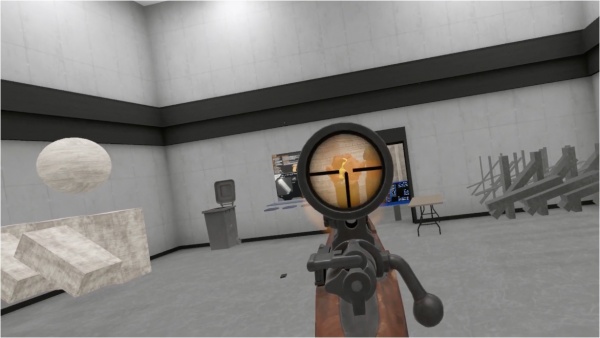
Plugging a Sosig in the noggin; this shows off the scope's 3-line reticle, common for scopes of the era. Note the hole in the scope mount; this allows the iron sights to be used with a scope mounted (though the resultant sight picture is somewhat cramped, as one might expect).
Mauser M1917 Trench Carbine/Mauser C96 Carbine Hybrid
The last of Update #52's C96 variants is a rare M1917 Trench Carbine, a variant developed (but not issued) during World War 1 for German sturmtruppen. The weapon in-game is hybidized with attributes of a slab-sided Mauser C96 Carbine listed on iCollector in 2011; the in-game weapon is chambered in 7.63x25mm Mauser rather than the correct 9x19mm Parabellum, has a slab-sided receiver, a standard C96 trigger, and a standard C96 slide. The in-game weapon also has a greatly extended barrel, which is seen on some C96 Carbines (though not the slab-sided one).
It seems likely that the weapon model was originally a C96 Carbine model modeled after the 2011 slab-sided C96 Carbine, before being modified and repurposed to have M1917 Trench Carbine traits.
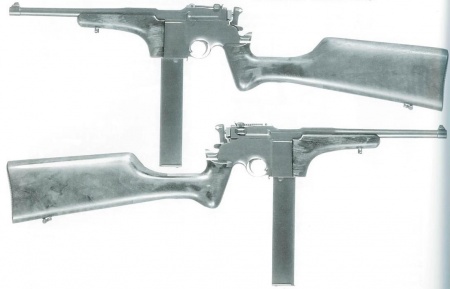
Mauser M1917 Trench Carbine - 9x19mm Parabellum

Mauser C96 Carbine (slab-sided) - 7.63x25mm Mauser. For reference.

Mauser C96 Carbine - 7.63x25mm Mauser. Reference for the long barrel.
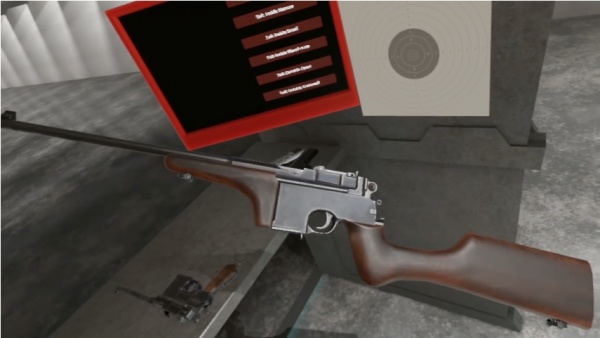
Examining the Trench Carbine. Note the hybrid traits from the M1917 Trench Carbine and the C96 Carbine. Its grip-stock is mounted in a slightly different way compared to the M1917 Trench Carbine reference image, but some of the Trench Carbines have their grips mounted like that.
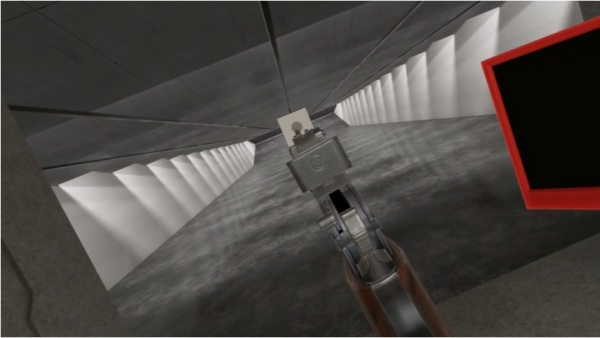
Taking aim at a bullseye through the M1917's iron sights.
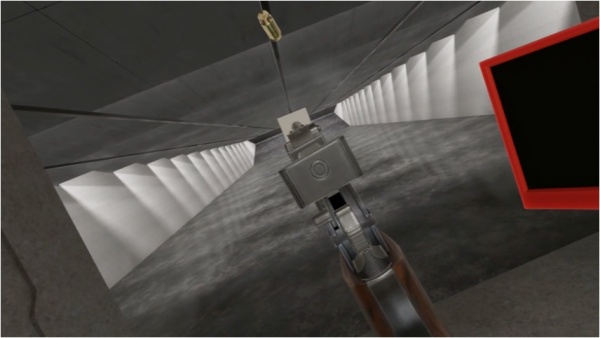
Firing a shot; as one would expect from a pistol-caliber carbine, this doesn't produce much recoil.
Mosin-Nagant M1891
The first alpha build of Update #76 brough along some new Mosin-Nagant variants, one of which being an original M1891 long rifle.

Mosin-Nagant M1891 - 7.62x54mmR
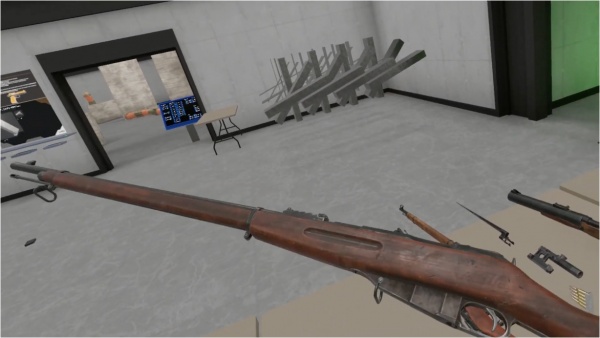
Admiring the M1891 Mosin. It's in somewhat rough shape, sure, but what can you expect out of a rifle that's lasted well over a century?
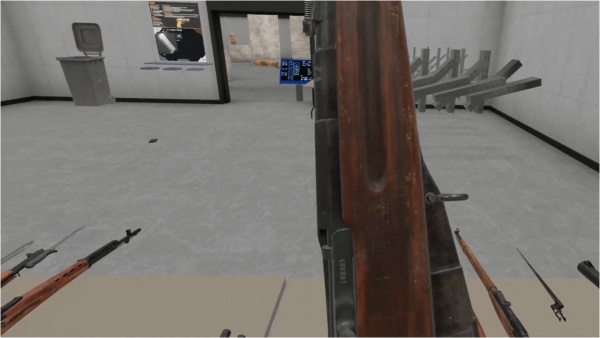
A close-up of the rifle's other side; here, the older-styled rear sight can be seen, as well as the serial number on the bolt.
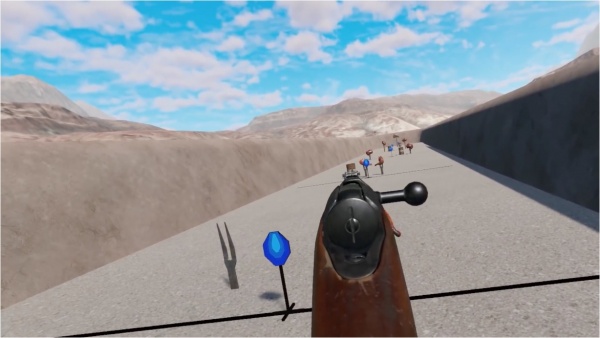
Aiming down the aforementioned vintage sights, while punching some holes in the Sampler Platter's "Hot Bar" area.
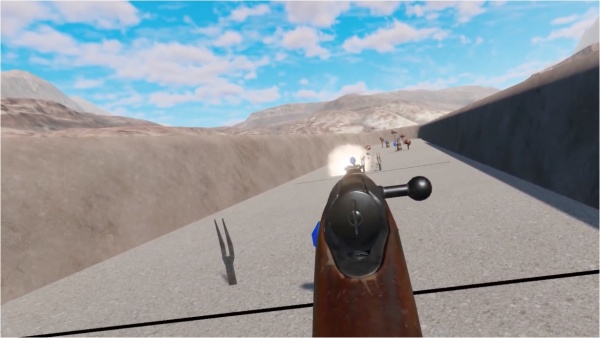
A rather apt name, considering the nature of the targets present.
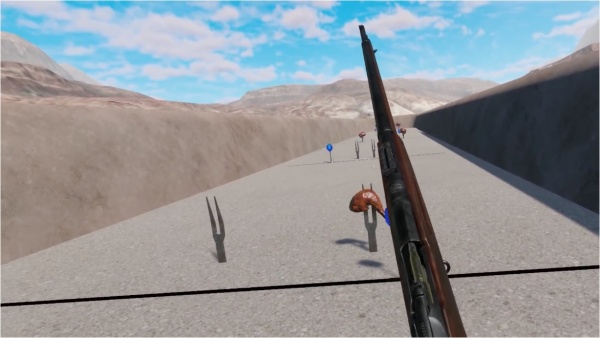
...and slamming a fresh round into battery.

Update #94 added a couple of new features to the Mosins; for starters, they all got a safety (which consists of pulling the uncocked striker back and twisting it, preventing it from going forward).

On top of that, they got adjustable rear sights; interestingly, the M91's rear sight is (correctly) graduated not in meters, but in arshins, an obsolete Russian unit measuring exactly 28 inches. If you want to do any long-range work with this gun, you're probably going to want to bring a calculator.
Mosin-Nagant M38 Carbine
First seen in the Alpha 1 build of Update #52, the Mosin-Nagant M38 Carbine is available for use in H3; like the later-added Lee-Enfields, it is categorized as a bolt-action rifle, not a carbine. Amusingly enough, it is found near the trashcans in the Friendly45 scene, referencing one of the Mosin's unflattering nicknames, The Garbage Rod.

Mosin-Nagant M38 Carbine - 7.62x54mmR

Opening a loot crate in Take & Hold mode reveals a Mosin, and a 5-round stripper clip. With the exception of some bugged instances, weapons in Take & Hold generally spawn with some form of appropriate ammunition. Granted, "appropriate" ammunition does include things such as 5-round magazines for assault rifles, and shotguns with confetti-filled shells.
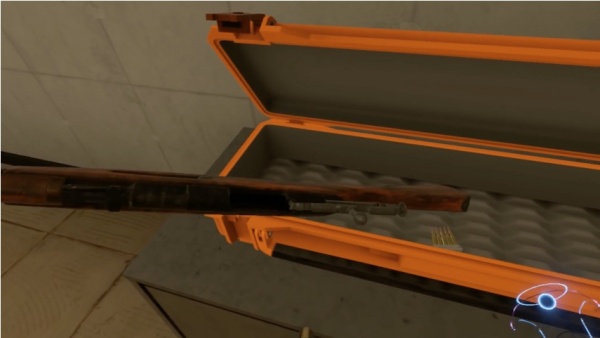
Opening the Mosin's action.
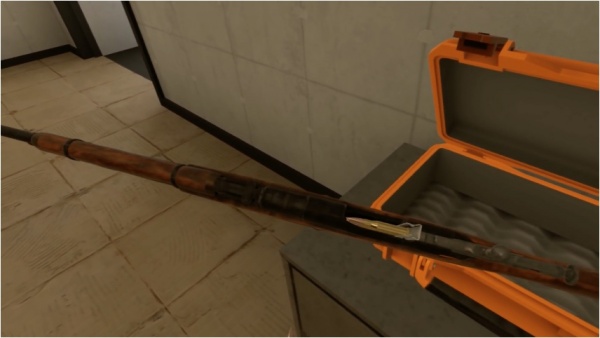
Loading the rifle up with 7.62x54mmR rounds, with the aid of the aforementioned stripper clip.
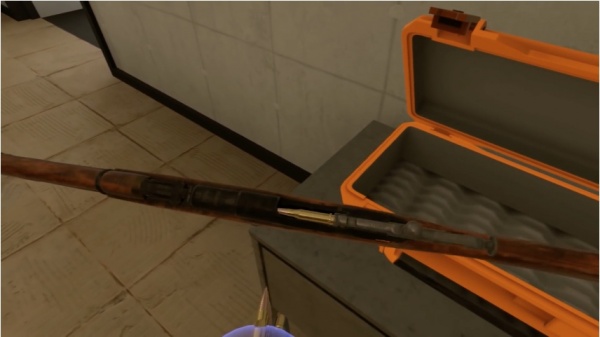
Chambering the first of the rifle's 5 rounds, and heading off to battle.
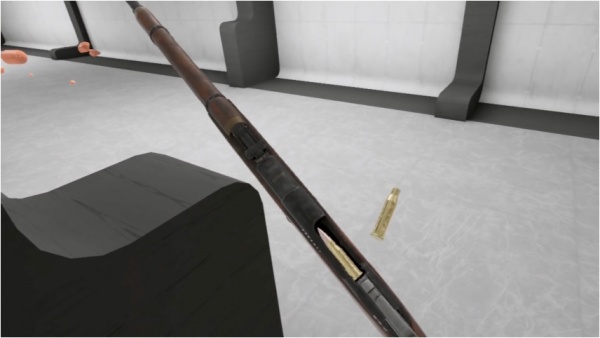
The threat to the motherland dealt with appropriately, our invisible Red Army soldier (or possibly /k/ommando) cycles his rifle, and ejects a spent casing.
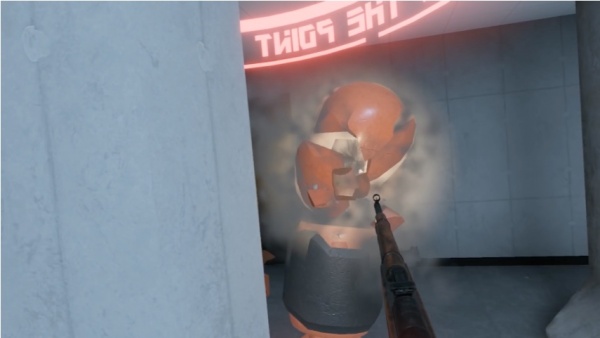
Following the discovery that Weinerbots don't terribly like it when you try to take their points, our protagonist finds himself face-to-face with a bot that clearly doesn't understand the meaning of the phrase "personal space", and decides to teach him a copper-jacketed lesson.
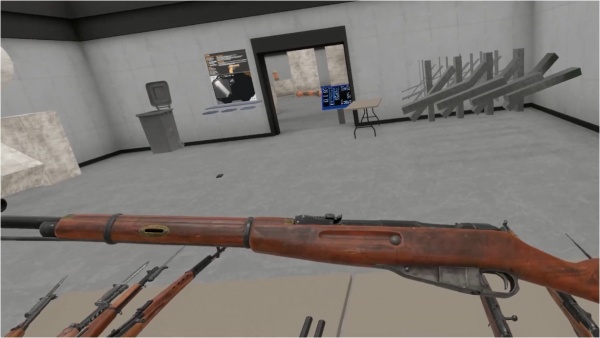
On a different note, Update #76's 1st alpha build gave the M38 a new, somewhat more worn-looking texture, complete with some rather nice (and appropriate) brass fittings.

The M38's post-Update #94 safety position. Note the firing pin, which appears to be either brass-coated or simply covered in leftover Cosmoline.
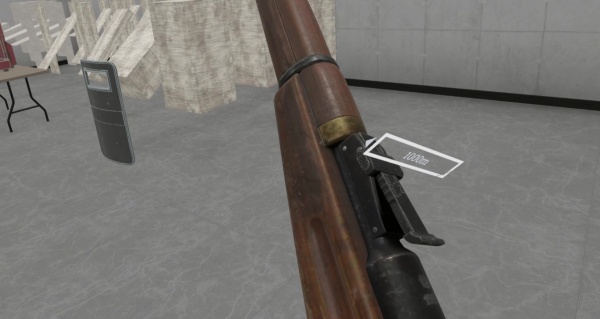
And, courtesy of the same update, its adjustable sights; these go out to a kilometer in 100-meter increments, with a 100-meter base zero.
Mosin-Nagant M91/30
The other Mosin variant added in Update #76's first alpha build was a Mosin-Nagant M91/30 configured as a sniper rifle, with a downturned bolt handle and a side-mounted dovetail rail for an also-added PU scope.

Mosin-Nagant M91/30 with PU scope - 7.62x54mmR

Examining the Mosin's left side, running an imaginary hand over the cutout in the stock in which the scope rail resides.
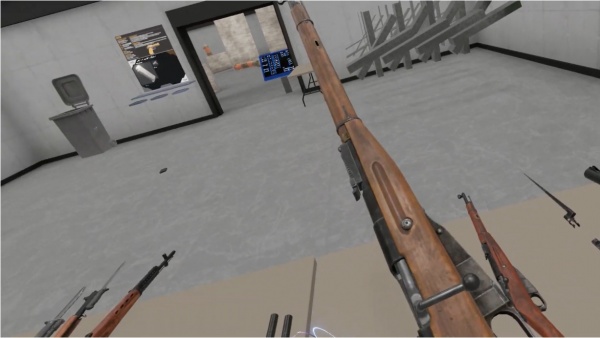
The right side, which shows off the downturned bolt handle.
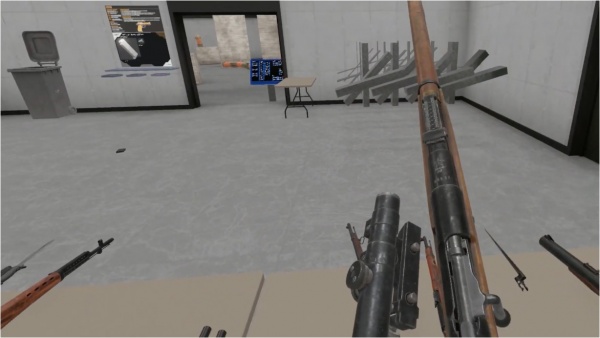
This is necessary, as when the scope is attached...
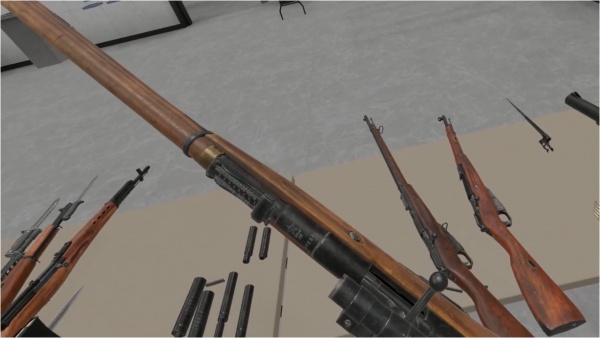
...a straight bolt handle would run into it before it could open all the way.
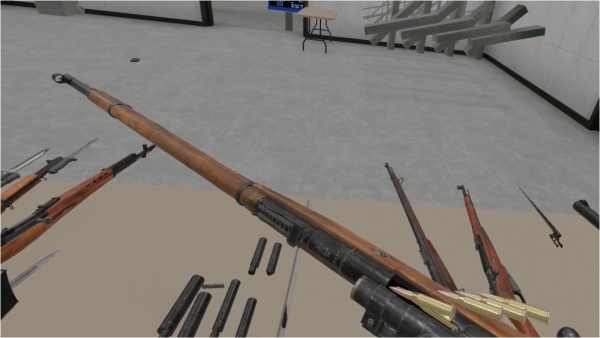
Likewise (and like most of the other scopes for this period's rifles), the scope blocks the stripper clip guide, making round-by-round reloads the way to go.
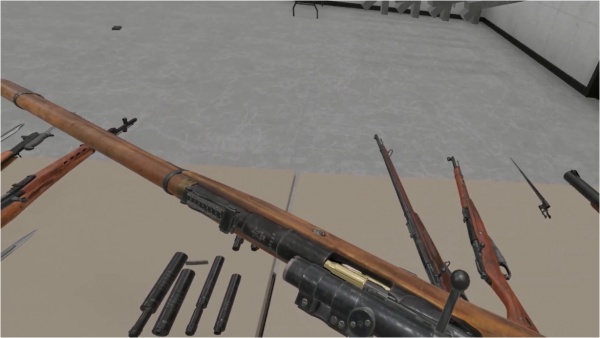
Closing the bolt, and sliding a round into the chamber.

Drawing a bead on a Sosig's head with the 3.5x PU; the high position of the scope allows the irons to be used as well.
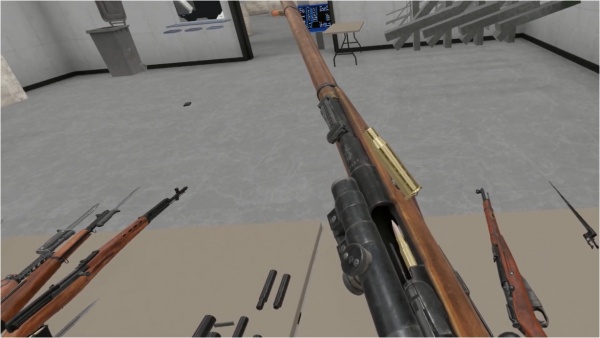
The enemy at the doorway defeated, our sniper cycles his rifle. Or is it "our" rifle?
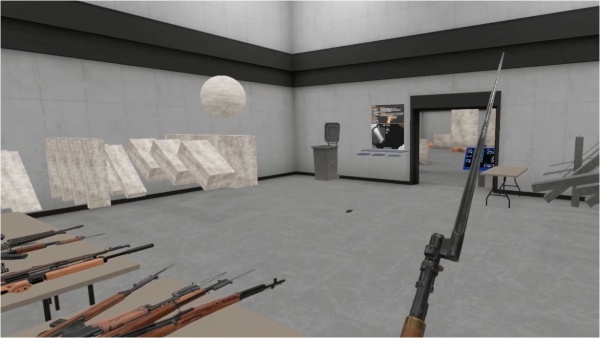
If long-range combat isn't your thing, the M91/30 can also accept the standard Mosin bayonet (as can anything that takes muzzle attachments), for maximum
"URAAAAAAAAAAA"-ing.
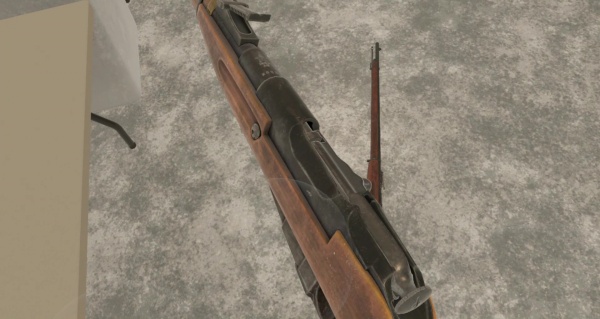
The M91/30, like the other Mosins, got a safety position for the striker in Update #94; unlike the others', the M91/30's safety position is bugged, in that the striker simply rotates without moving back, causing it to clip into the receiver.
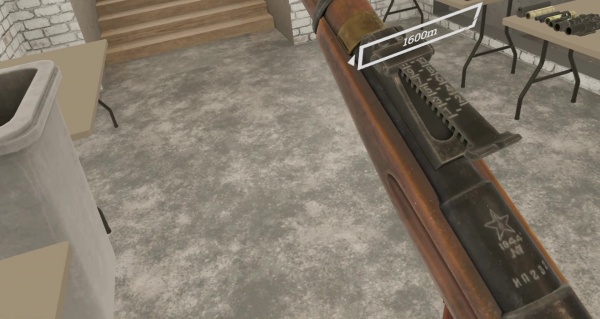
On the plus side, the rear sight is graduated in a unit that actually still exists. Also note the receiver markings; apparently, this rifle was made at the Tula arsenal in 1944.
Mosin Mini
Added in Update #95, the Mosin Mini is a version of the Mosin M91/30 chambered in .22 LR. It is the first bolt-action firearm chambered in .22LR. The Mosin Mini is one of the three "Cursed Guns" from the update that is based on a real-world firearm; its not uncommon for militaries to provide .22LR versions of service rifles for training purposes, though this particular rifle was made for the sporting market.

KSA 91/30 Mini Mosin - .22 LR
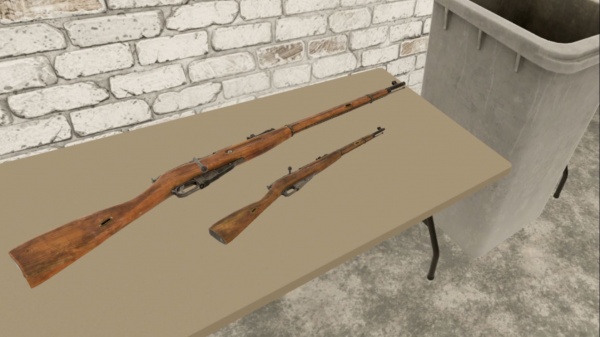
In case you wanted to know just how "Mini" the Mini Mosin is, its half the size of a normal M91/30.
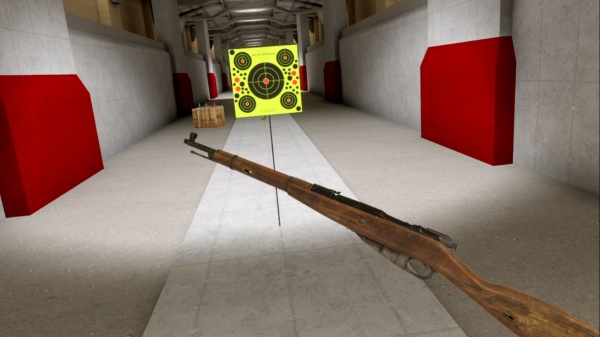
The left side of the Mosin Mini is identical to the Mosin Rifle.
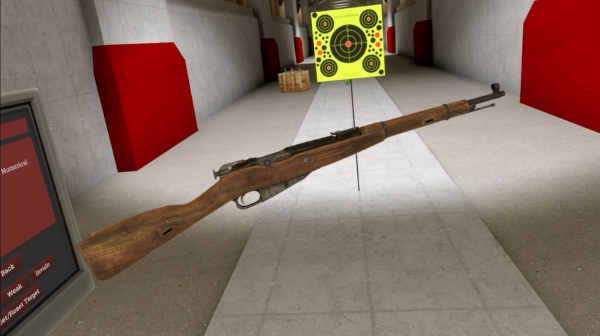
Ditto for the right side, though it uses the normal style bolt handle as opposed to the sniper style handle seen on the in-game M91/30.
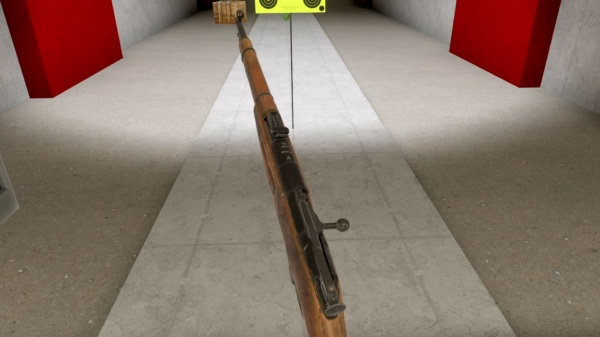
Like all Mosin rifles, the safety is a knob located on the back of the bolt, and is disengaged by pushing it in.
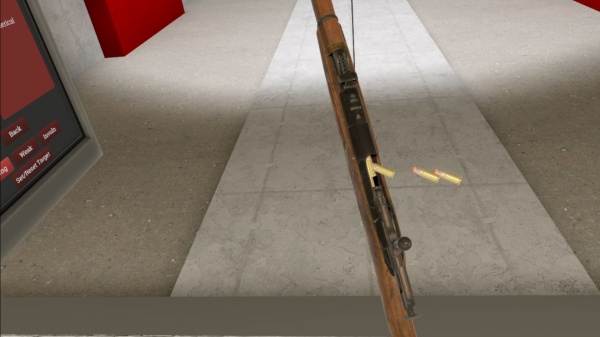
Since there are no .22LR stripper clips (yet), the tiny cartridges are inserted one at a time.
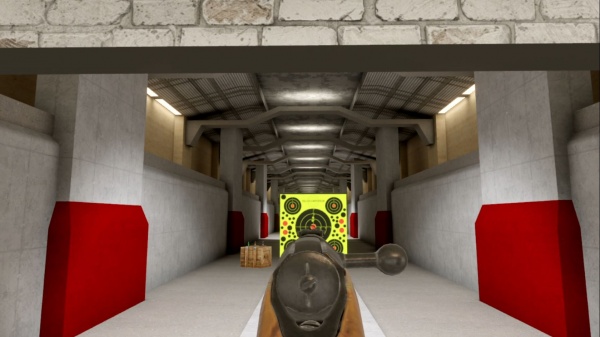
Standard sight picture for a very non-standard mosin.
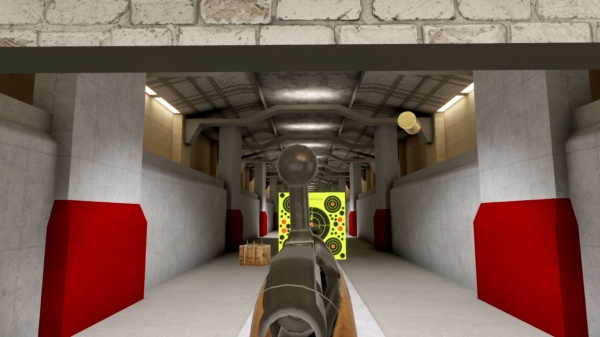
With virtually no recoil, its easy to fire all five rounds in quick succession with the help of quick-bolting.
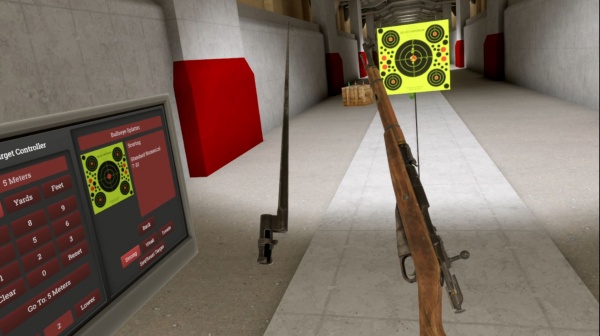
While the Mosin Scope can't be mounted on the Mosin Mini, the Mosin Bayonet can be. And as you can see, its almost half the length of the gun.

Even with the bayonet affixed, the Mosin Mini is still shorter than the M91/30.
Mosin-Nagant "Obrez"
Update #52's twelfth alpha brought along a sawn-off version of the Mosin, a configuration commonly referred to as an "Obrez" (Russian for "cut"). The entire stock is removed, and replaced with a homemade wooden pistol grip. Being a weapon meant to pad insufficient supplies of proper pistols among various underground groups, the Obrez is classified as one in-game.
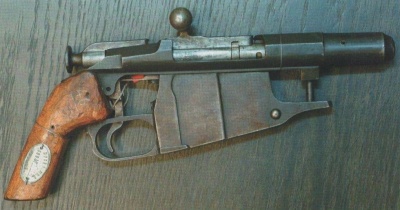
Mosin-Nagant "Obrez" with Pistol Grip - 7.62x54mmR
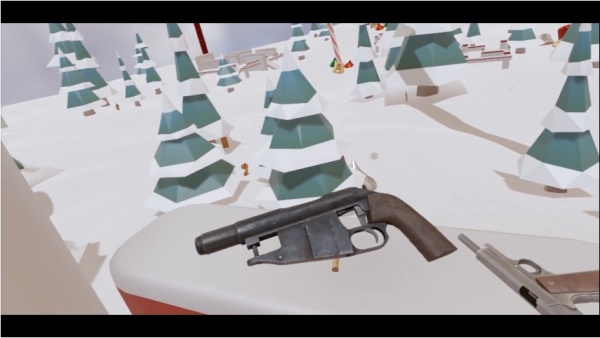
Well, it might be snowy, but at least it's not Stalingrad.
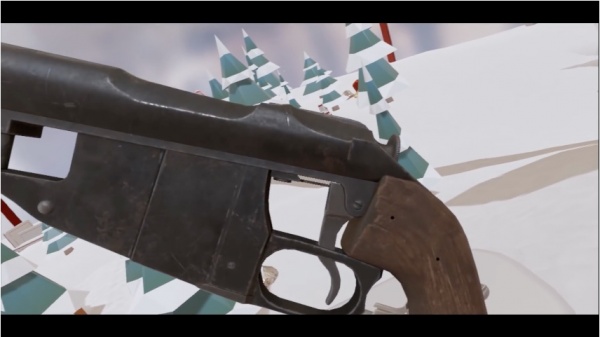
The absence of a stock shows off something interesting about the in-game Obrez:
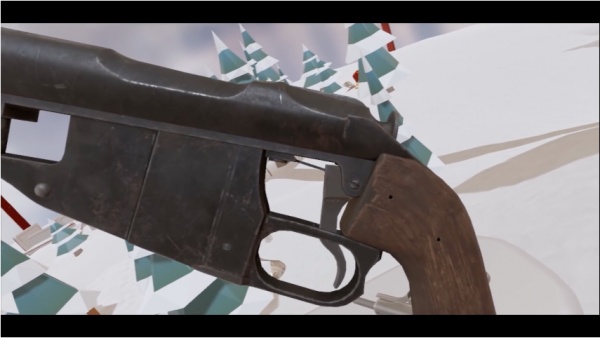
The trigger group is fully-functional, and all its parts move when the trigger is pulled.

Opening up the truncated Mosin's action...
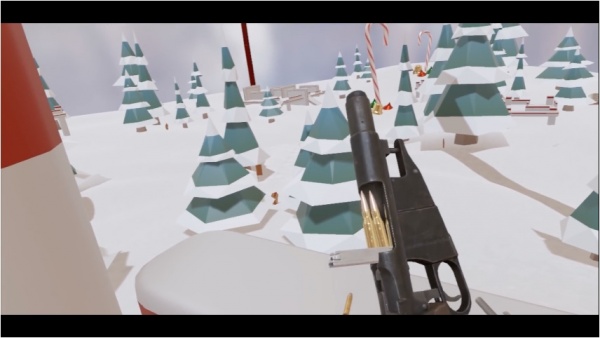
...loading in a 5-round stripper clip...
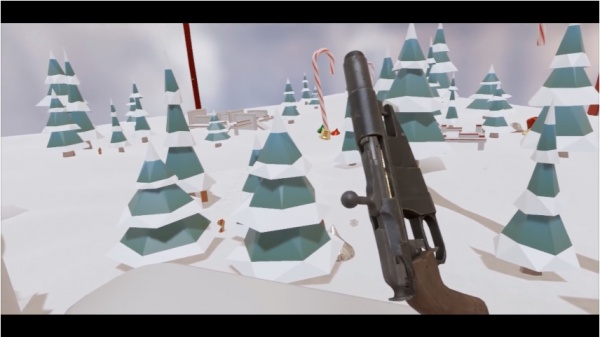
...and sending the 1st of those rounds into the chamber, which constitutes more or less the entire barrel at this point.
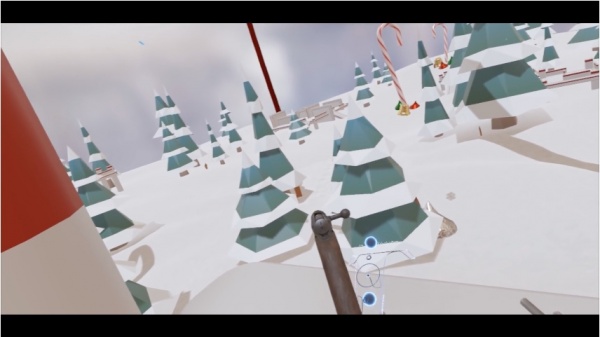
"Aiming"; of course, considering the fact that both the front and rear sights are mounted on the now-near-nonexistent barrel, this is more a formality than anything else.
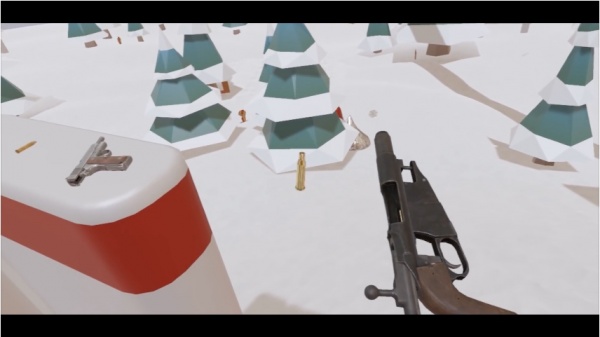
Ejecting a spent casing from the Obrez.
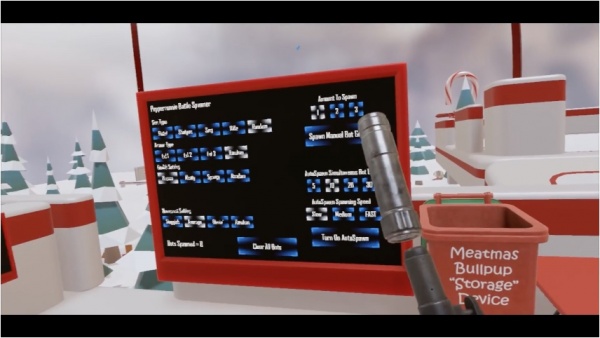
...and a little bit of that...
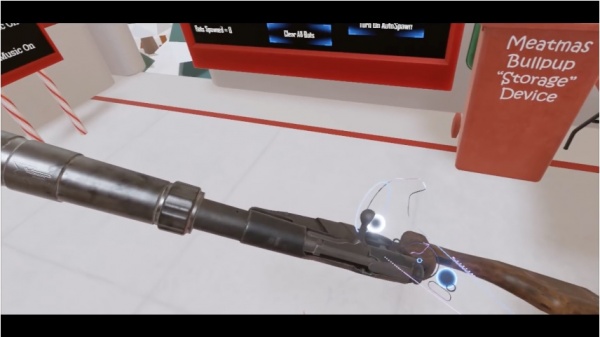
When Lovecraft spoke of something so innately wrong that it could drive men to insanity just by looking at it, one has to wonder if this is what he was referring to.
Quackenbush 1886
Update #56, AKA the 2018 4th of July Update, included an 1886 Quackenbush "Bicycle Pump" single-shot .22 carbine. Along with the Ruger 10/22 below, the Quackenbush marked the first addition of a firearm chambered in .22 Long Rifle since the addition of the Ruger Mk III back in Update #5.

Quackenbush 1886 "Bicycle Pump" rifle - .22 LR
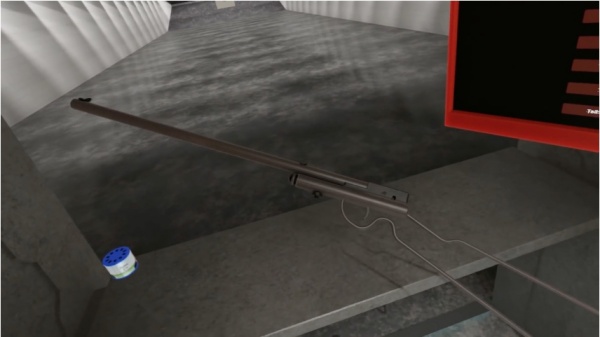
The Quackenbush. Yes, that's its real name.
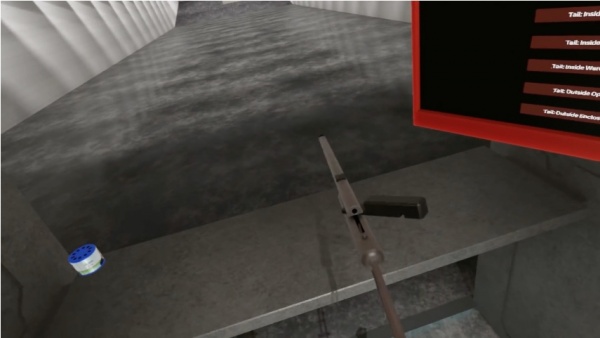
Opening up the Quackenbush's side-pivoting breechblock.
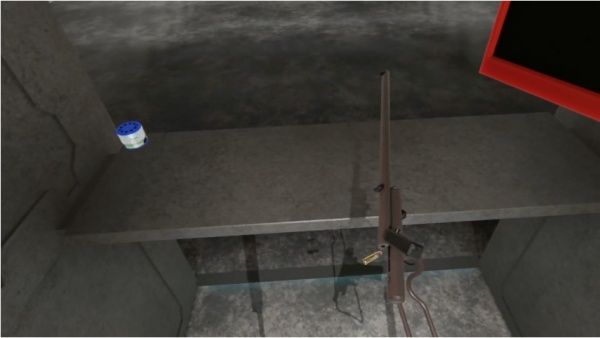
Loading in a .22 Long Rifle round; the red tip pegs it as a tracer.
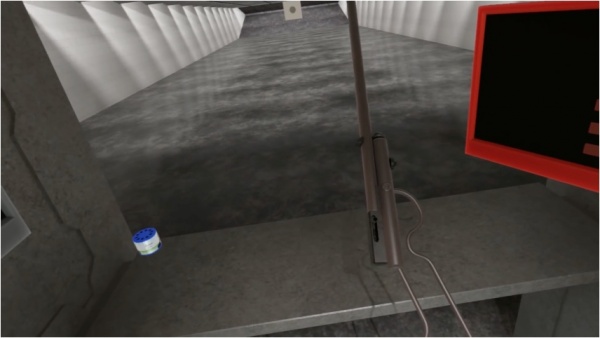
Flipping over the now-closed Quackenbush...
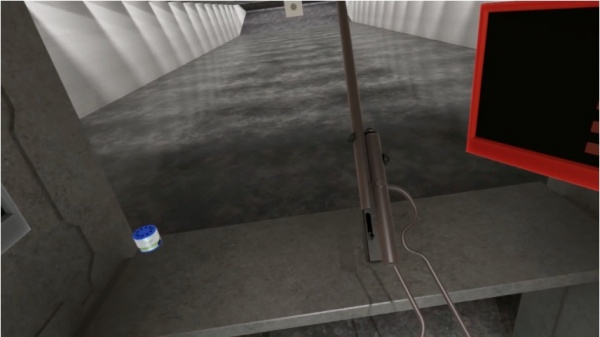
...and cocking the striker.
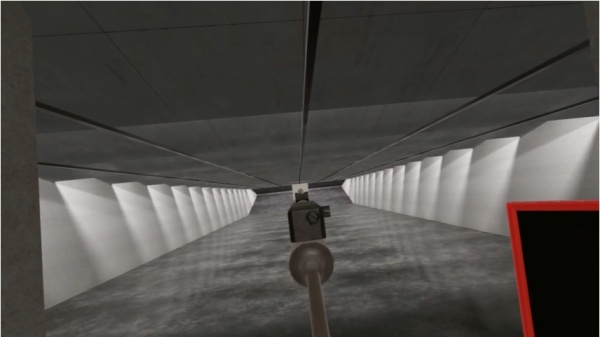
Lining up the simple notch-and-blade sights of the Quackenbush. That's just fun to say. Quackenbush, Quackenbush, Quackenbush...
Remington Rolling Block
Update #91 added two variants of the Remington Rolling Block; the first is a standard-pattern commercial carbine chambered in 8x50mmR Lebel (the first weapon in the game to use the round), and the second is the rare No. 1 "Creedmoor" sharpshooter pattern, equipped with an aperture sight and chambered in .45-70 Government. The two rifles are the first in a new sub-category (breech-loading rifles); by and large, they're functionally identical to the earlier-added Rolling Block pistol. With Update #94, mechanical accuracy for firearms was implemented, and the Creedmoor's ladder sights could be now zeroed to multiple ranges; between this and its superior accuracy to the standard Rolling Block rifle, the Creedmoor stands out as the better option for long-range shooting.

Remington Rolling Block - .32 rimfire. Similar to the in-game rifle.
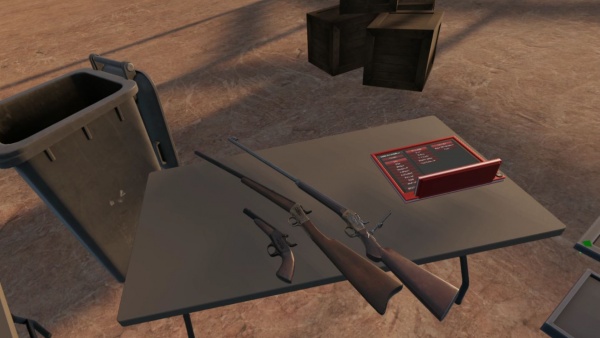
The Remington Rolling Block family - we've got mama bear, papa bear, and baby bear, all in one place.
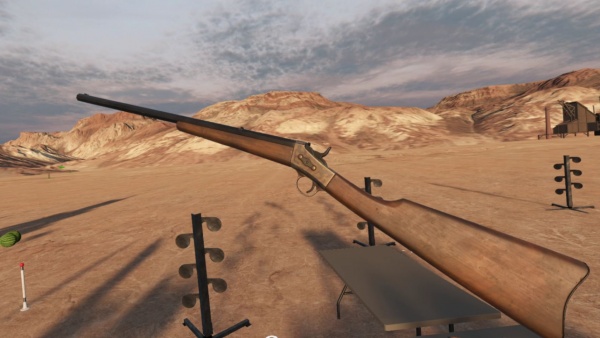
First is the standard Rolling Block rifle, which unsurprisingly, looks like a longer version of the Rolling Block pistol.
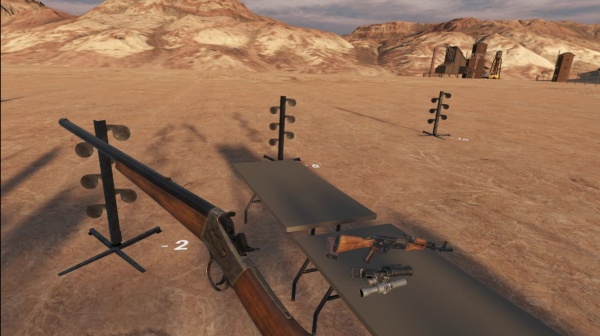
Cocking the hammer allows the breech to be accessed.
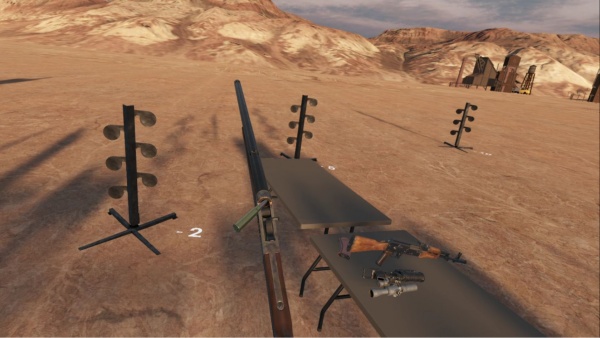
...and inserting a single 8x50mmR Lebel round.

Cartridge chambered, the breech can be closed, and the rifle is now ready to fire.
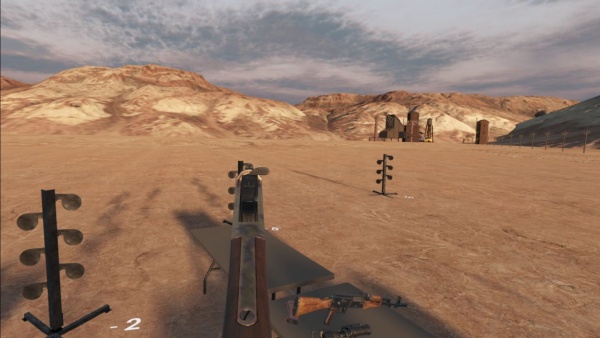
Aiming down the Rolling Block's simple sights.
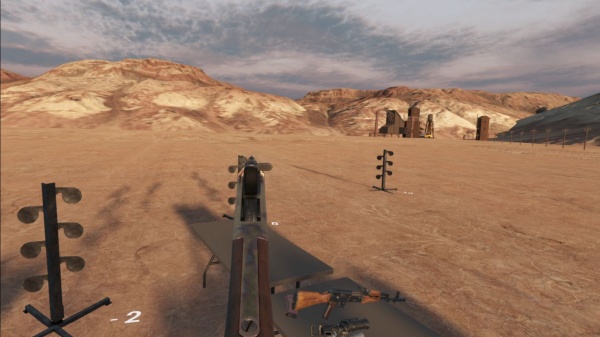
Firing the Rolling Block.
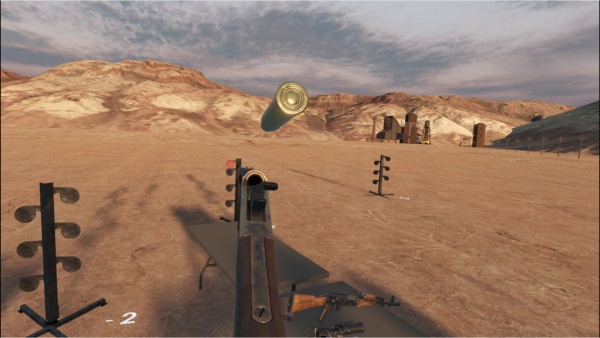
Upon opening the breech again, the poor cameraman was immediately struck by a hot brass shell. After all, there's no real point in opening the breach while still shouldered.
Remington No. 1 Rolling Block "Creedmoor"

Remington No. 1 Rolling Block "Creedmoor" - .22 rimfire
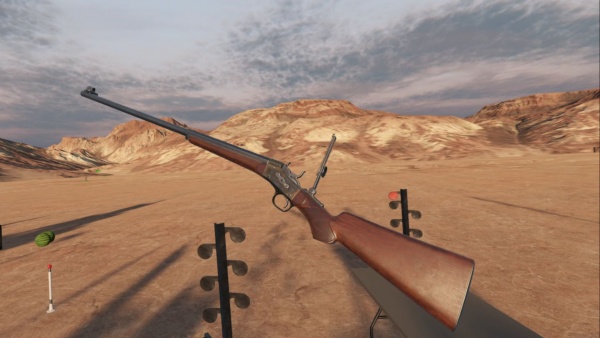
Next we have the Creedmoor, the Rolling Block's richer, fancier sibling.
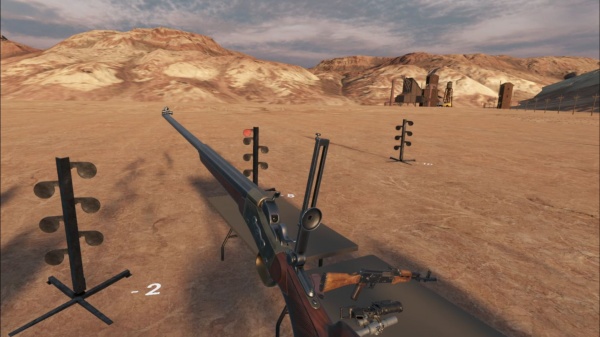
Cocking the Creedmoor's hammer.
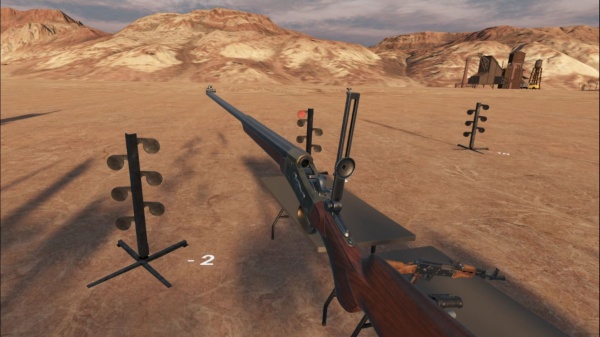
Opening the Creedmoor's breach.

This time we have a .45-70 Govt cartridge, an ideal cartridge for big-game hunting. Sadly there are no meaty safari animals to take this gun hunting with... yet.
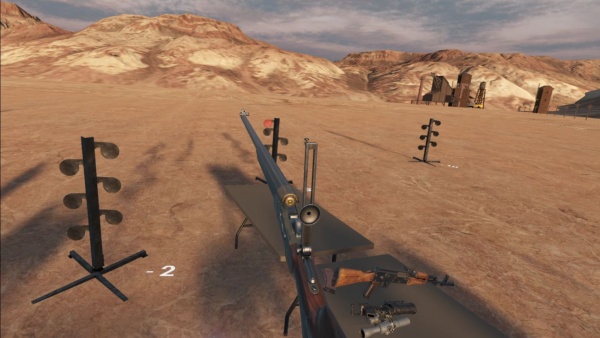
Chambered, ready to close the breach and fire.
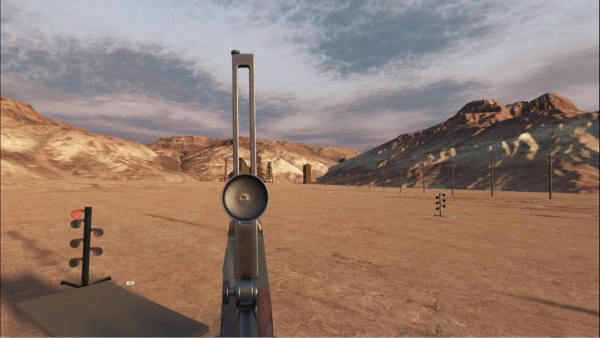
Aiming down the Creedmoor's aperture sights; the hole for the aperture is widened, as apertures do not work in VR as they do in real life due to the artificial focal plane. Instead, one has to center the front sight through the aperture to aim. Not the most accurate, but its a necessary compromise.
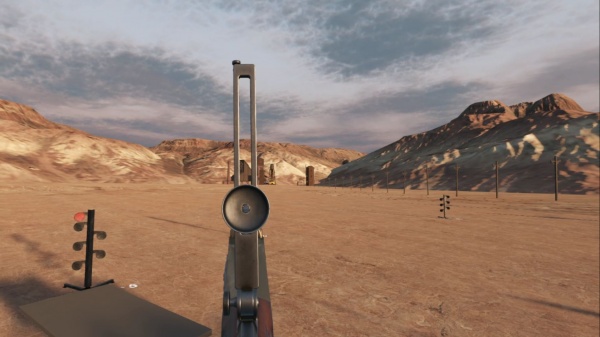
Upon firing the rifle, the sight picture is immediately obscured by the rear aperture. However, the clang of the metallic target being hit confirms the shot. Unfortunately, this doesn't come across in picture format.
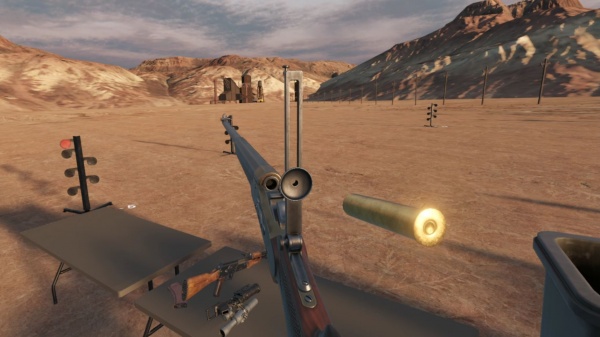
Ejecting the cartridge, this time ensuring that the cameraman's face is nowhere near the breach. Still a close call, though.
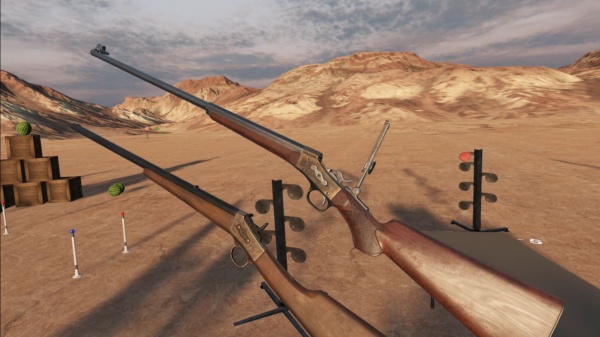
Another side-by-side comparison of the two rifles.

With the ladder sights now adjustable, the Creedmoor's default setting is at 100 meters...
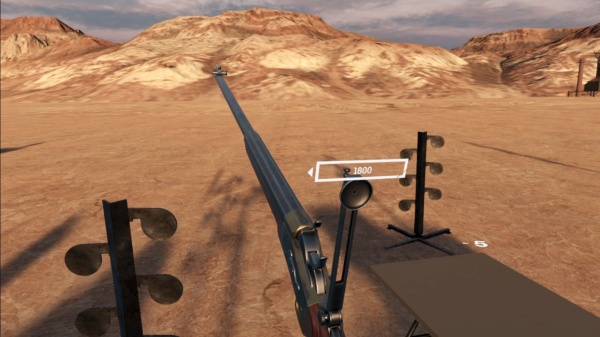
...with its maximum at 1800 meters.
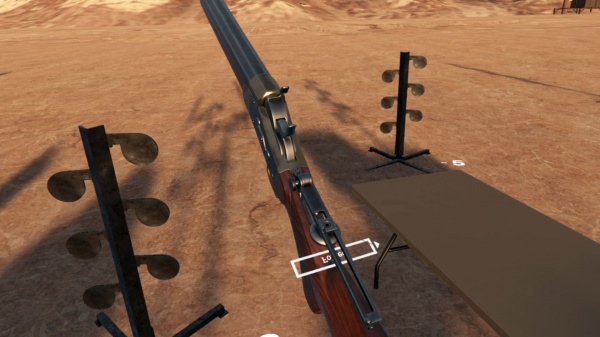
Or if you find the ladder sights too obstructive, you can opt to simply fold them out of the way. This takes away any rear sight to aim with, but assuming your target is a lot closer than 100m, its not too difficult to aim with. It also makes loading the rifle less fussy since the ladder gives you less space to work with.
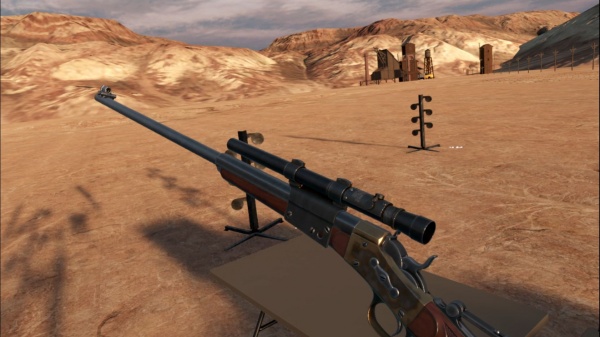
An earlier update allowed you to attach the Weaver 330 scope to both versions of the Rolling Block, as well.
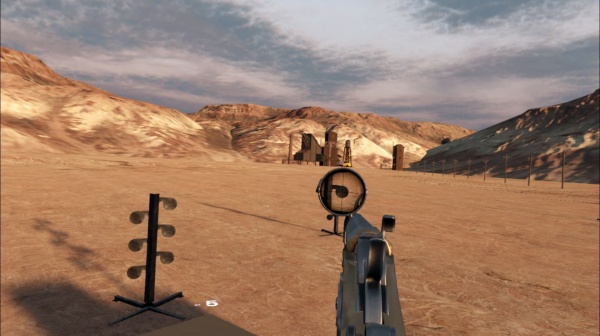
Even though the scope is offset enough that the ladder sights wouldn't interfere, having it folded down still gives you better peripheral vision.

Of course, the Weaver scope isn't the only attachment point; anything can be mounted on the muzzle, including this new wrapped suppressor.
Rossi Rio Grande
Update #75 added two variants of the Rossi Rio Grande lever-action rifle to H3, both of which are chambered in .45-70; this fulfilled a long-standing community desire for a lever-action in the cartridge. Both are known in-game as the "Rio Big-Bore", with the non-suffixed version having synthetic furniture, a receiver-mounted scope rail (a Rossi factory option), and a custom lever, while the wood-furnished "Salvaged" variant is a "Mare's Leg"-esque configuration, with an extended lever loop (another factory option), and a shortened stock, barrel, and magazine tube.

Rossi Rio Grande with extended lever loop and scope rail - .45-70 Government

Inspecting the tacticooled Rio Grande. On top of the pre-added modifications, this one's been fitted with a laser sight, a Trijicon MRO on a riser...
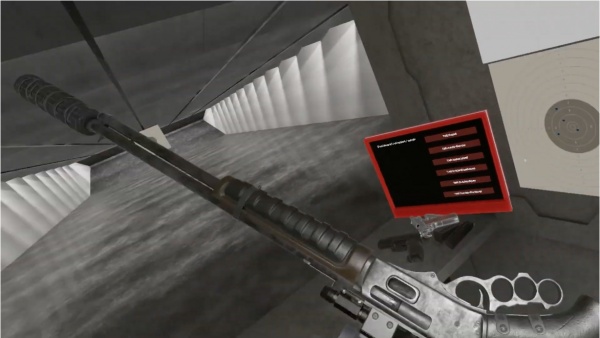
...and, as is visible here, a cloth-shrouded suppressor.
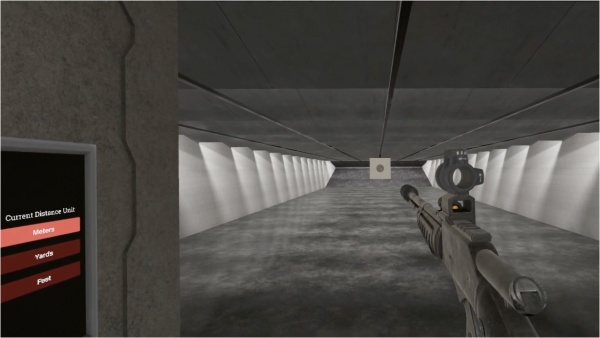
Opening up the action, while responsibly keeping the rifle pointed downrange.
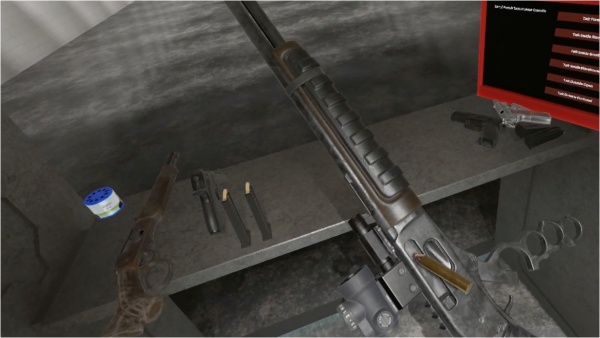
Loading a single .45-70 round into the ejection port.
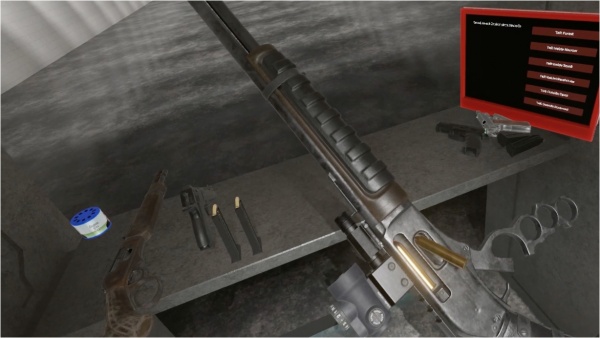
And a few more in the magazine tube.
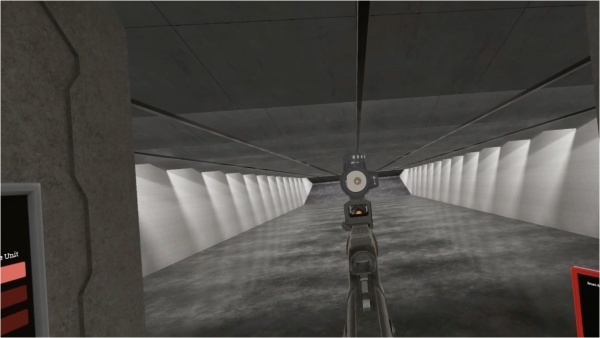
Aiming through the attached MRO.
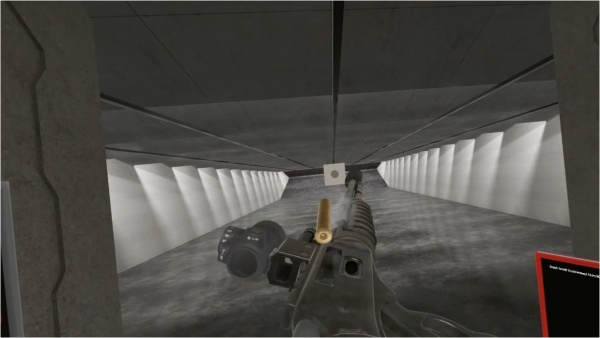
Working the action, and ejecting a spent case. As cool-looking as the brass-knuckle lever is, it's probably not all that comfortable. Especially for those with large hands.
Salvaged

The shortened variant. Looking at this image, it should be pretty obvious where it got the name "Salvaged".
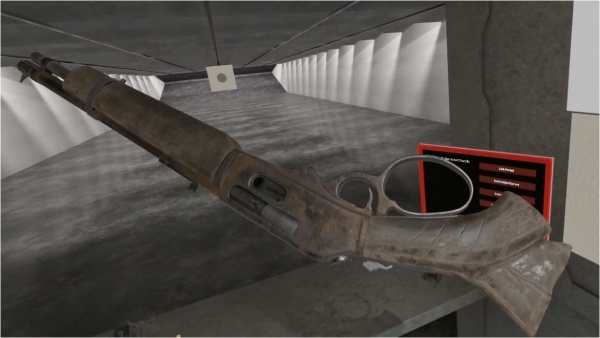
The abused rifle's other side, which shows off what seems to have been a rather poor attempt at applying stock checkering.
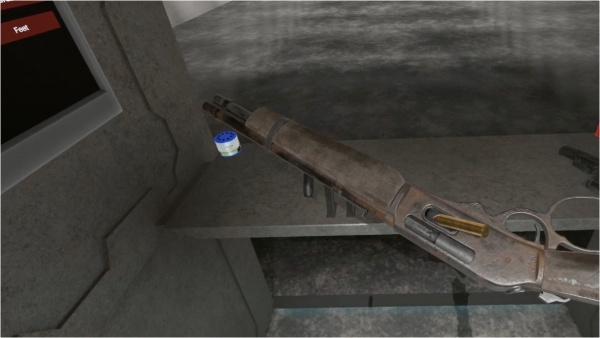
Loading a few .45-70 tracers into the Rossi's magazine tube.
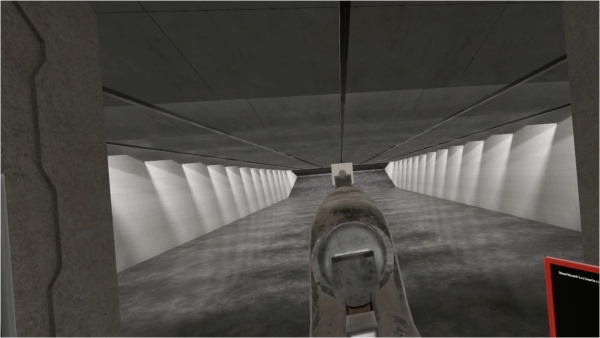
Lining up the simple notch-and-post irons...

...and letting a round fly. The next few frames consist of the wielder getting a serious case of Nosehammer Syndrome.
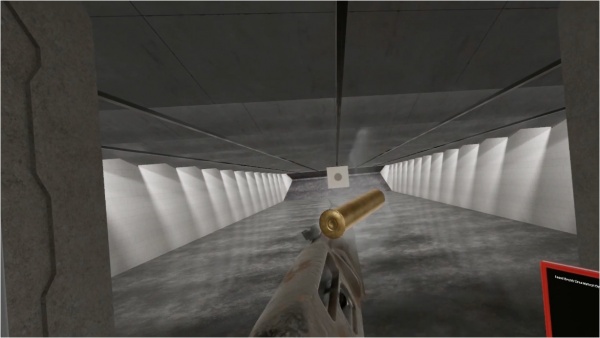
Cycling the truncated Rio.
Ruger 10/22
Update #56 (released July 4, 2018) added a synthetic-stocked Ruger 10/22 carbine. Along with the aforementioned Quackenbush, the 10/22 was the first .22 Long Rifle-chambered firearm in H3 since Update #5's Ruger Mk III.
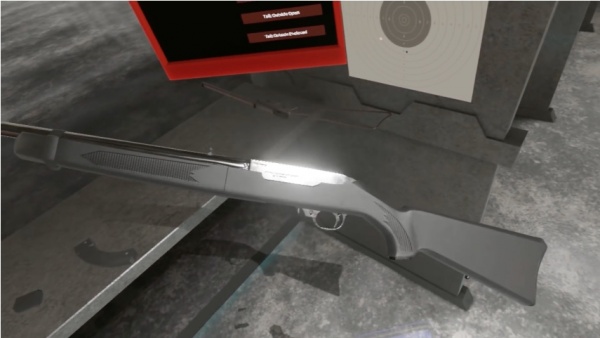
Examining the 10/22. The brightly-polished finish provides an interesting contrast with the matte black polymer stock.
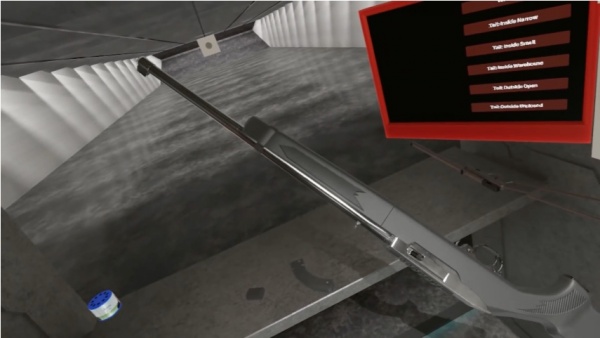
The rifle's other side. Note the line on the forestock; this denotes the rifle as a takedown (i.e. capable of being split in half for easy transport) model.
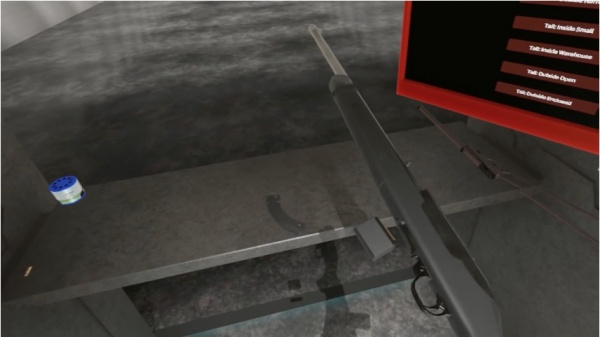
Loading in a 10-round rotary magazine.
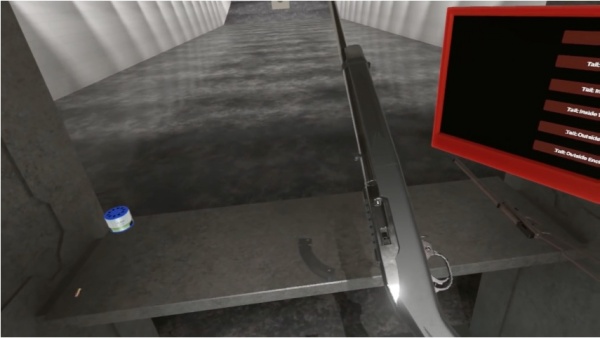
Pulling back the charging handle.
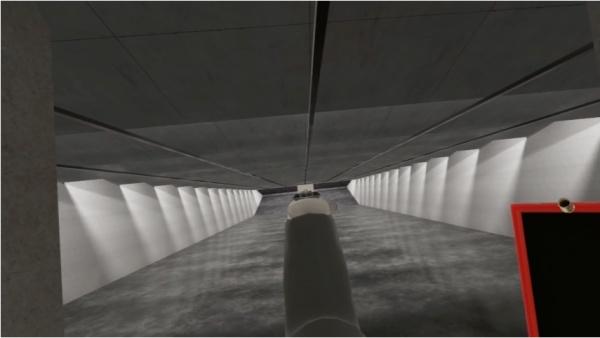
Plinking the target with a few .22 rounds.

"Sure, 10-rounders are fun and all, but I could really go for something with just a little more...
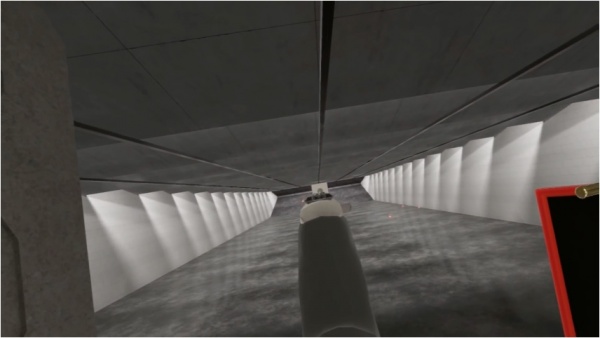
Perforating the target with the aid of 25 .22 tracers.
Sako 85
A .308 Winchester-chambered Sako 85 is one of the available firearms in-game, added in Update #13. Rounding out the update's collection of shortened firearms, Update #46 brought us an Obrez-esque sawn-off Sako, classified in-game as a bolt-action pistol.

Sako 85 Hunter - .308 Winchester
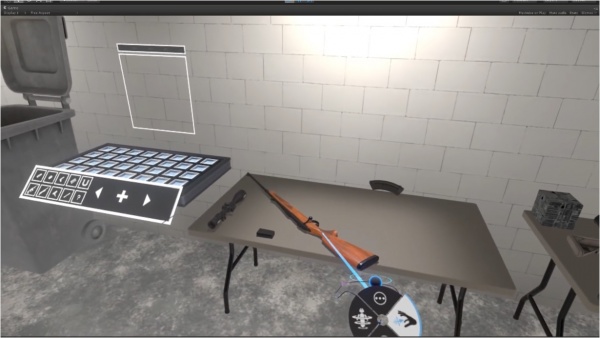
A Sako 85 sitting on a table. Considering the presence of a grab-laser, it's not likely to stay there for long.
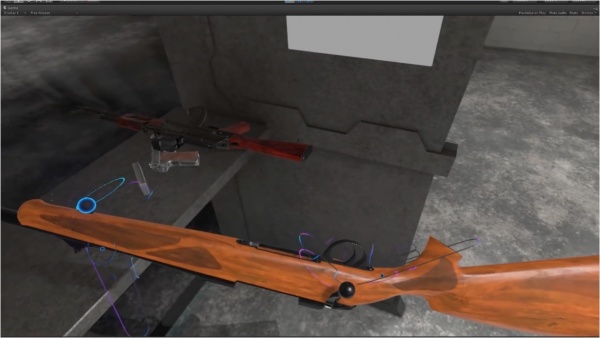
And indeed it doesn't, as evidenced by this close-up shot.
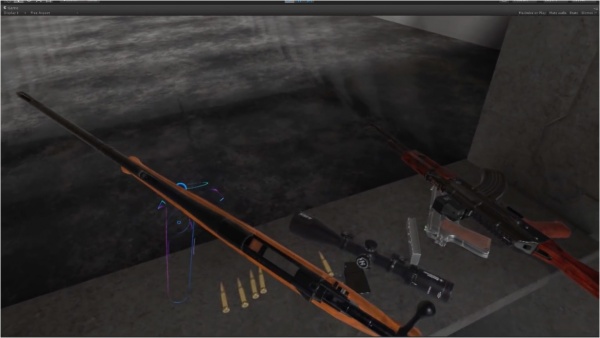
The Sako with its action open; since the magazine is detachable, removing just leaves a gaping hole underneath the bolt.
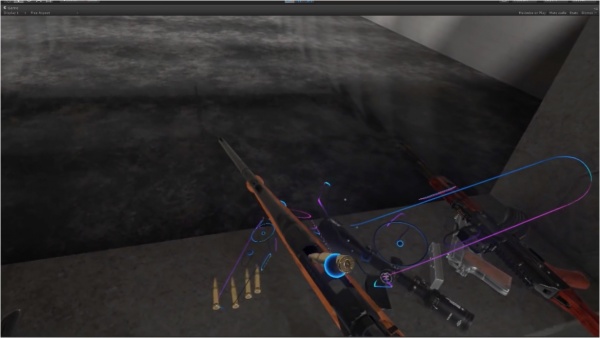
As with most of
H3's firearms, the Sako can be chamberloaded. Note that the round has a struck primer.
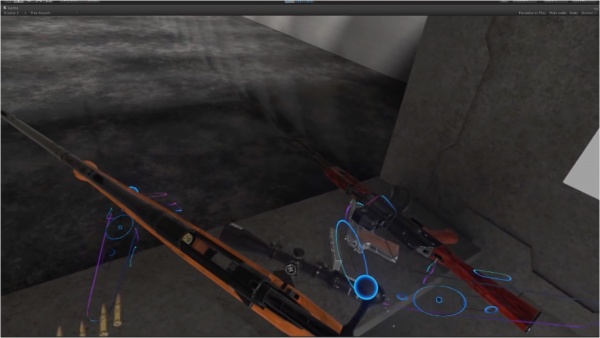
Doing so would (at the time of this screenshot) place the round into the chamber directly; Update #52 changed this to instead affix it to the bolt. Both are entirely feasible.
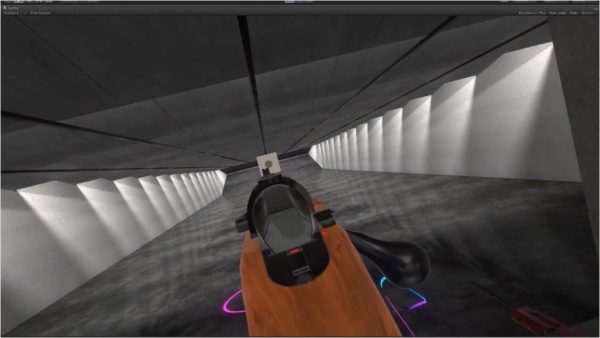
Aiming; the Sako 85's notch-and-post sights are serviceable, if a bit small.
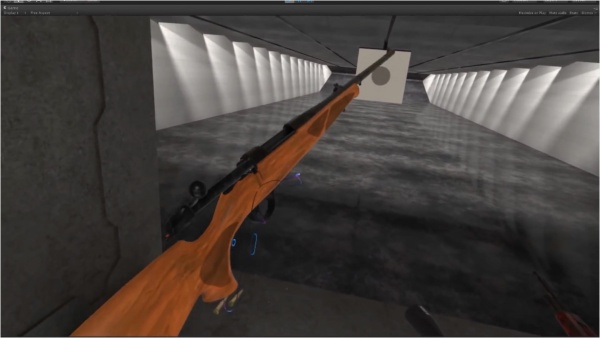
Of course, if single-loading isn't fast enough for you, there is another way...
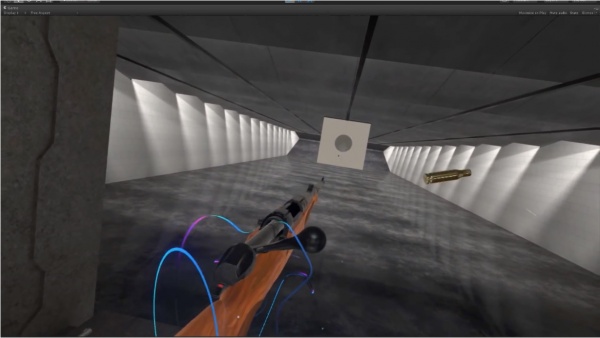
...that way being
H3VR's patent-pending Speed-Shooting Technique! Guaranteed to double your fire rate
and your group size! Order now! (Rifle sold separately).
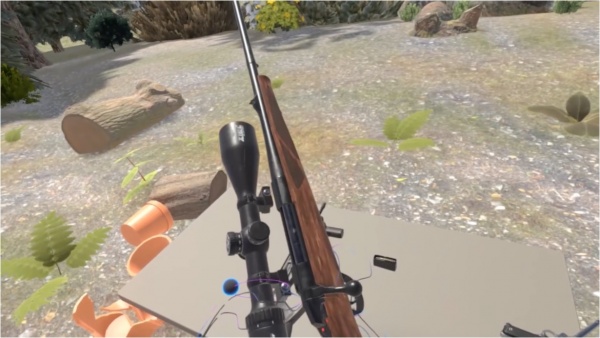
Having successfully hit the gong, Hick-not45 attaches a scope to his slightly darker Sako so he can hit that red plate over there.
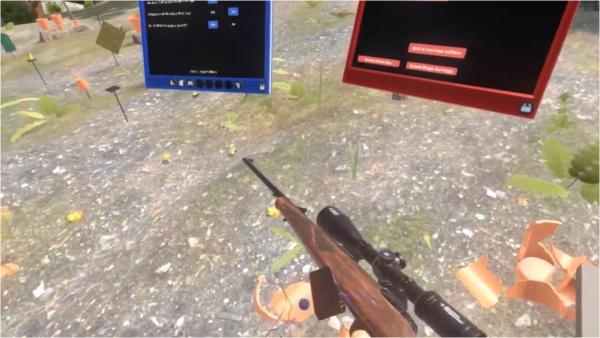
Of course, you can't hit a plate without something to hit it with.
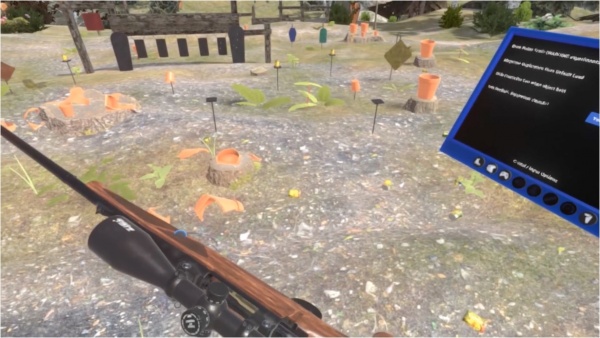
So, seeking to fix this, Hick-not45 opens up his Sako...
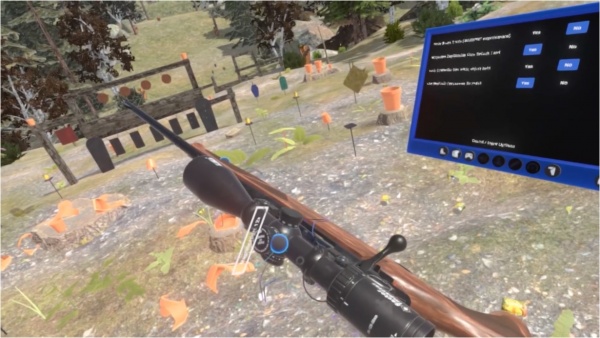
Realizing just how far away "over there" is, Hick-not45 decides to adjust his scope's magnification. This scope was introduced with the rifle; it is a 3-12x variable-power scope, supposedly made by "Ziel" (according to the markings).
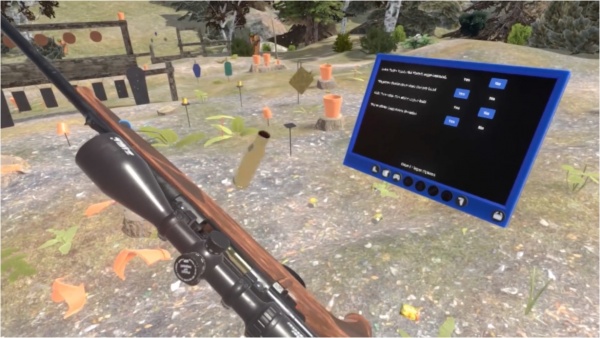
Having made his hit, Mr. 45 celebrates by ejecting a spent casing.
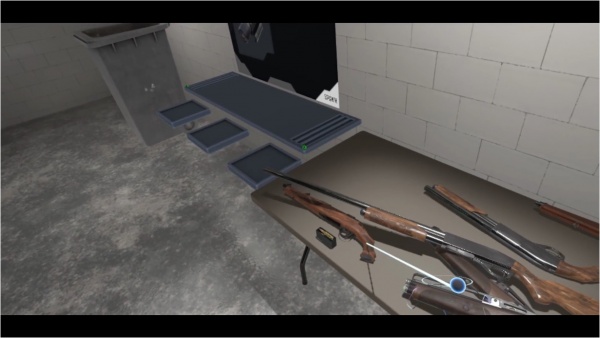
Meanwhile, back in the indoor range, something very bizarre appears to have happened to the Sako.
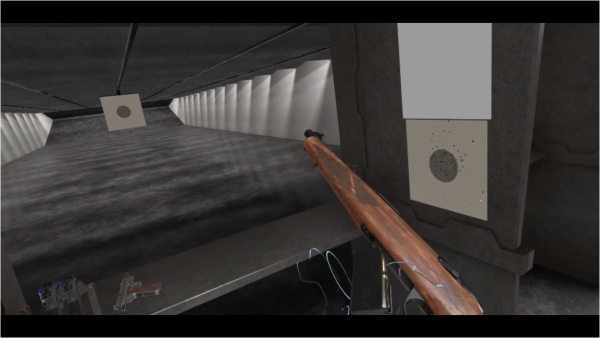
Said something seems to have been a severe curtailing of the Sako's, well... existence, really.
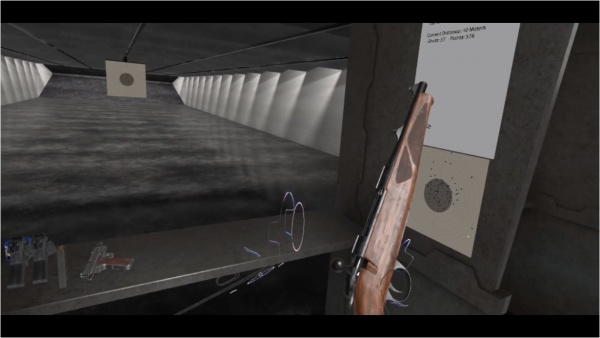
Fortunately, the action still seems intact.

And if the action's still in one piece, then the gun works.
Sharps 1874 Long Range
The Sharps 1874 Long Range was added on day 6 of the Meatmas 2020 Advent Calendar event, chambered in the proprietary .45-110 Sharps cartridge.

Sharps 1874 Long Range rifle w/ 34" barrel, Vernier peep sight, and Lyman Beach front sight - .45-70 Government
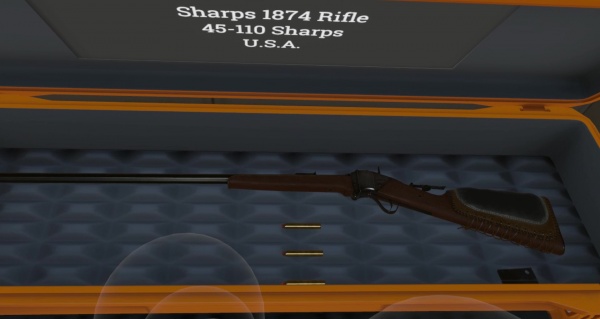
The Sharps' box. Not to be confused with an actual sharps box; this one's not full of biohazards. Probably.
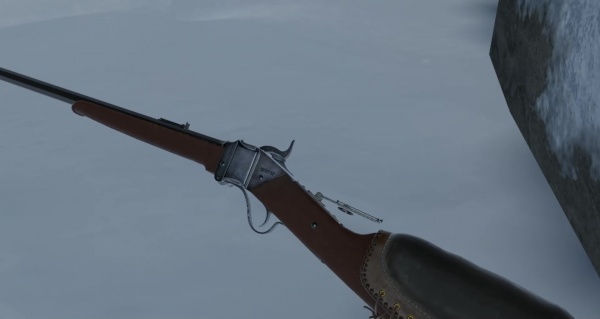
Taking a look at the rifle (or some of it at least - it's a rather difficult gun to fit on the screen); this set of shots was originally going to be just outside the bunker, but a missile-launching Swarm drone clearly didn't agree with that idea.
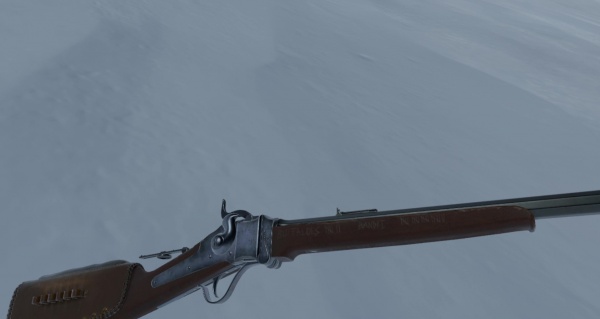
The other side; according to the tally marks scratched into the forend, the rifle's previous owner had taken seven buffaloes and twenty-two bandits with it.
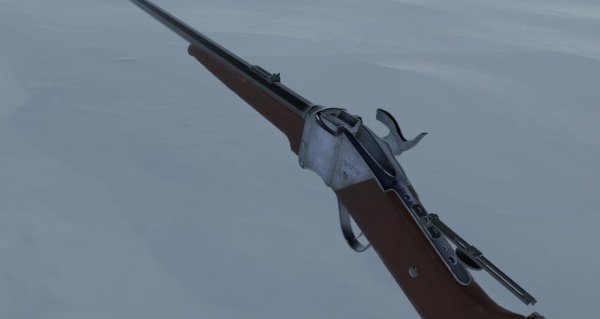
Cocking the hammer; there are some manufacturers' markings on the side of the receiver.
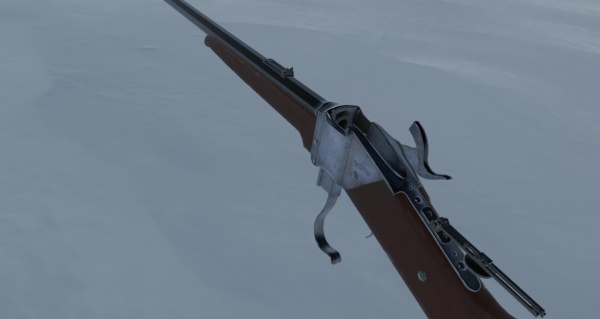
Opening up the rifle's falling-block action; this is based around a single touchpad click, constituting perhaps the strangest re-use of the
Orion Flare Gun's code to date.
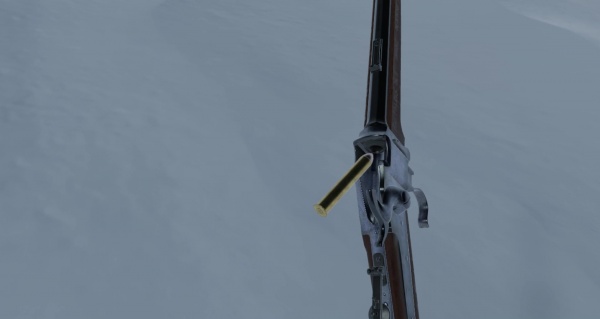
Loading in a single .45-110 Sharps cartridge - a tracer, to be exact. As a note of trivia, ".45-110" was never an official designation for the round (since the Sharps Rifle Company didn't tend to use blackpowder notation); it is instead derived from the factory loading of the .45 cal 2 7/8" Sharps round using 110 grains of black powder.
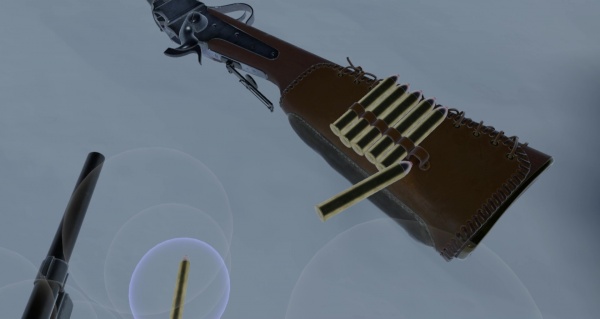
Shoving a few extra rounds into the loops on the Sharps' leather cheek rest. Notably, these rounds aren't quite lined up with each other; this is correct, as their rims would prevent them from sitting parallel side-by-side.

Trying out the notch-and-post irons on a snow-covered tree...

...before putting them to use against a Static drone; this produces far more smoke and recoil than drone fragments, unfortunately.
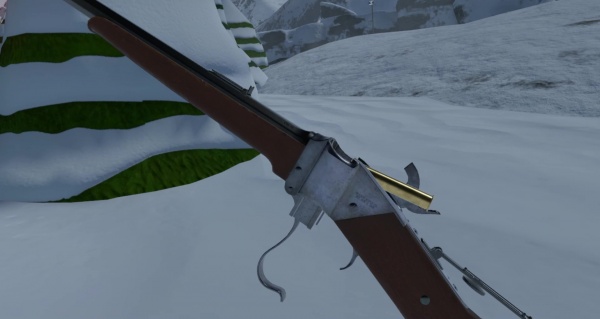
Opening the action again, and dumping out a spent case.
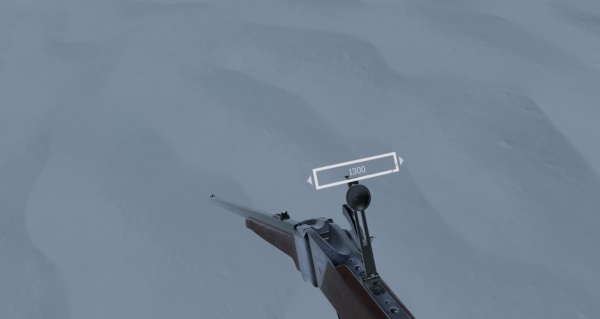
Should the standard irons prove insufficient for your purposes, the Sharps also features a stock-mounted flip-up aperture sight, adjustable out to an impressive 1,500 yards. Suffice to say, you'd have to be one impressive Sharps-shooter to make full use of it.
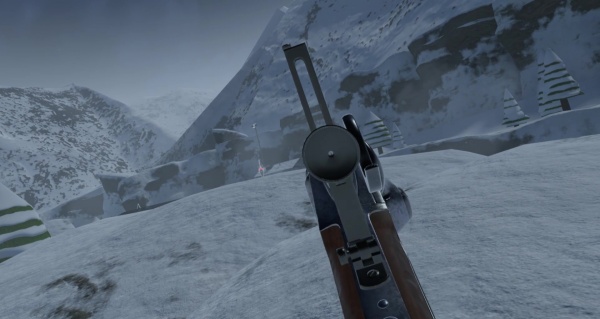
Trying to sight up an oblivious Junkbot with the aperture sight. Keyword being "trying"; while the small aperture has its uses, tracking moving targets as a relatively short distance isn't one of them.
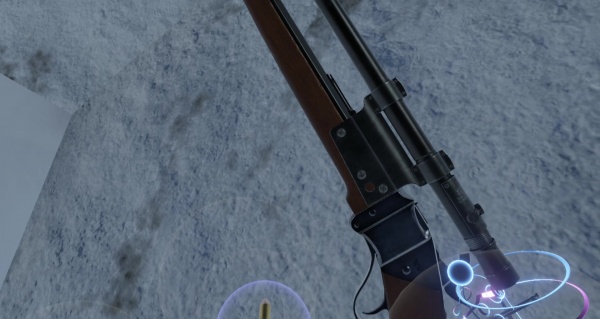
If irons aren't your cup of tea, why not try an optic? I mean, it comes with a Weaver 330 scope for a reason.
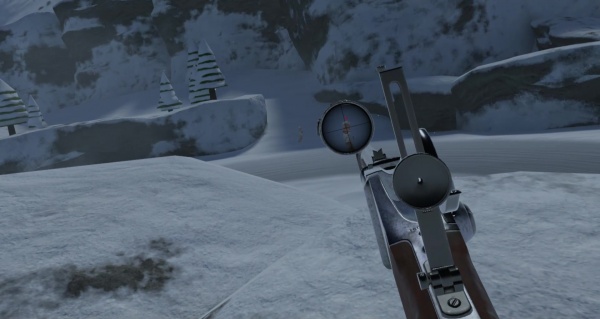
And that reason still isn't close-range combat.
SKS
The SKS is one of the available carbines in-game (added through Update #18), and is fitted with a Tapco stock and converted to use 20-round detachable magazines. With the release of Update #42, it was granted the ability to use 10-round stripper clips. Update #54 added a classic, non-Bubba'd variant of the rifle, much to the relief of milsurp purists everywhere; the addition of bayonets in the 1st alpha build of Update #76 gave the latter variant its integrated folding bayonet, bringing yet further applause.

SKS with aftermarket Tapco Intrafuse Stock System furniture - 7.62x39mm
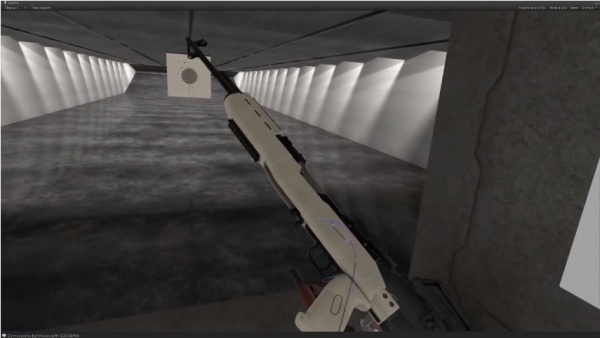
Examining the SKS. The bayonet was sacrificed to the benign Tapco gods in the sky; may they spare our milsurps the same fate.
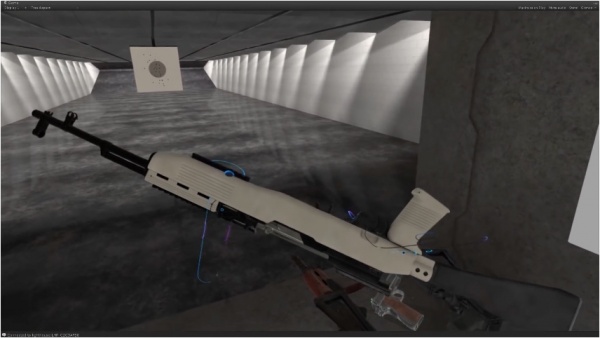
A more clear look at the rifle, which shows that it, unlike the reference image, has a solid polymer stock. Said stock is a different color than the rest of the rifle. The Tapco gods work in mysterious ways.
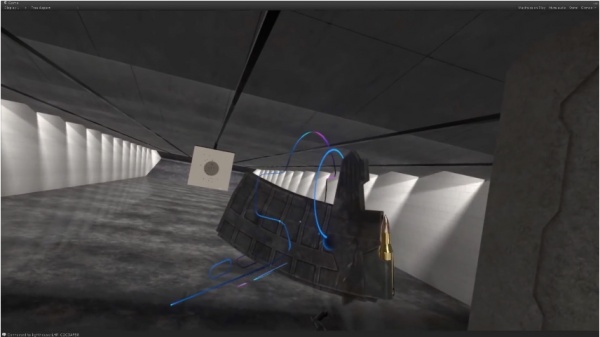
A closeup of one of the rifle's detachable 20-round magazines.
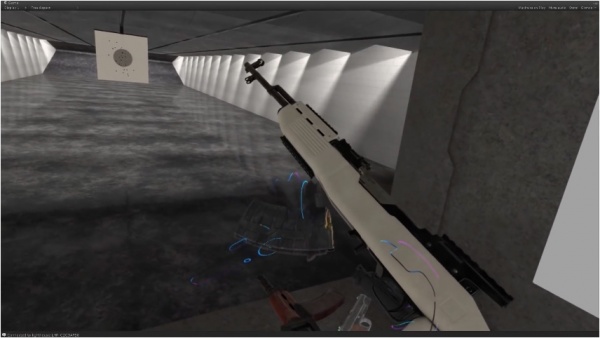
Loading in the aforementioned magazine.
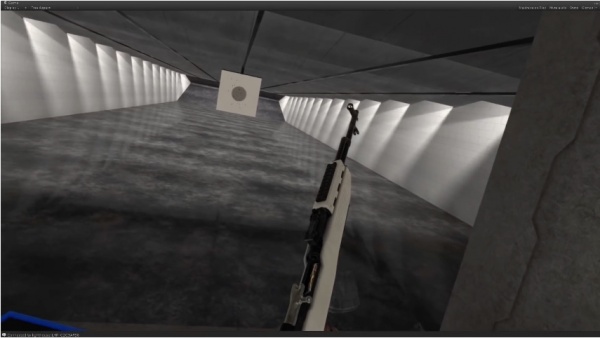
Chambering a 7.62x39mm round.
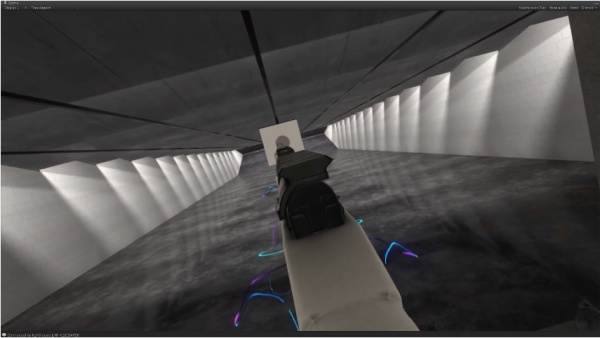
Making an effort to line up the sights...
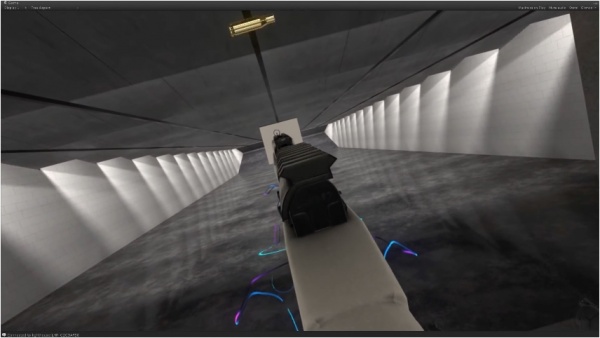
...and letting a round fly.
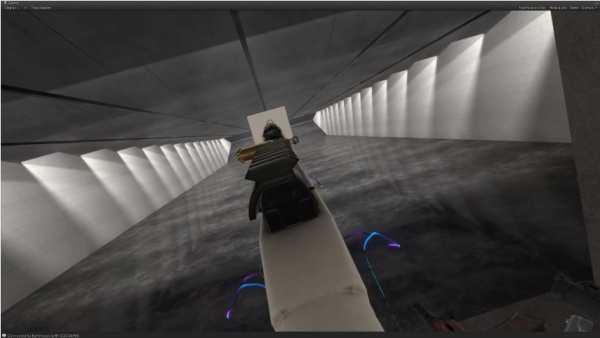
Rather amusingly, ejected casings from the SKS go straight up, and fall straight back down, often directly onto the rifle itself, as seen here.
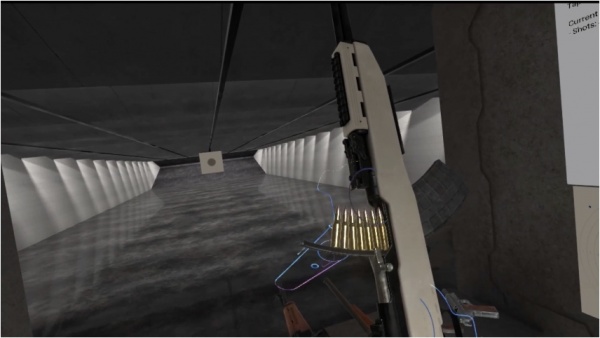
Doing something with the rifle it was actually intended to do, and reloading with a 10-round stripper clip.
Classic
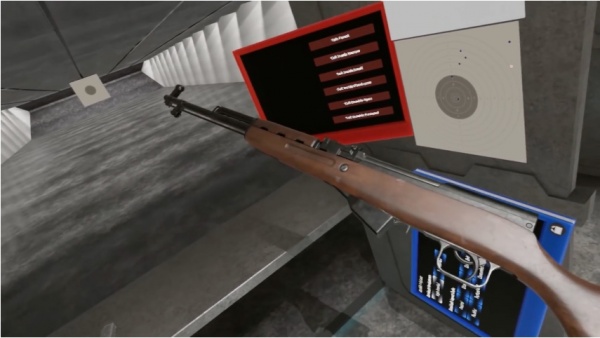
At long last, a classic, vanilla SKS for all of us to enjoy.
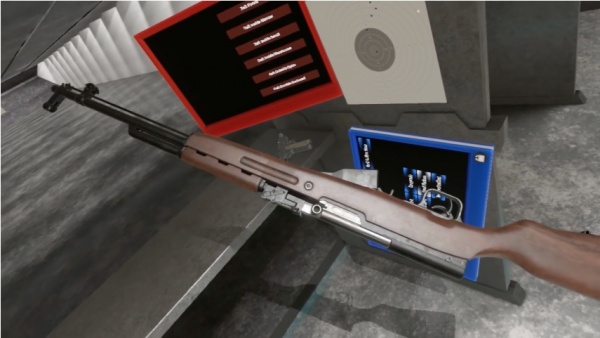
Some might say that vanilla is bland, but at least it tastes better than plastic.
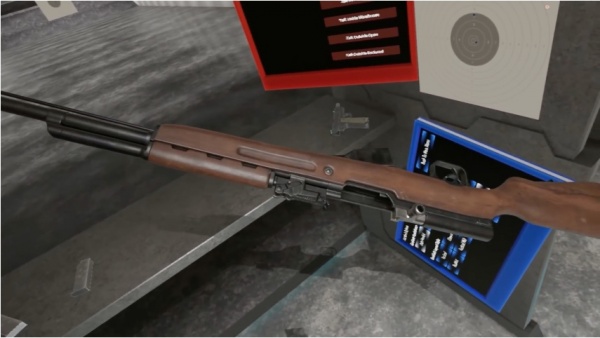
Locking open the rifle's bolt...
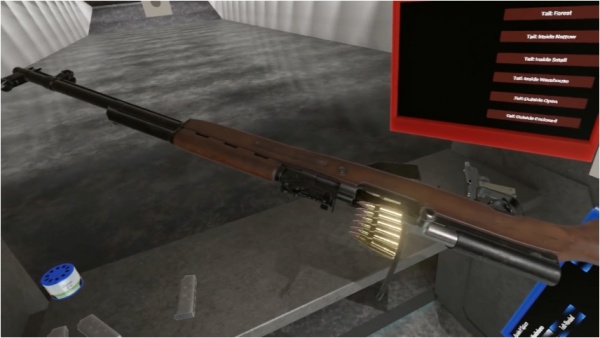
...pushing 10 rounds out of a stripper clip...
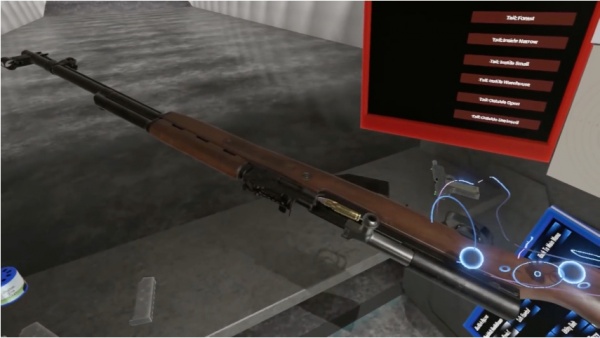
...and letting the bolt slam into battery.
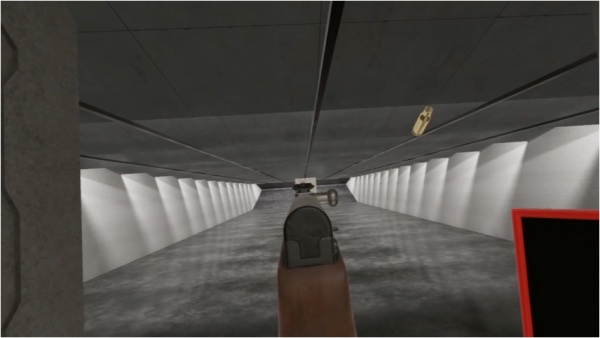
Taking a few potshots at the target.
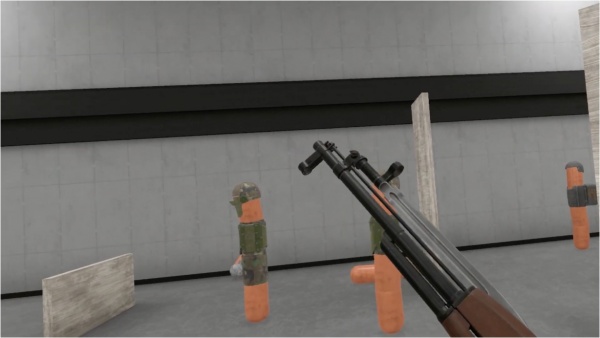
The updated SKS, folded bayonet and all. It can actually be used to slash enemies in this state...
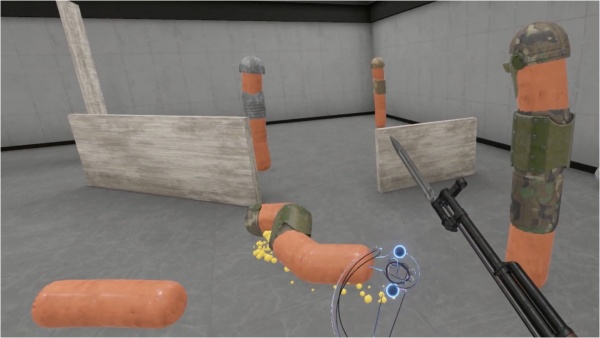
...though, as with many things, it's more useful when pointed
away from the user.
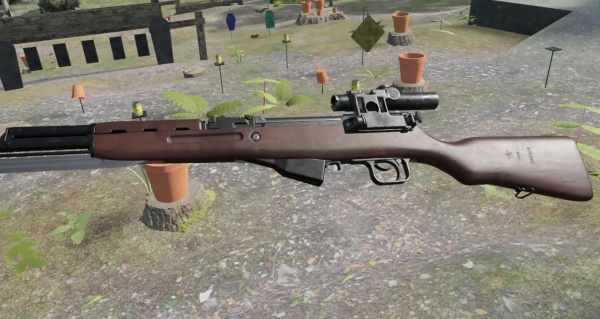
For those who want a little more range, a later update added the ability to mount the
Mosin-Nagant's PU scope on the SKS; this is a rather common modification IRL, though it was never done officially. The safety's also on, for what it's worth.
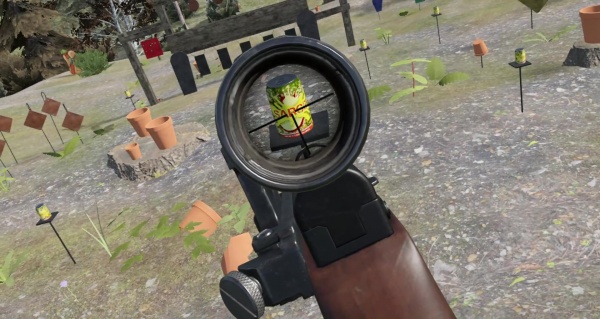
Taking full advantage of the added magnfication, and aiming at a soda can 6 feet away.
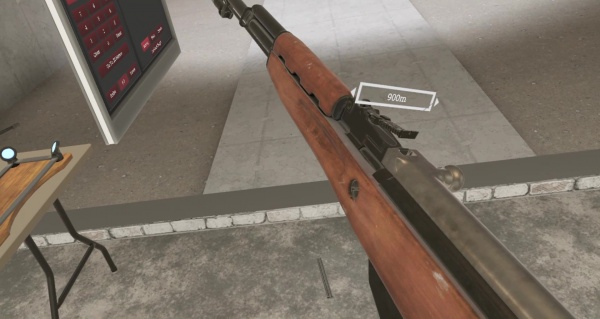
The classic SKS was another rifle that got an adjustable rear sight in Update #94; being chambered for a smaller, weaker cartridge than its 7.62x54mmR predecessors, it is "only" adjustable out to a kilometer.
Thompson Carbine
A prototype version of the M1928A1 Thompson submachine gun chambered in .30 Carbine was added to the game in the 11th alpha of Update #52. It was developed for the US Light Rifle Program (which would eventually result in the adoption of the M1 Carbine), but was near-immediately rejected for being too heavy (over 10 lbs (4.5 kg), compared to the stated maximum of 5 lbs (2.3 kg).

Experimental Thompson "Light Rifle" Carbine - .30 Carbine
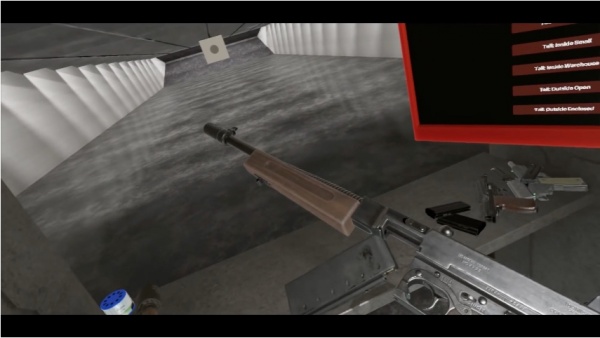
Loading a magazine into the Thompson, at an angle that is unlikely to result in anything good.

What a beautiful reject. Well, one man's trash is another man's inordinately heavy treasure.
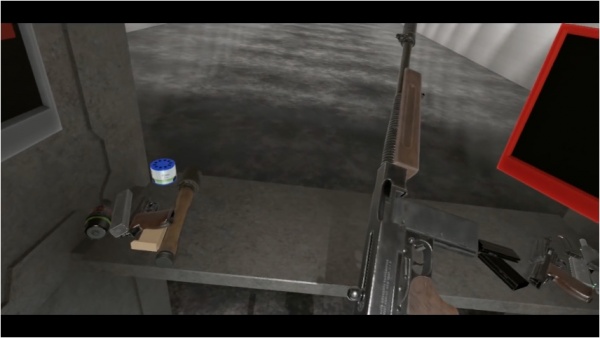
Pulling back the charging handle.
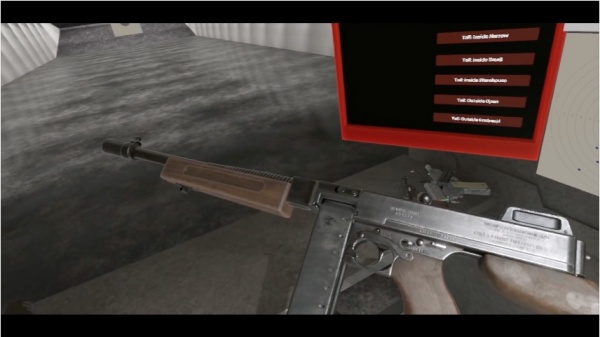
Flipping the safety to "FIRE"...
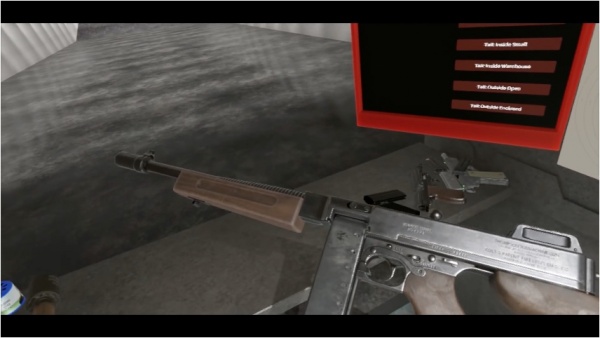
...and the selector to "FULL AUTO".
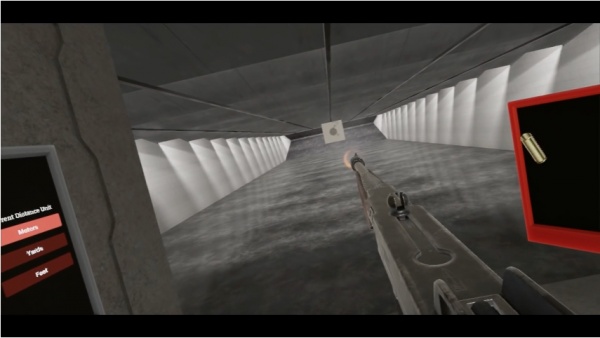
Firing the Thompson Carbine. With a high rate of fire and a 20-round magazine, it runs out of ammo pretty quickly.
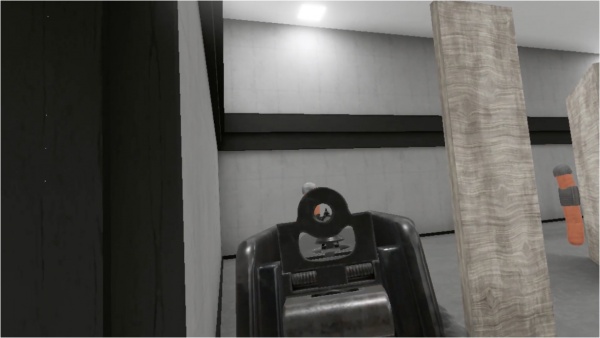
Giving the irons a try. Unlike the M1928 in-game, the Carbine's rear sight has its aperture flipped up.
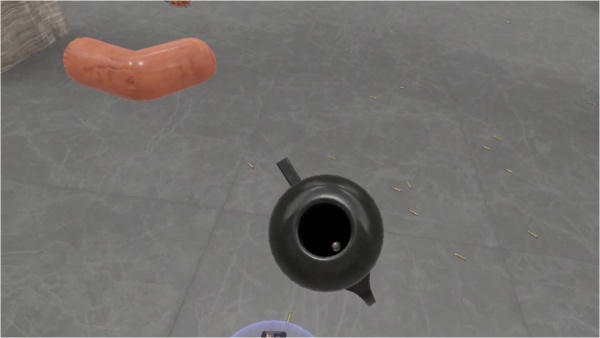
...before performing what is quite possibly the world's single most inadvisable brass check.
Winchester Model 1873
The Wurstworld update brought along a Winchester Model 1873 lever-action rifle, chambered in .45 Long Colt (a caliber not initially offered in the 1873, though it is available in modern reproductions; this does make some sense when one takes into account what Wurstworld actually is). 2 variants were initially available (a "Trapper" carbine and a longer short rifle); a "Mare's Leg" sawn-off variant was added later. All of the rifle's variants have buckhorn sights and octagonal barrels.

Winchester Model 1873 "Trapper" Carbine (Uberti reproduction) - .44-40 Winchester
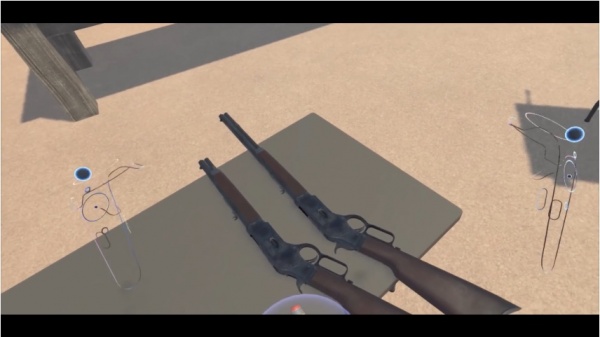
The two Winchesters, lying on a table.
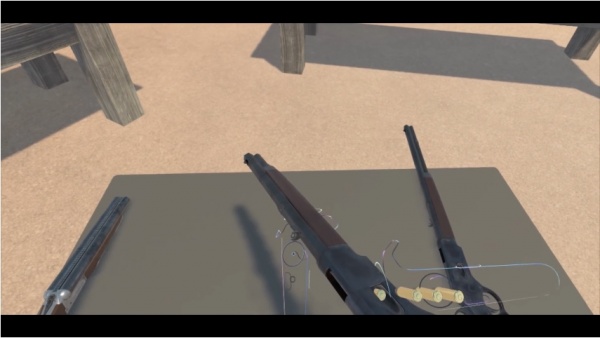
Loading in some rounds. Visible here is the game's round-palming mechanic; one can pick up multiple of the same type of round in one hand, which creates this orderly, self-advancing stack of cartridges.
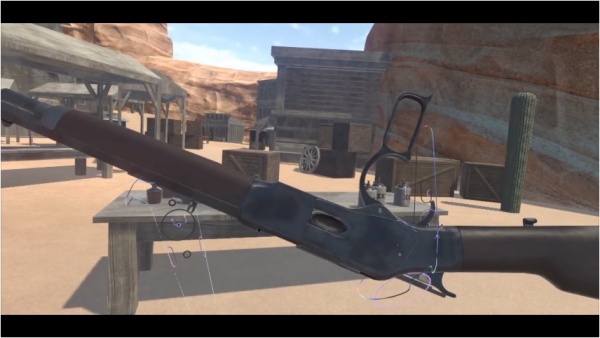
Chambering the first round in the 1873, upside-down.
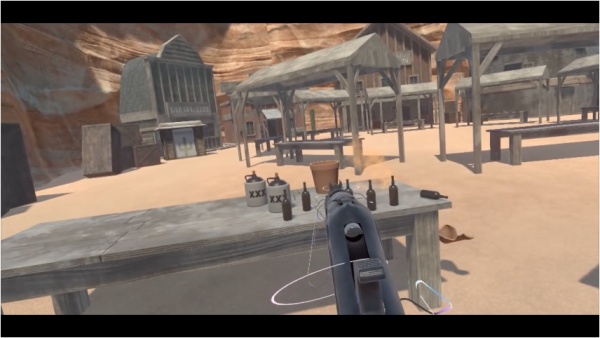
Taking aim at a clay pot, which gives a view of the rifle's buckhorn sights.
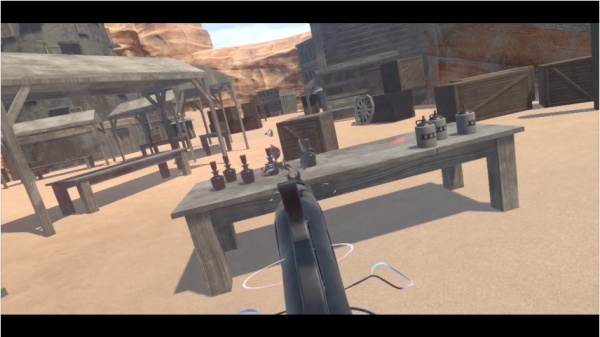
Shattering a decanter. Note the red streak to the right of the destroyed hooch-holder; this is a tracer round flying through the air. Tracer rounds are available for nearly all calibers in
H3.
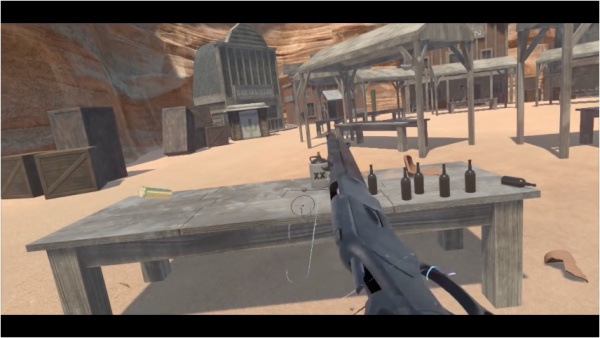
Working the rifle's action, ejecting a spent case and moving on to continue the glassacre.

Winchester Model 1873 Short Rifle - .44-40 Winchester
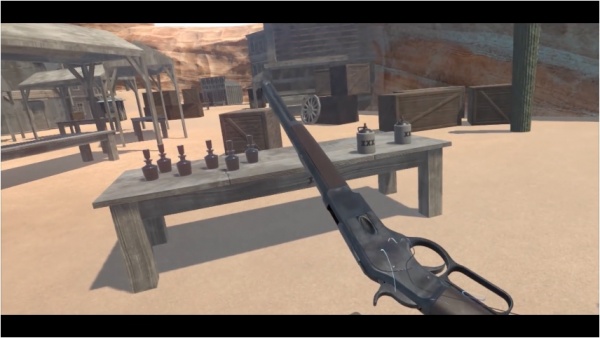
Examining the longer version of the rifle...
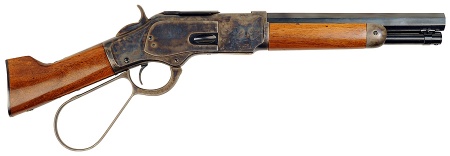
Screen-used Winchester Model 1873 "Mare's Leg" with octagonal barrel, extended lever loop, and case-hardened receiver, used in the movie
Wild Wild West.
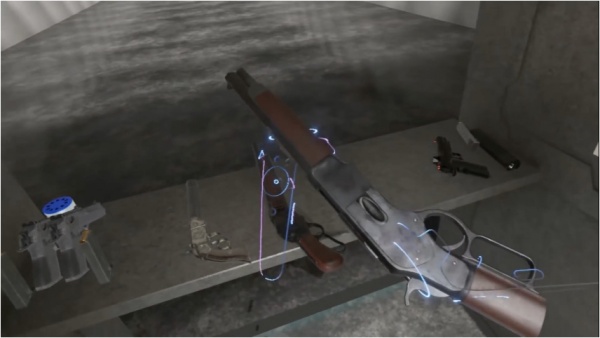
...and the shorter one, in a different place and a different time.
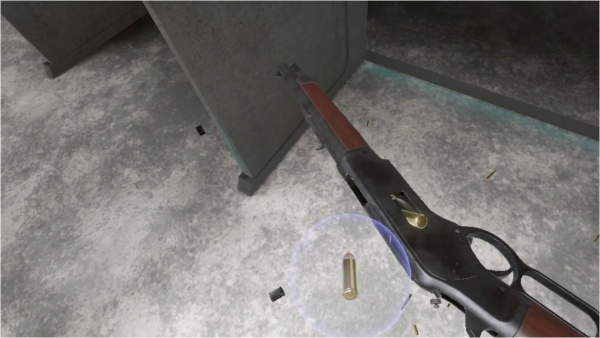
Loading the cut-off 1873; note that the loading gate is correctly shown as a separate, moving part.
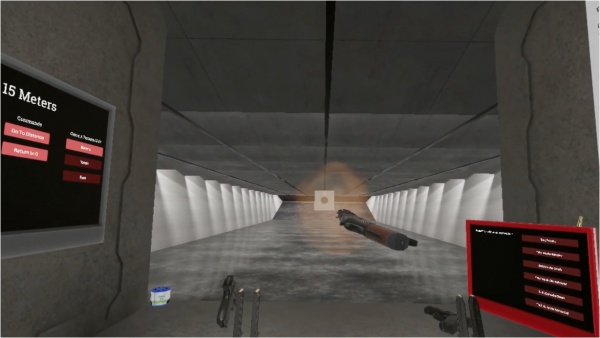
"So, when you say that you're part of a gang, do you mean, like, an inner-city street gang, or, like, a stagecoach-robbing bandit gang?"
"Yes."
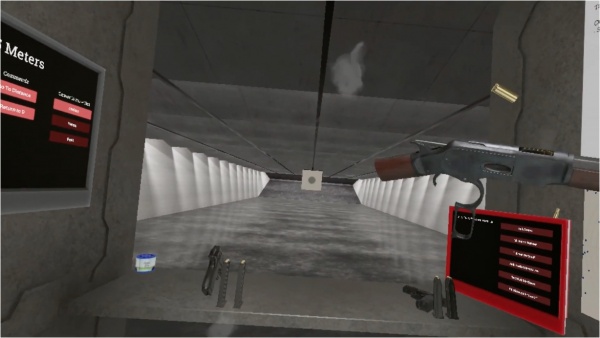
After this brief discussion comes the grand levergun tradition of breaking all your fingers - now, like the prior shooting, at a frankly absurd-looking angle.
Winchester Model 1894
The 2018 4th of July Update (Update #56) added the quintessentially American Winchester Model 1894. It has a 10-round capacity, and is chambered in .44 Magnum (one of the numerous cartridges that the 1894 has been offered in).

Winchester Model 1894 - .44 Magnum

Admiring the Winchester's receiver. A thing of true beauty, that's for sure.
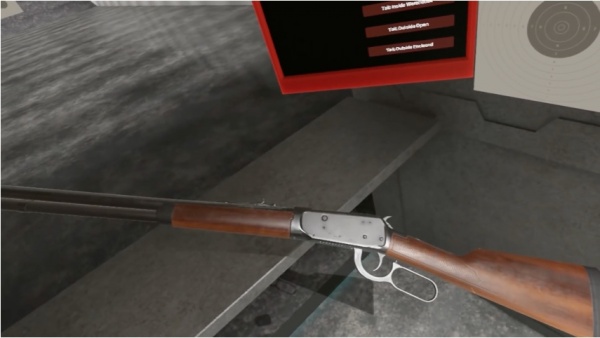
A look at the rifle's other side, which also shows off more of the stock and barrel.
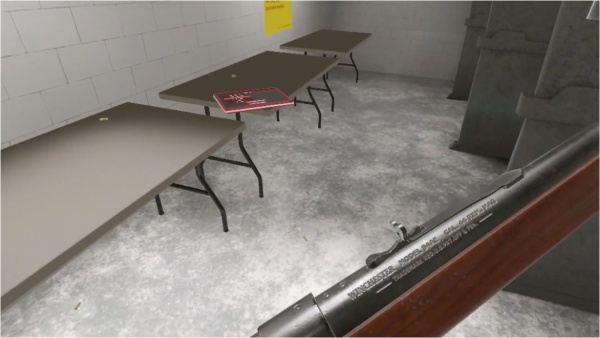
A close-up of the barrel, which shows off the rather detailed (and, interestingly enough, entirely un-obfuscated) markings; these read "WINCHESTER MODEL 94AE CAL. 44 REM. MAG" on the first line, and "TRADEMARK RED.U.S.PAT.OFF & PEN." on the second. The "AE" suffix in the model name is short for "Angle Ejecting"; this denotes that the rifle ejects upwards at an angle (rather than straight up), to allow for the use of a center-mounted scope.
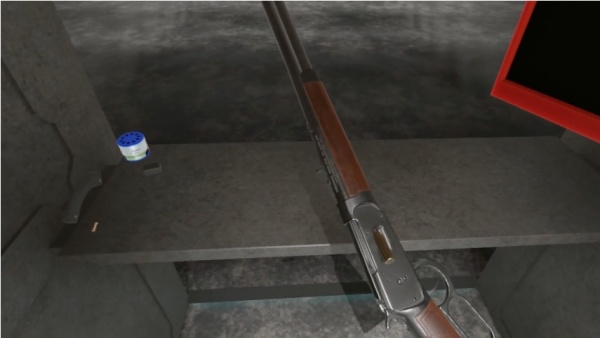
Loading in some .44 Magnum rounds.
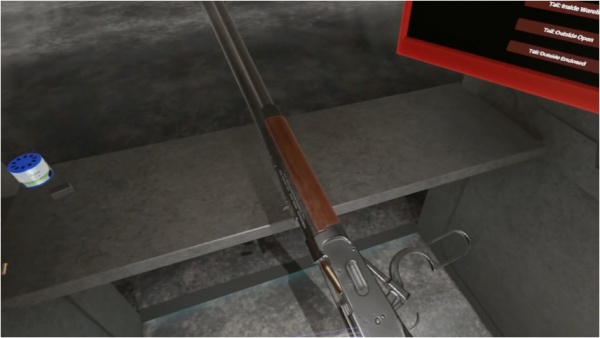
Chambering one of the aforementioned rounds. Note the pivoting baseplate of the receiver; this feature distinguishes the 1894 from the earlier
Model 1892, which was more or less externally identical, but used shorter, smaller rounds; the pivoting baseplate was John Browning's solution to the issue of getting enough action travel distance to chamber and eject longer, larger rounds while maintaining the same receiver dimensions as the 1892.
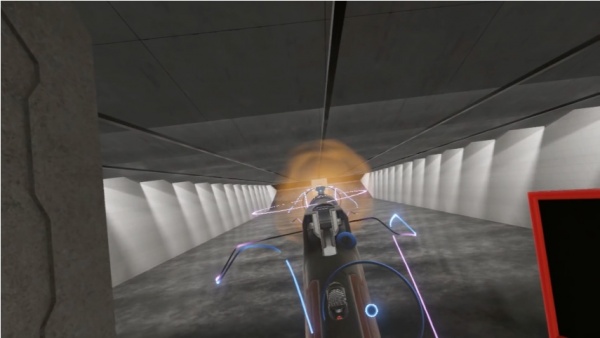
...and firing a shot, which somehow generates enough force to cause the user's controller outlines to spontaneously appear.
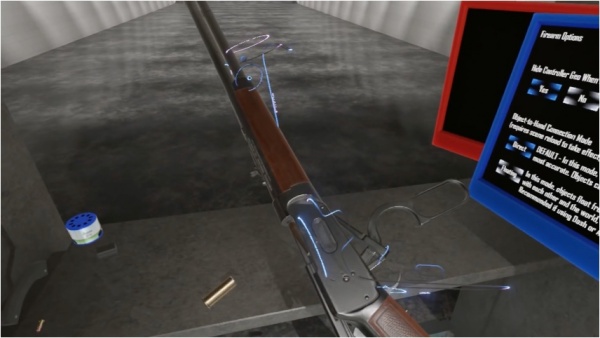
Deciding to just roll with it, USER_k0wboi ejects a spent case, and readies another round.

He then demonstrates something else interesting; y'know that whole "flip-cocking" thing that people do with cut-down lever-actions?
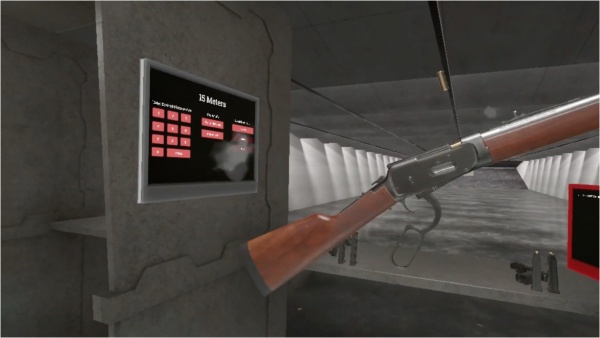
It works with full-length ones, too.
Winchester Model 70
A pre-1964 Winchester Model 70 chambered in .30-06 was added in Update #52.

Pre-1964 Winchester Model 70 w/scope - .30-06 Springfield
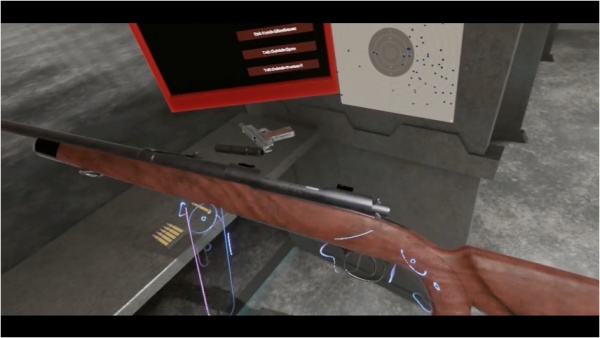
Taking a look at the left side of the Model 70...
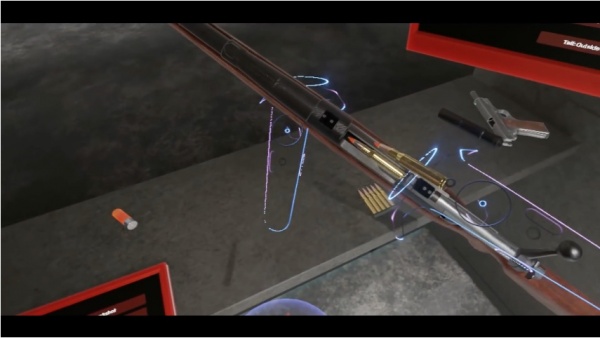
Loading in some rounds. The red tips on the rounds indicate that they are tracers.

Aiming the M70, after turning off the safety.
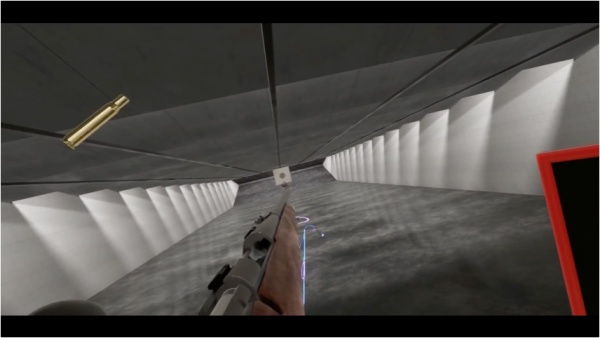
Cycling the rifle's action, and ejecting a spent case.
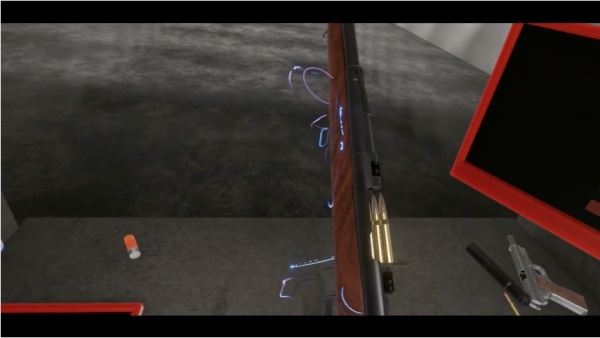
Loading the rifle again, this time with a stripper clip.
Click here to return to the main index page, or click here to view the game's sniper rifles.






















